
REFLECTIONS ON BOLITHO AND MUCH MUCH MORE!


REFLECTIONS ON BOLITHO AND MUCH MUCH MORE!
Available for up to 5 sessions per issue
Find out more or book an appointment:
• 1300 our eap (1300 687 327)
• eap@convergeinternational.com.au
• www.convergeinternational.com.au

Footy Finals Fever Dinner 14
WOOD Farewell, Justice Nettle 16
RÓISÍN ANNESLEY
The Victorian Bar Foundation 18 Student Achievement Award
GEORGIE COLEMAN
William Ah Ket Scholarship Launch 20
WILLIAM LYE
Robin Chan Memorial Grant 22
MICHELLE GORDON
High Court of Australia 24
Silk Bows (2020 and 2021)
RÓISÍN ANNESLEY
VLA/VicBar Trial Counsel 28
Development Program launch VICTORIA LEGAL AID Her Majesty Queen 30 Elizabeth the Second LINDA DESSAU On Top of the World 34 VBN Gift of the Garb 36



Victorian Bar Council 2022-23 38
Reflections from Bolitho (No. 18) 40 —Remarks to a Reader’s Course JOHN DIXON

42 Looking Down the Barrel—SCOTUS Revisits The Second Amendment
LACHLAN ARMSTRONG
47 Scholarship for the Legal Community
LUCY LINE
48 Civil and Criminal Intensive Advocacy Skills Training Workshop
SAMUEL BURT, PETER O’FARRELL AND MAYA ROZNER
50 The Victorian Law Reform Commission Stalking Report VLRC
52 Drunken Sex, Misread Signals May End Up In Court: Defence Lawyers Warn DAVID HALLOWES, SHAUN GINSBOURG AND ABBIE ROODENBURG
Bar Lore
54 The Great “J. L.” Some Notes on the Life of James Liddell Purves QC MATTHEW HARVEY
58 Reminiscences Relating to Participants in the Trial and Others Mentioned (to the Best of My Recollection) ANDREW KIRKHAM
Back of the Lift
60 Silence All Stand
63 Vale
72 New Silks 2022 Q&A Boilerplate
79 A Bit About Words
JULIAN BURNSIDE
81 Language Matters
PETER GRAY
83 Red Bag - Blue Bag
85 Music Review
ED HEEREY
90 Book Reviews
92 The Eternal Return
NICK GREEN
Editors: Janine Gleeson, Alexandra Golding, Nico Burmeister.
VBN Committee: Janine Gleeson, Alexandra Golding, Nico Burmeister, Andrew Broadfoot KC, Justin Castelan, Paul Adami, Stephen Warne, Dominic Triaca, Amy Wood, Harry Forrester, Joel Silver, Jesse Rudd, Veronica Holt, Joseph McGregor (May-Oct) Denise Bennett.
Contributors (in alphabetical order): Michela Agnoletti, Romauld Andrew SC, Róisín Annesley KC, Haley Aprile, Lachlan Armstrong KC, Damian Austin, Melanie Baker SC, James Barber SC, Elizabeth Boros SC, Lauren Bull, Julian Burnside AO KC, Samuel Burt, Maria Cananzi, The Hon Justice Tony Cavanough, Georgie Coleman, Mark Costello SC, Ella Crotty, The Hon Linda Dessau AC, Albert Dinelli SC, The Hon Justice John Dixon, William Edwards SC, Tom Ellicott, The Hon Justice James Elliott, Shaun Ginsbourg, Janine Gleeson, Christopher Glerum, Olivia (Olive) Go, Alexandra Golding, The Hon Justice Michelle Gordon AC, Frances Gordon SC, Yanni Goutzamanis, The Hon Peter Gray AM, Nicholas Green KC, Jason Gullaci SC, David Hallowes SC, Chris Hanson, Matthew Harvey KC, Sam Hay KC, The Hon Kenneth Hayne AC KC, Ed Heerey KC, Ruby Heffernan, Matthew Hooper, Ian Horak SC, Christian Juebner SC, Roslyn Kaye SC, Rebecca Kelly, Jack Kelly, Simone Kipen, Andrew Kirkham AM RFD KC, Jonathan Kirkwood SC, Kalia Laycock-Walsh, Lucy Line, William Lye OAM KC, Eleanor Mallett SC, Alison Martyn, Zoe Maud SC, Andrew Meagher, Carl Moller SC, Trevor Monti KC, His Honour Judge Gerard Mullaly, Declan Murphy, Elodie Nadon, Owen Nanlohy, Emrys Nekvapil SC, Peter O’Farrell, Maria Pilipasidis SC, Christine Pollard, John Riordan, Marcus Roberts, Abbie Roodenburg, Sam Rosewarne SC, Raelene Sharp SC, Charles Shaw KC, Gavin Silbert KC, Natalie Simpson, Craig Smith SC, Geoffrey Steward, Tom Storey, Robyn Sweet SC, Melanie Szydzik SC, Eugene Twomey, Victorian Law Reform Commission, Victoria Legal Aid, Dr Michael Wolff, Amy Wood, Campbell L. Woollacott.
Photography/Images (in alphabetical order): Peter Bongiorno, Irene Dowdy, Dr Michael Wolff, Amy Wood, Naomi Woodley.
Publisher: Victorian Bar Inc., Level 5, Owen Dixon Chambers East, 205 William St, Melbourne, VIC 3000.
Registration No: A 0034304 S
The publication of Victorian Bar News may be cited as (2022) 172 B.N. Opinions expressed are not necessarily those of the Bar Council or the Victorian Bar or of any person other than the author.
Advertising: All enquiries, including requests for advertising rates, to be sent to:
Róisín Ryan, Victorian Bar Inc., Level 5, Owen Dixon Chambers East, 205 William St, Melbourne, VIC 3000. Tel: (03) 9225 7111
Email: roisin.ryan@vicbar.com.au
Illustrations, design and production: Guy Shield – guyshield.com
Printed by: Southern Impact – southernimpact.com.au
Contributions: Victorian Bar News welcomes contributions to vbneditors@vicbar.com.au
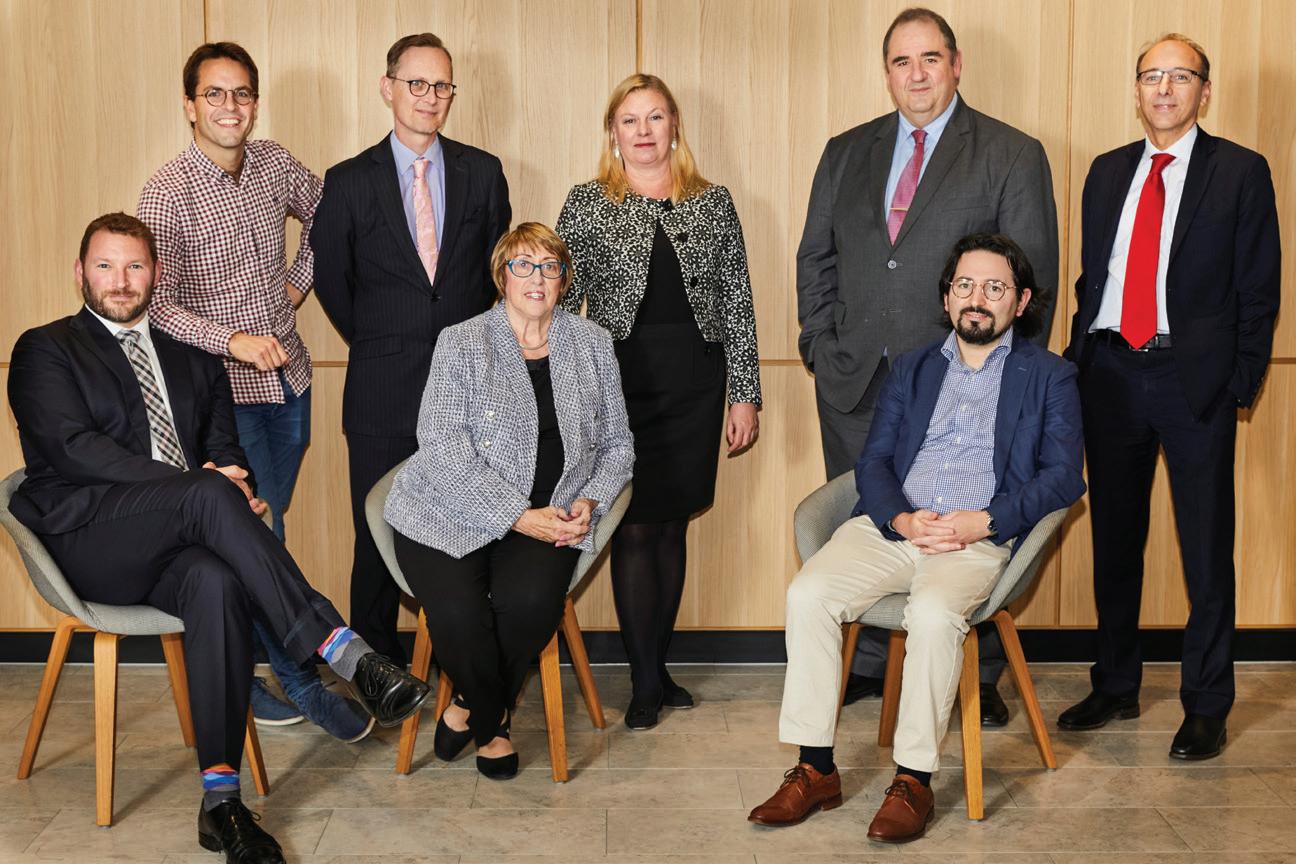
JANINE GLEESON, ALEXANDRA GOLDING AND NICO BURMEISTER
When last we wrote, we wrote with optimism. There had been a gradual loosening in the restrictions associated with the pandemic. With that loosening, there was hope that we would continue to return to chambers and to the courtroom.
To a great degree, our optimism was not misplaced. Restrictions on freedoms have now been wound back almost entirely. Management of the ongoing risks associated with the pandemic has been handed back to each of us. With this freedom, logic would suggest that chambers and the courts will soon reflect the energy and vitality that previously signified our Bar.
Much of this edition reflects the renewed “normalcy” enabled by the resumption of the basic liberties of movement and association. The pages of this edition, like the last, are replete with photos and stories of events in and around our Bar (none of which, mercifully, took place via Zoom, Teams, WebEx or the like).
But, as Heraclitus first observed, change is the only constant. There was no greater symbolic reminder of change than that occasioned by the death of the late Queen. In an instant, postnominals and language—used instinctively since law school— changed. The cognitive dissonance will likely be a one-off: it is highly unlikely that anyone reading this will in their lifetime witness a change back to “QC”. The immediacy of the transition
to “KC” was presaged by Simon Steward QC’s (as his Honour then was) and Eddy Gisonda’s fascinating article in VBN 168
More recently, the guard of the Bar Council changed once more, with Sam Hay KC elected President. We are sure we speak for the entire Bar in wishing him well, and in thanking Róisín Annesley KC for her tireless service during her presidency.
As is the case in each Summer edition of Victorian Bar News, we have the pleasure of introducing those who have recently been
The cognitive dissonance will likely be a one-off: it is highly unlikely that anyone reading this will in their lifetime witness a change back to “QC”.
called to the Inner Bar (many of whom will likely soon take the post-nominal “KC”). Each new silk took time out from their celebrations to share a few things about themselves, which we have published. We hope you find them as insightful as we did.
And again, at the other end of the journey, we are privileged to
introduce the newest generation of members. "Readers Digest" returns, with each new reader offered the opportunity to introduce themself. Not all of them took us up, but we hope the answers from those who did will stimulate conversation when you see them in chambers and around the courts.
Like a terminal illness, which can go into remission only to return with devastating consequences, judicial bullying is occasionally dormant, but never ceases to repeatedly rear its very ugly head. It is not known whether it has contributed to its victims taking their own lives, or if so, how many have tragically succumbed to such egregious conduct.
Anecdotally it is clear that some have left the profession because of it and too many to mention have been traumatised and humiliated because of it, culminating at the very least in some questioning themselves as to whether they have the ability to adequately appear on behalf of their clients.
It is sickening conduct and has no place in our profession. Indeed, the recidivist offenders are not fit for judicial office.
That so few are prepared to report this sort of behaviour is paradoxically, both understandable and bewildering.
Victims need to know that they will be listened to, their complaints will be taken seriously, and action will follow. They certainly will not be left adrift by their colleagues should they make a complaint; more likely ‘hero’ status will have afforded them and woe-betide any judicial officer who treats them badly because of making a complaint.
Let us not delude ourselves, judicial bullying and intimidation occurs in every jurisdiction from top to bottom—to the experienced, to the inexperienced and to all genders, albeit that young women are disproportionately represented as all too regular victims.
In almost any other workplace, proof of such conduct having been established, would inevitably result in a perpetrator being sanctioned.
Such are the double standards that are gleefully adopted in these regrettable times.
The incidence of such behaviour is sufficiently common and grave, that it is incumbent on the powers that be to take steps to ameliorate this blot on the justice system.
It would be a controversial measure to subject potential judicial officers to serious psychological assessment as to their suitability for appointment, but it is not that the time has now come for such a process to be implemented, it should have been implemented, years earlier.
To those who might find such a process unbecoming, unnecessary or even belittling, I opine that it is not even a remotely important consideration as it pales into appropriate insignificance when compared to the harm, those unsuited to judicial office cause to those who are just trying to do their job in a safe workplace environment, to which they are entitled.
Geoffrey Steward, Gorman Chambers
Victorian Bar News encourages letters to the Editors on topics ranging from the meaningful to the mundane. Write to the Editors at Victorian Bar News, Owen Dixon Chambers, 222 William Street, Melbourne, VIC 3000 or email vbneditors@vicbar.com.au
SAM HAY
The 2022-2023 Bar Council term promises to be busy. There are several matters coming up in the next 12 months, but I thought I might take this chance to say something about two of the most important.
As most members will know, the Bar’s IT infrastructure – which includes our website, our membership database, and our various ‘add on’ portals – is significantly out of date and in urgent need of replacement. Previous Bar Councils started the process of determining the best way to update our IT system to meet our current and future needs. They put together a steering group, ably led by Michael Shand AM KC, to tackle the problem and come up with a solution.
The steering group has done a power of work; a preferred provider has now been identified, and a very detailed schedule of works has been prepared. The current Bar Council will have to make the final decision on the project, and once it is underway, ensure its success by closely monitoring its progress. We will keep members updated with developments. Members can rest assured that we will seek out the most suitable product for the best available price. It is a critical project, and we will do our very best to get it right.
Thanks to the excellent work of the BCL team, led by its CEO Paul Clark,

and the BCL Board. Initially led by John Karkar KC (and now by the Honourable John Digby KC), BCL has successfully navigated the COVID-19 pandemic’s many serious challenges. The long-term viability of BCL is critical to maintaining the unique, inclusive culture we enjoy at the
Victorian Bar. In my view, our culture is unlike those of other Bars around the nation. I think it is the reason we attract talented readers from all over the country – they come to Victoria because the barriers to entry are comparatively lower than other Bars. On an individual level, the risks of
hanging out your shingle and starting out on a career as an independent advocate are much lower when a month-to-month tenancy is on offer. Along with our Readers’ Course, which has a structure and format designed to foster career-long bonds between colleagues, BCL’s generous offering forms a very big part of the reason our members become bound together in a way that simply does not occur elsewhere to the same extent.
Despite BCL having come through the pandemic, there remain several challenges still to be addressed. As outlined in the recently published annual report, the amount of unpaid rent on its books has significantly increased. It will be obvious to members that to ensure the ongoing sustainability of BCL, is it necessary to confront its rising level of debt. It will, of course be dealt with sensitively, and in close consultation
with the Bar Council, but it must be addressed in the coming year.
BCL is also developing its mediumto-long-term property strategy. It must ensure that it serves the needs of Victorian barristers now and into the future. This work has already started, and will gain momentum in the coming year. We will keep members updated as things progress.
The last few Bar Council elections have been – by the Bar’s usual standards – hotly contested and occasionally contentious. My sense is that some divisions have developed. That is not the end of the world, but I think we should both acknowledge and reflect upon it.
Thinking about this topic brings me back to some fundamentals. Our college is strong. It promotes
debate – sometimes very vigorous debate – and it celebrates independent thought and action. We have all learned lessons from the events of the last few years; I know I certainly have. I will draw upon the lessons I have learnt in the coming 12 months, and I would like all our members to know that I intend to lead Bar Council in a consultative, collaborative, and steady way. There are 21 members of Bar Council, and each has positive contributions to make to our Bar’s governance.
Finally, on behalf of the Bar Council, I wish everyone – members, the VicBar team and the BCL team –a safe and enjoyable summer break. If you can, take the time to recharge and reset. January is an ideal time to unplug.
I look forward to seeing everyone around chambers and in the courts in 2023.


What was your dream job (when you were seven)?
Olympic swimmer. What was your first job?
Scrubbing trays and serving scrolls at Baker’s Delight. Which law school did you attend?

Queensland University of Technology and University of Queensland.
With whom will you read? Jeremy Masters.
Whom would you cast to play you in the movie of your life?
I would want Florence Pugh though the movie would probably be This is 40

What was your dream job (when you were seven)?
Singer (I was often found singing in to a hairbrush or the end of an extension cord as my 'microphone'). What was your first job? Crew member at McDonald's.
Which law school did you attend?
Monash.
With whom will you read?
Christian Juebner. Whom would you cast to play you in the movie of your life?
Australian actress Jane Harber (wishful thinking!).
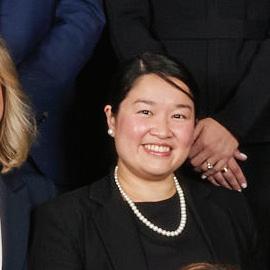
What was your dream job (when you were seven)?
Lawyer. (Boring, I know!)
What was your first job? Tutor.
Which law school did you attend?
University of Adelaide; University of London.
With whom will you read?
Shaun Ginsbourg. Whom would you cast to play you in the movie of your life?
Sir Daniel Day-Lewis. (Cause he’s just that good.)
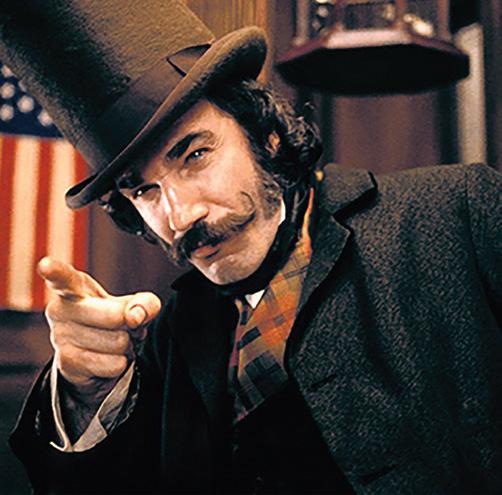
Each edition, we reach out to the latest cohort of readers to get to know them better.

What was your dream job (when you were seven)?
Vet—I loved animals. Then I discovered I hated science.
What was your first job?
Vintage Cellars. Working at a bottleshop made you pretty popular at uni. Which law school did you attend?
Melbourne Uni & Leiden University.
With whom will you read?
Michael Stanton. Whom would you cast to play you in the movie of your life?
Jim Carrey (the younger version— I hope).


What was your dream job (when you were seven)?
An equine vet. What was your first job? Babysitting. Which law school did you attend?
Monash University. With whom will you read?
Andrew Barraclough. Whom would you cast to play you in the movie of your life?
Someone who is comfortable being around horses...lots of horses, and all the time.

What was your dream job (when you were seven)?
Architect.
What was your first job? Tutor.
Which law school did you attend?
Monash University.
With whom will you read?
Belle Lane, Minal Vohra SC. Whom would you cast to play you in the movie of your life?
Cate Blanchett.
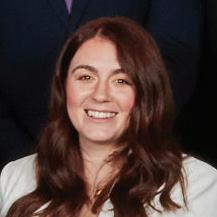
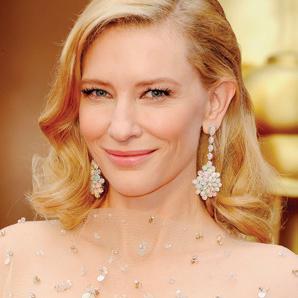
What was your dream job (when you were seven)?
Famous actress/singer. What was your first job?
Pizza Hut.
Which law school did you attend?
University of South Australia.
With whom will you read?
Ruth Champion. Whom would you cast to play you in the movie of your life?
Rachel McAdams.

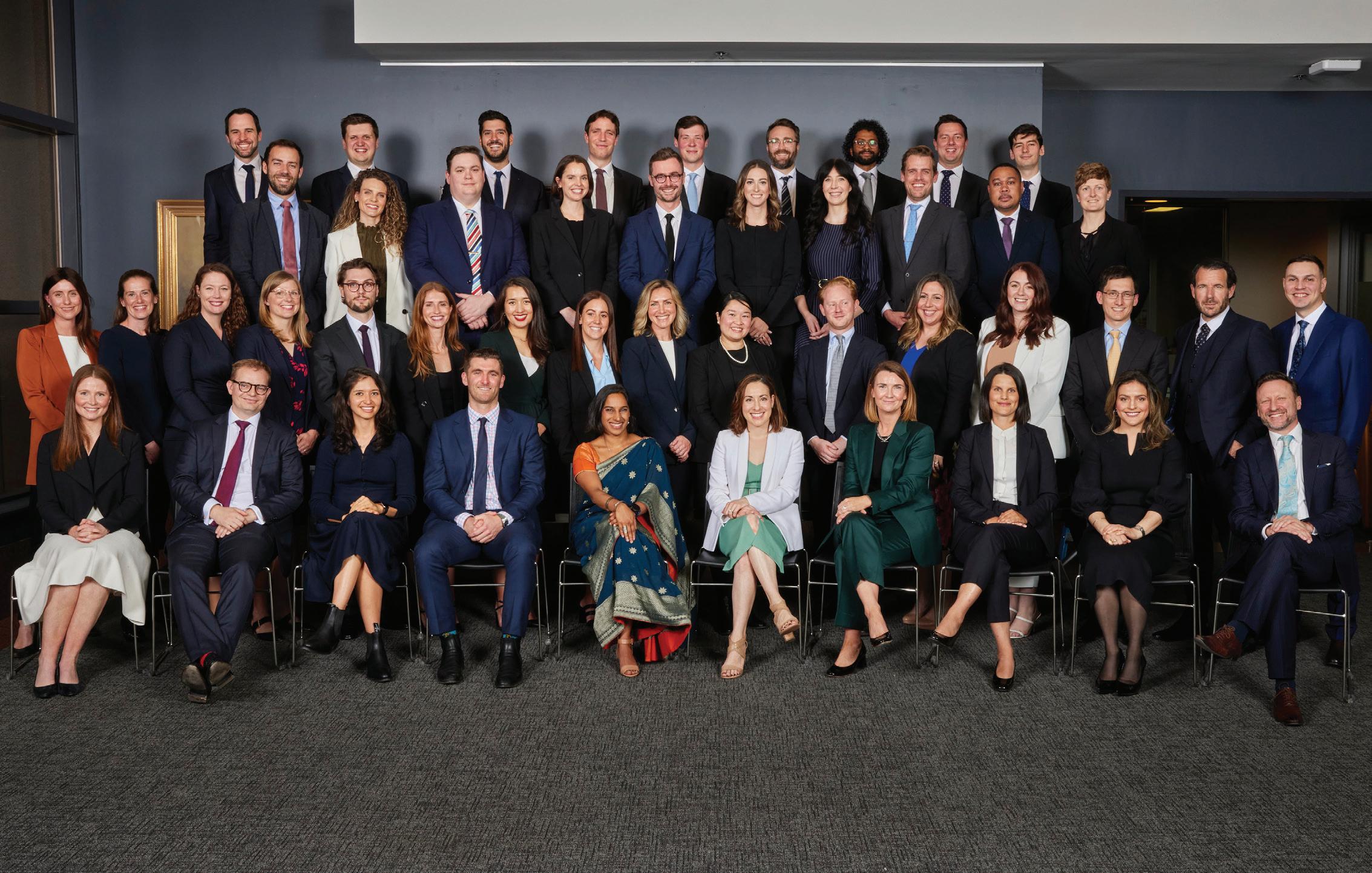

What was your dream job (when you were seven)?
Architect. What was your first job?
Supermarket checkout. Which law school did you attend? UNSW.
With whom will you read? Barnaby Chessell. Whom would you cast to play you in the movie of your life? Ryan Gosling.

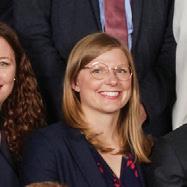
What was your dream job (when you were seven)?
A lawyer (not very creative, I know).
What was your first job?
Subway Sandwich Artist. Which law school did you attend? Melbourne. With whom will you read? Fiona Batten. Whom would you cast to play you in the movie of your life?
Dumbo? This is not a sledge on myself, I just have an obsession with elephants.


What was your dream job (when you were seven)?
An inventor of some sort. What was your first job? Odd jobs in my dad’s stationery shop. Which law school did you attend? Victoria University. With whom will you read? Chris Farrington. Whom would you cast to play you in the movie of your life?
James Spader.

What was your dream job (when you were seven)?
Captain of the St Kilda Football Club.
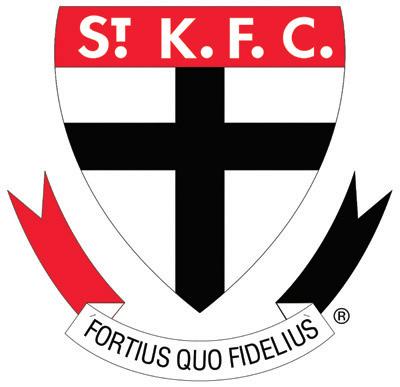
What was your first job?
Waiter, Taco Bill Restaurant. Which law school did you attend?
Deakin University. With whom will you read? Conor O’Sullivan. Whom would you cast to play you in the movie of your life? Matthew McConaughey.

Yanni Goutzamanis
What was your dream job (when you were seven)?
Novelist.
What was your first job?
Working at IKEA (in the trolley department!).
Which law school did you attend?
Monash University; University of Oxford.
With whom will you read?
Tamieka Spencer Bruce. Whom would you cast to play you in the movie of your life?
David Tennant.
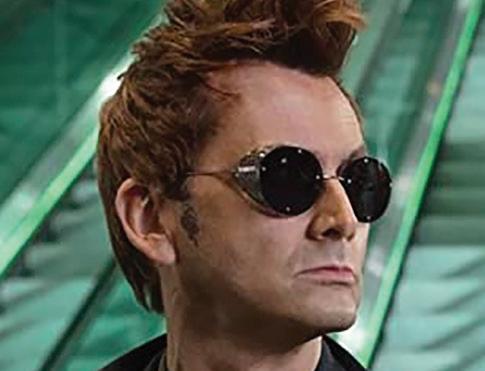

What was your dream job (when you were seven)?
Firefighter.
What was your first job?
Baker’s Delight. Which law school did you attend?
Monash.
With whom will you read?
Caryn van Proctor. Whom would you cast to play you in the movie of your life?
Jennifer Lawrence.

What was your dream job (when you were seven)?
Replacing Dennis
Berkgamp as No. 10 for Arsenal FC.
What was your first job? Pizza maker at Pizza Haven.
Which law school did you attend?
The University of Oxford.
With whom will you read?
Jonathan Kirkwood. Whom would you cast to play you in the movie of your life?
Emma Thompson.

What was your dream job (when you were seven)?
To work with the dolphins at SeaWorld.
What was your first job?
An assistant at a photography shop. Which law school did you attend?
La Trobe University.
With whom will you read?
Richard Stanley. Whom would you cast to play you in the movie of your life?
Keri Russell from her ‘Felicity’ days.

What was your dream job (when you were seven)?
Lawyer (tragically).
What was your first job?
Hot dog seller at Melbourne Zoo.
Which law school did you attend?
Monash University. With whom will you read?
Siobhan Kelly. Whom would you cast to play you in the movie of your life?
Michael Cera.

What was your dream job (when you were seven)?
Ballerina.
What was your first job?
Shop assistant at my big sister’s lolly shop. Yes, I was paid in lollies. Which law school did you attend?
RMIT.
With whom will you read?
Markorius Habib.
Whom would you cast to play you in the movie of your life?
The late, great, Betty White.

What was your dream job (when you were seven)?
Scientist.
What was your first job?
Assistant Brand Manager— Gilette.
Which law school did you attend?
Melbourne Law School.
With whom will you read?
Mark Costello SC. Whom would you cast to play you in the movie of your life?
Daniel Radcliffe.

What was your dream job (when you were seven)?
Circus performer.
What was your first job?
Staff member in the deli at the local IGA. Which law school did you attend?
University of Melbourne; University of Oxford
With whom will you read?
Kateena O’Gorman. Whom would you cast to play you in the movie of your life?
Maisie Williams.

What was your dream job (when you
were seven)?
Doctor.
What was your first job?
Grill’d.
Which law school did you attend?
Monash University.
With whom will you read?
Simon Pitt.
Whom would you cast to play you in the movie of your life?
Anne Hathaway.

What was your dream job (when you were seven)?
Palaeontologist.
What was your first job?
Tour guide.
Which law school did you attend?
Melbourne.
With whom will you read?
Andrew Imrie.

Whom would you cast to play you in the movie of your life?
Olivia Munn.

What was your dream job (when you were seven)?
AFL footballer.
What was your first job?
Swimming coach.
Which law school did you attend?
Monash University.
With whom will you read?
Sarah Keating.
Whom would you cast to play you in the movie of your life?
Miles Teller.
Realestate.com Pty Ltd v Hardingham & Ors
MR COBDEN SC: Mr Hardingham at the REA terms—to the extent he knows them, or to the extent that RPD put up something that was very like them, and what he sees there is, no, they cannot, they do not—REA cannot get those rights because I have not given them to the agencies. We learn that deep notion of nemo dat qui non habet probably as early as kindergarten: you just cannot give something which is not yours to give.
STEWARD J: You went to a sophisticated kindergarten.
MR COBDEN SC: Well—you know, you cannot keep that toy, it is not yours, give it back to the person—whatever, your Honour, bad illustration.
Michel Luk-Tung v Keolis Downer Pty Ltd
MR PAUL B JENS QC Yes. So you’ve been off the tools for 24 years?
WITNESS M’hmm. At work. Not at home. I’ve built a few decks between then.
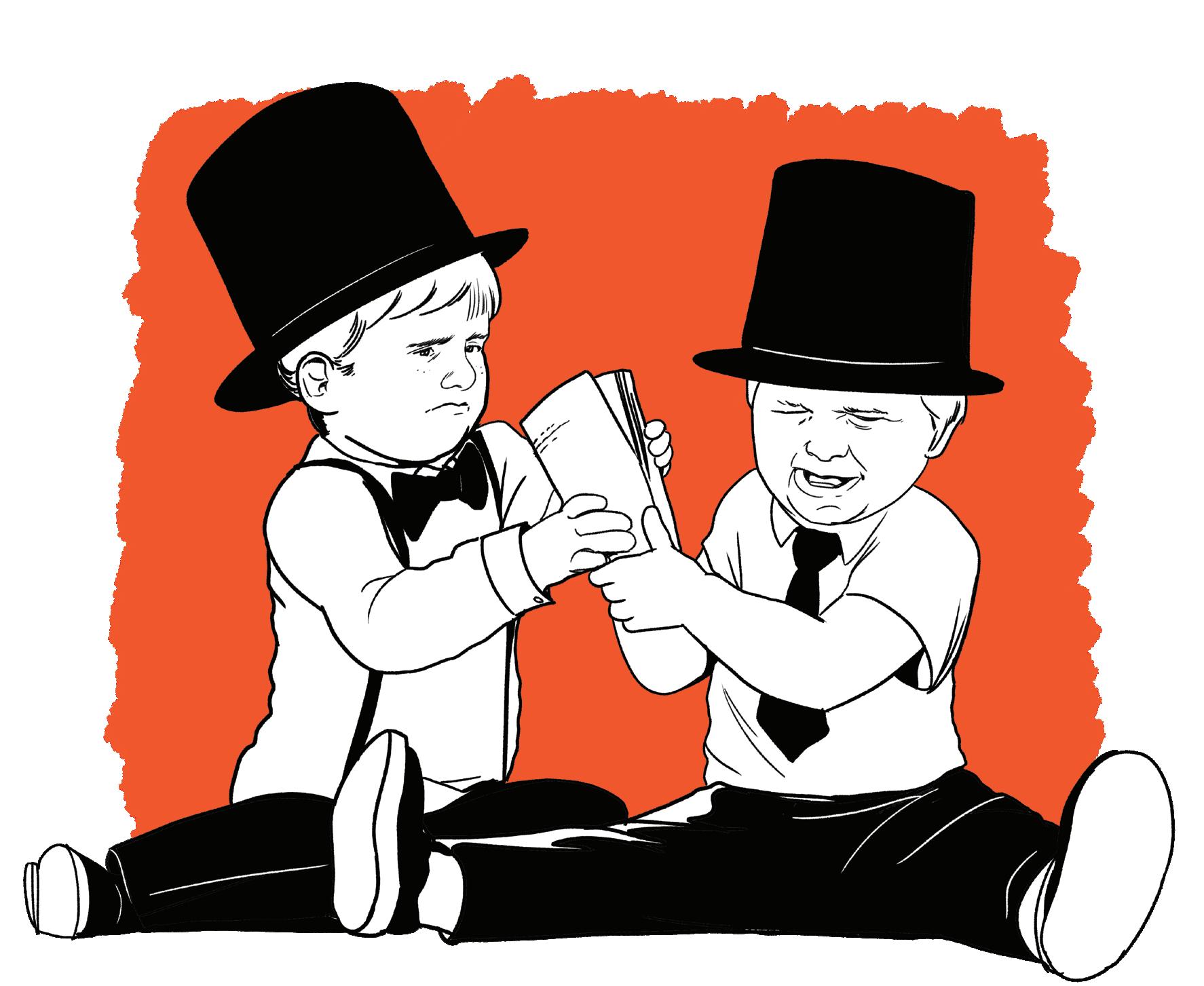
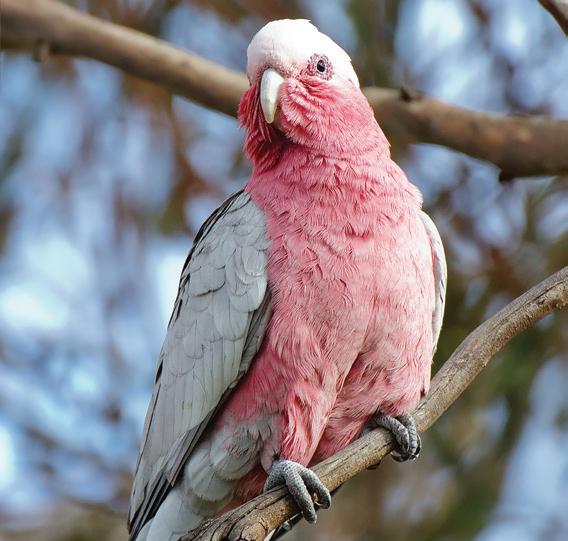
Trevor Monti and her Honour Judge Bourke Counsel: T Monti KC appearing on Zoom from his farm when his pet galah landed on his head.
HER HONOUR:
Which one is the Galah?
MR MONTI KC: The one on my head, his name is Ned!
MR PAUL B JENS QC So you’re sort of a desk man, is it?
WITNESS No. A union official’s job is far from a desk man. Johnny on the
MR PAUL B JENS QC And are you sort of regarded—what does the RTBU stand for?
WITNESS Rail, Tram and Bus Union. The official name is the Australian Rail, Tram and Bus Industry Union.
MR PAUL B JENS QC Is that a bit of a wuss of a union?
WITNESS Not at all. We’re a very relevant union.
MR PAUL B JENS QC And what do you mean by ‘relevant’?
WITNESS Well, if you look at our employment conditions, we’re very well paid, we have very good conditions. Notwithstanding privatisation of our system by Jeff Kennett in 1999.
MR PAUL B JENS QC Yes? WITNESS We maintained government conditions. So I would not call us a wuss of a union at all.
MR PAUL B JENS QC So you’d disagree with anyone if they said you’re a wuss, a wuss of a union; you’d completely disagree with that?
WITNESS Yeah, of course I would.
OVERHEARD SOMETHING?
Submit your verbatim to vbneditors@ vicbar.com.au
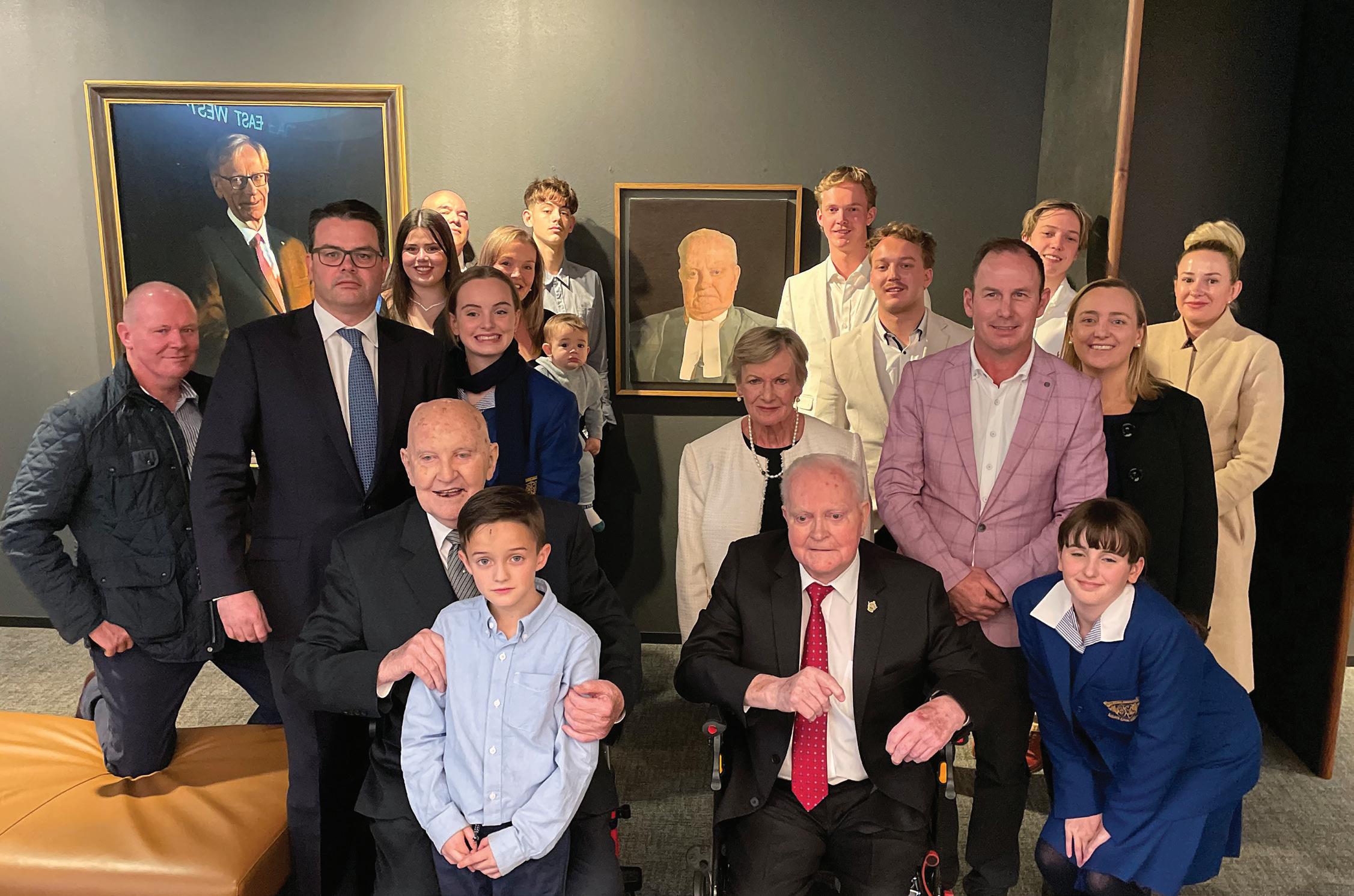

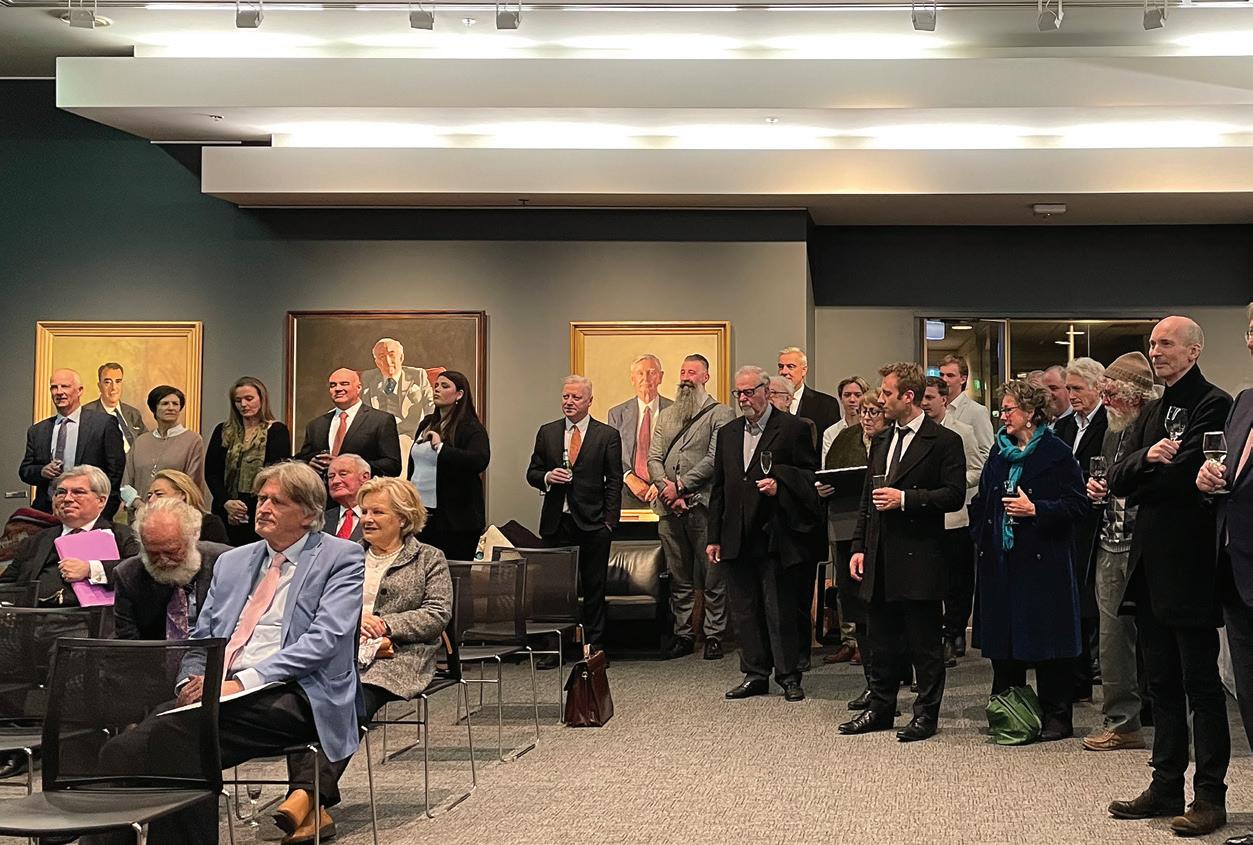
O14,
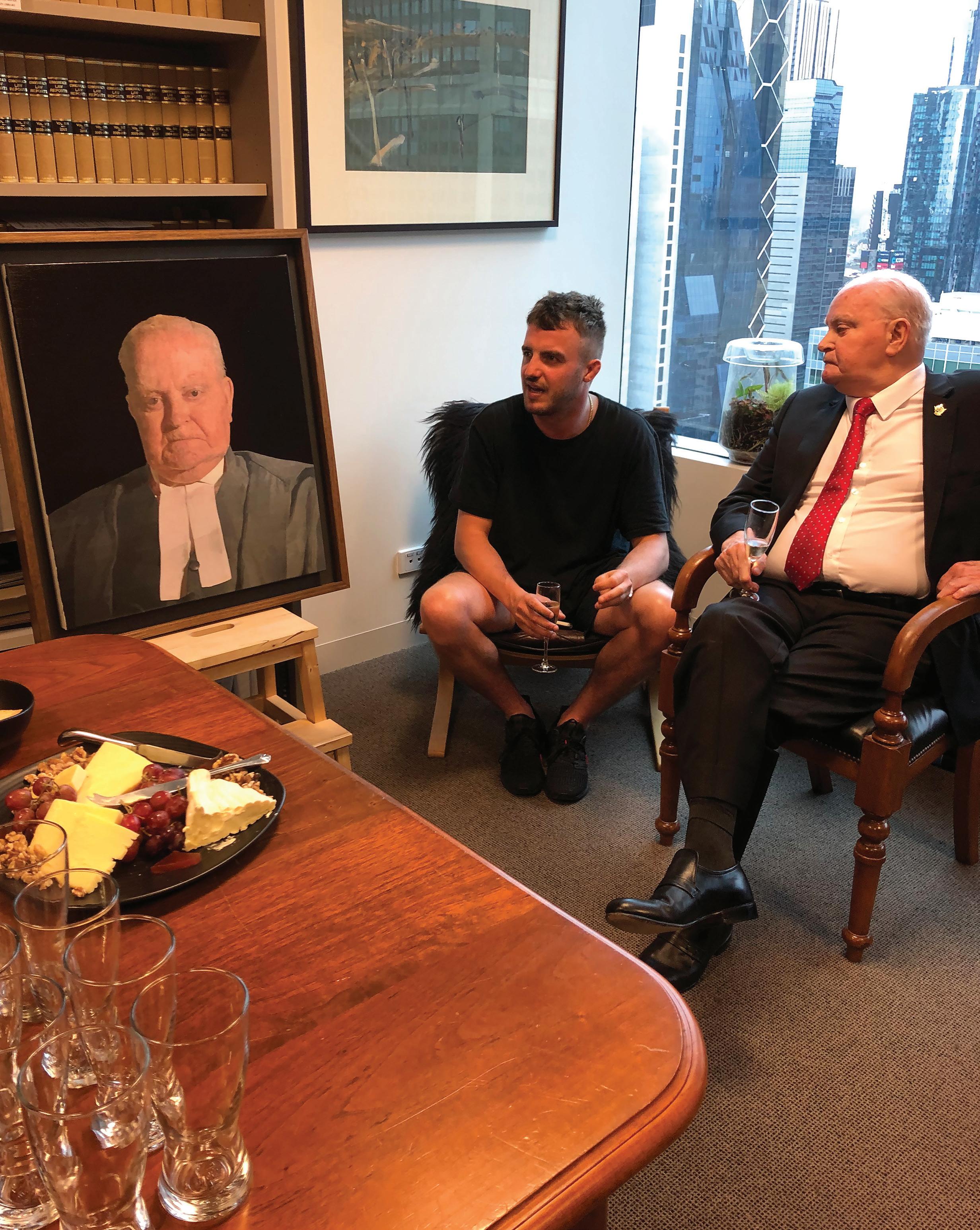
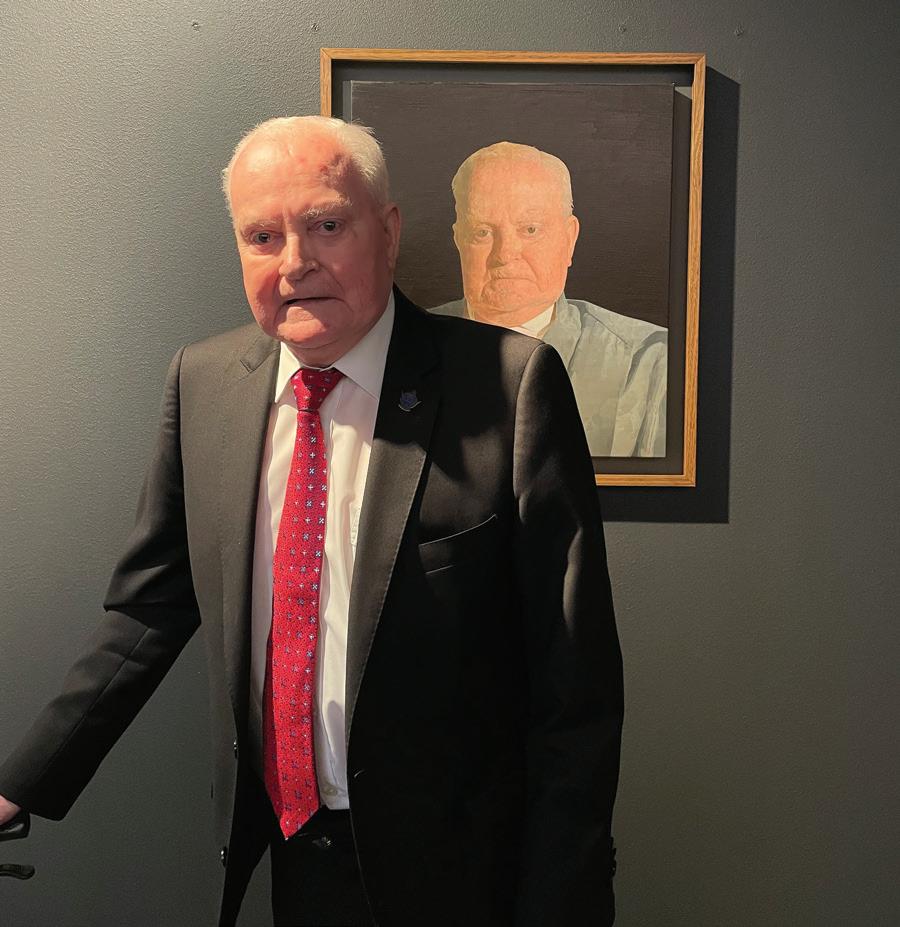
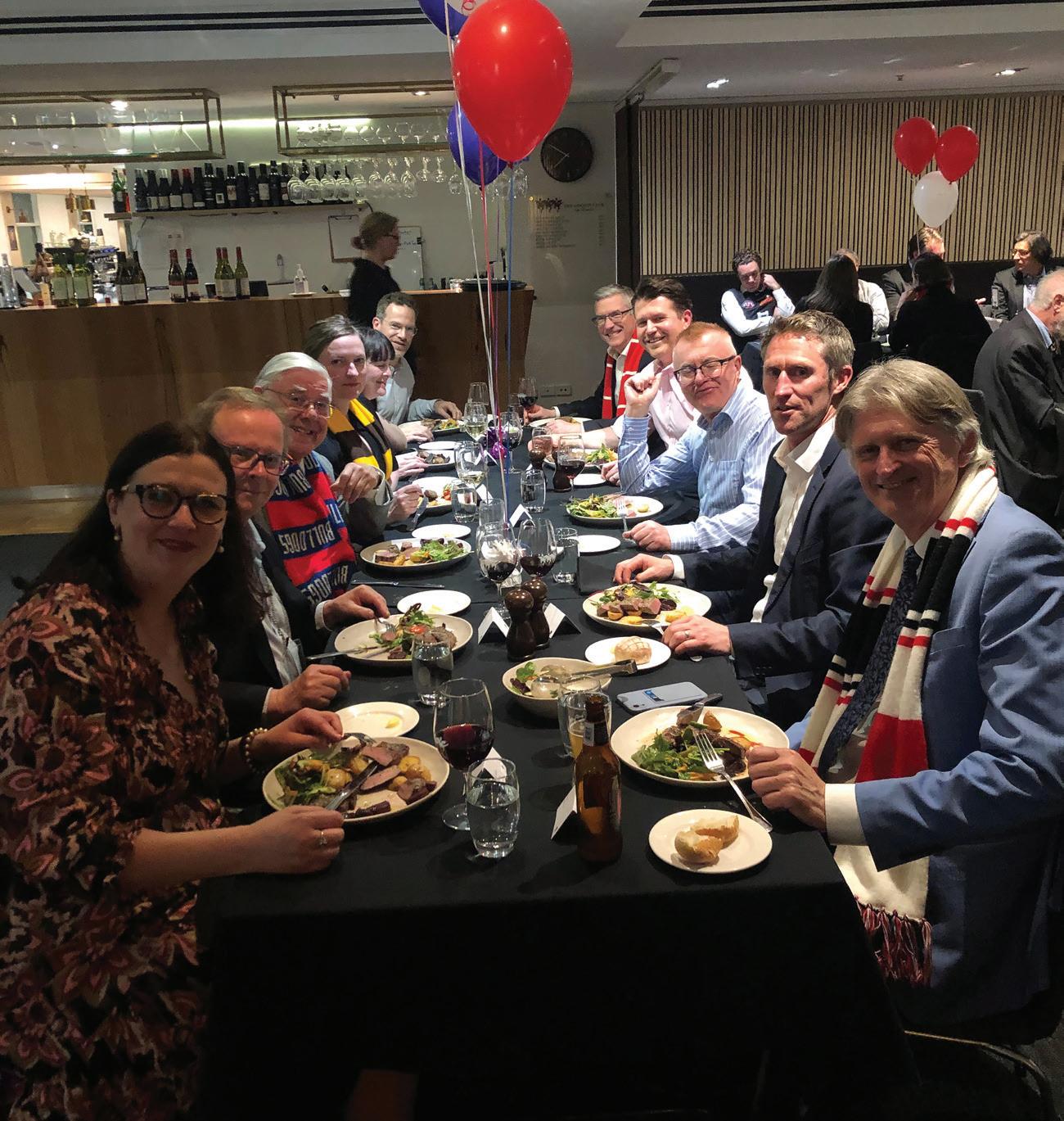


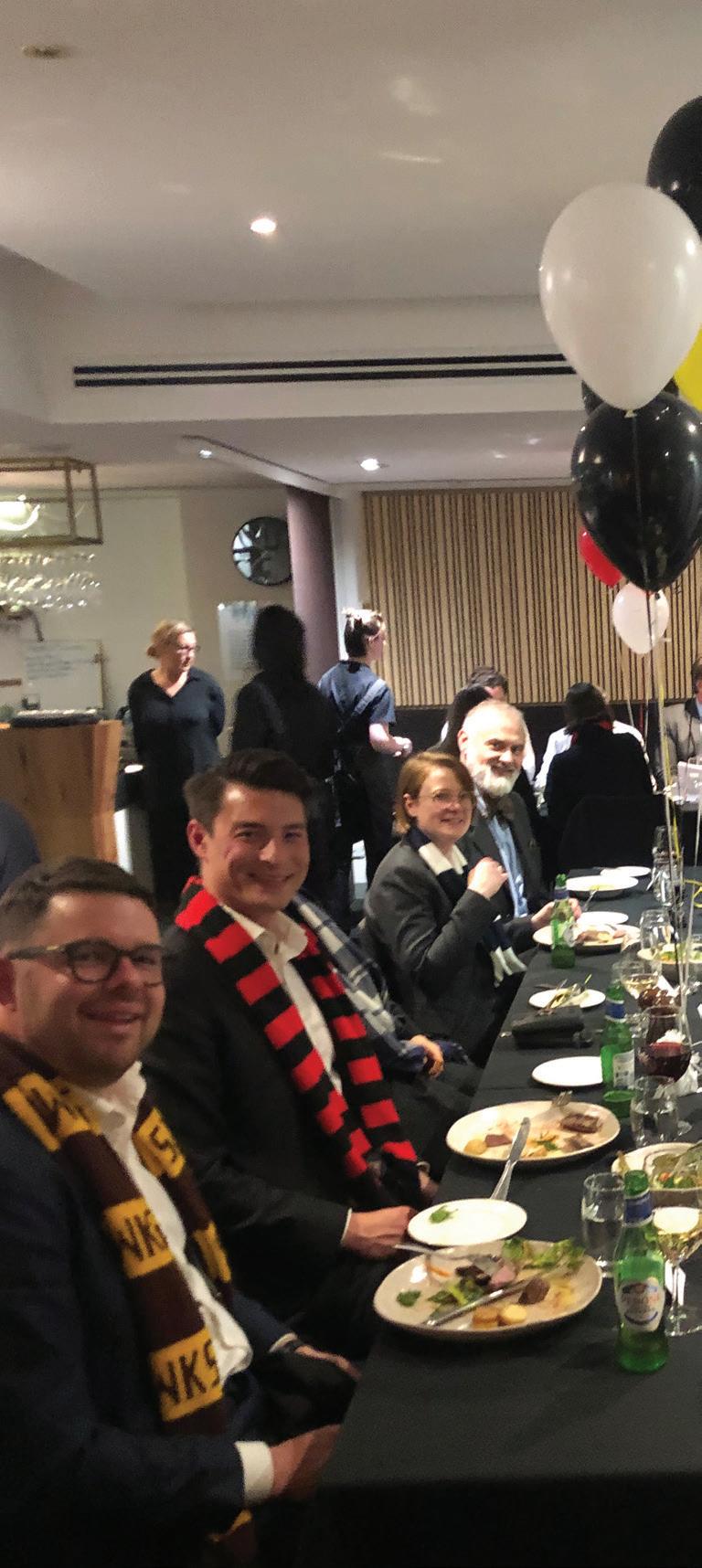
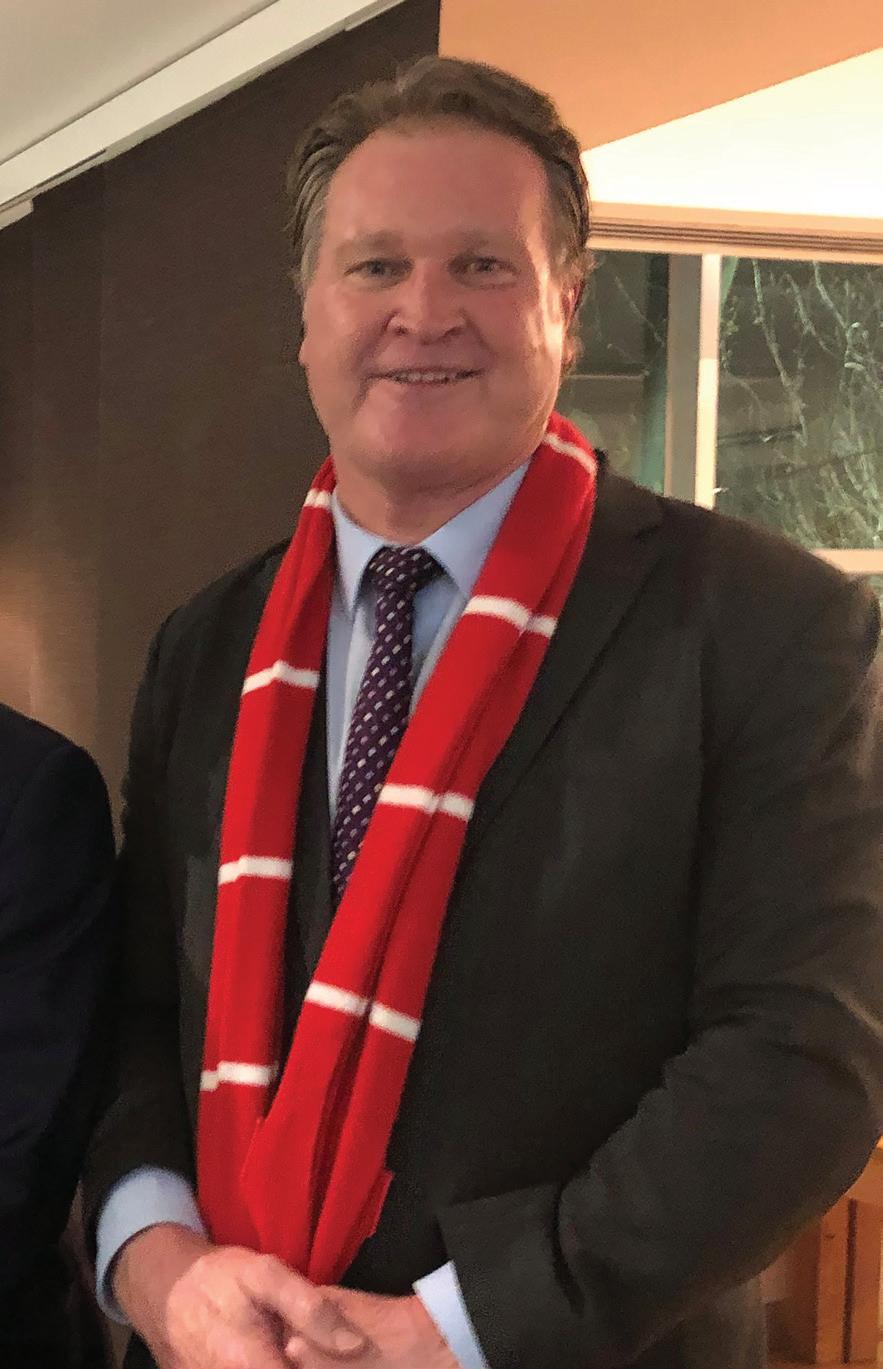
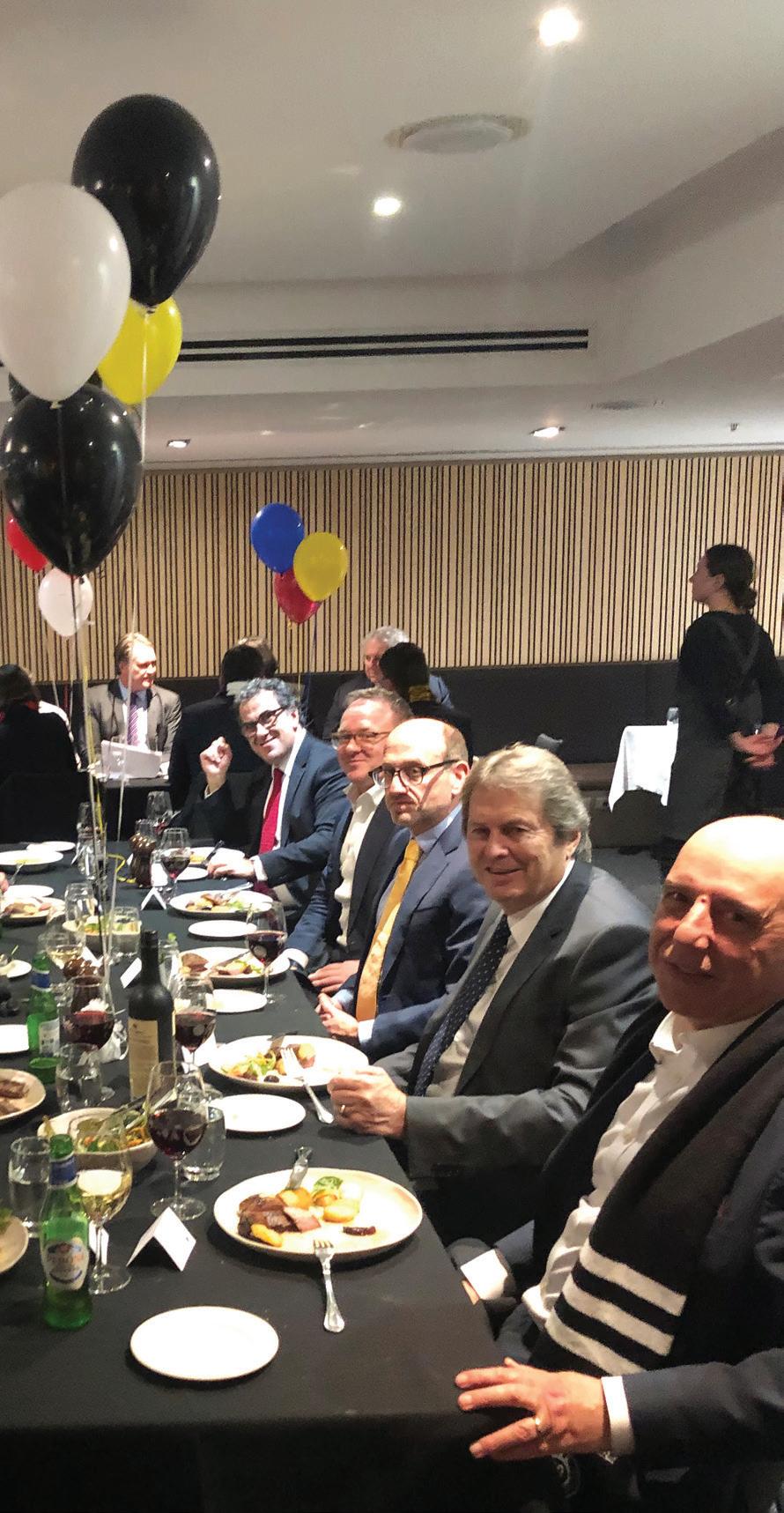
AMY WOOD
Footy fans gathered at the Essoign Club on 15 September 2022, to attend the inaugural Footy Finals Fever Dinner. Guests attended in their own club scarf, and the club was awash with football club coloured balloons. Amongst the fans were barristers Wayne “Moose” Henwood (Sydney Swans), and former AFL General Manager of Football Operations, Adrian Anderson.
From the get-go, the footy talk was passionate and energetic. Guests commenced the evening with pre-dinner drinks and traditional “footy food” (sausage rolls and party pies). Master of Ceremonies, Darryl Burnett, kicked off the formalities with a finals footy quiz. He appeared to take particular delight in posing questions to Collingwood fans about the 1966 grand final! However, he graciously acknowledged that the one-point victory was St Kilda’s only highlight in 150 years of footy!
After dinner, guests enjoyed cheese and chocolates whilst hearing from barrister and former AFL field umpire, Shaun Ryan. From 2003 to 2020, Shaun officiated in 350 AFL games, including eight grand finals. He established himself as one of the league’s best umpires of his time. Shaun entertained everyone with a terrific summary of his impressive and
interesting career. From his junior umpiring days in Warrnambool South, to the VFL/ AFL recruitment academy and beyond. He spoke about the iconic footage of him helping St Kilda player, Nick Dal Santo, up from the ground at the conclusion of the drawn 2010 grand final. Shaun laughed and playfully explained that his only motivation was to ensure that the footy went home with him and wasn’t snapped up by anyone else! He thrilled fans with several anecdotes about good players, cheeky players and, of course, dirty players.
Shaun took a few curly questions (and comments), from the lively group of assembled hardcore footy fans. Unsurprisingly, he handled these with the same humour and good grace that he was so well-known for as an umpire. Shaun expressed his unfettered opinion about the controversial ‘hands in the back’ rule, saying that it became one of the more difficult rules to implement as it was not uncommon for the player receiving the free kick to not know what the free was paid for! Perhaps Adrian Anderson will accept our offer of a right of reply next year.
Many thanks to Shaun, Darryl and the Essoign for putting on a fun and entertaining night.
Looking forward to next year! Until then, go Blues!
RÓISÍN ANNESLEY
Good evening, everyone. The third time is certainly a charm this evening as your Honour’s dinner was postponed twice before and it is now my pleasure to be the one to acknowledge your Honour’s incredible contribution to our Bar.
His Honour began in the legal profession as a young and energetic partner at Messrs Mallesons Solicitors.
In November 1982 his Honour signed the Bar Roll, reading initially with Mr Hartley Hansen (now retired Judge Hansen of the Supreme Court) and later with Mr Ken Hayne (now the Honourable Hayne AC KC who is here with us this evening).
His Honour’s career as a member of our Bar has been nothing short of outstanding, a highlight would be the prominent and arduous Bank of Melbourne case in 1991, a trial in the Supreme Court before O’Bryan J in which he appeared with Ken Hayne QC (as he was back then).
Taking silk in 1992 he delivered a memorable speech as Mr Junior Silk at the 1993 Bar Dinner.
As a silk, his practice flourished. He remained a highly sought-after trial lawyer for his thorough preparation, court demeanour and natural aptitude as a spirited cross-examiner. He was not egotistical but always designed in accordance with the rationale of the adversary system to get to the truth of the matter. Therefore, he was a feared but admired opponent during his time at the Bar.
On 23 July 2002, Geoffrey Arthur Nettle QC was sworn in as a judge of the Supreme Court of Victoria. And in 2005 he was appointed to the Court of Appeal.
His Honour commenced his judicial life in the Common Law Division of the Trial Division. And I note his appointment at the time was well-received by barristers, solicitors and (discretion requiring containment) State and Commonwealth judges, demotically expressed as “fantastic”.
Your Honour is a father, husband, grandfather, and father-in-law to so many including:
Wife Wendy, a practising architect, with whom he shares three children who have all joined us this evening.
Julia Nettle, and fiancé Jonathan Waddell.
Virginia Nettle, and husband Shayne Barnett and his Honour’s grandchildren Alexander and Beatrix.
Jonathan Nettle and wife Jessie Bridge share children Charlie and Isabel and the newest addition to their family, William.
I thank you all for joining us this evening, and I am sure you are all enjoying the extra time your Honour has to assist with the grandchildren.
His Honour has been described through the years as a “tower of strength to the Victorian Bar”. And the turnout this evening proves just that.
Having acquired a reputation of discretion, integrity and innate ability, point to the fact that he was chosen by the affected judges and masters as leading counsel in their High Court challenge to the Commonwealth superannuation surcharge on judicial pensions.
He was always benignant to his juniors, and in court treated fellow barristers with as much collegiate goodwill as his usually highly combative cases would permit. He had, and demonstrated, deeply held views about a barrister’s duty to the court, maintaining the traditions of the Bar by remaining objective and independent. But that was not his only demonstration of exemplary ethical conduct.
Like a true barrister, there were no barriers to access. Whilst his reputation quite rightly attracted many wellheeled clients via the mega firms around Australia, it must be said that he gave no less priority to the briefs of sole and not-so-conspicuous practitioners. The same visceral generosity was available to his colleagues in need of help.
He would readily and cheerfully assist his colleagues with legal problems or the formation of forensic judgments in the presentation of a case, frequently gave practical assistance, and always gave correct references to the many decided cases stored in his memory.
He had three readers during his time at the Bar, who although expecting it, must no doubt be feeling his departure to the Bench, namely: Robert Hay KC, the Hon Pamela Tate SC and the Hon Justice Michelle Gordon AC. Thank you, Justice Gordon and the Honourable Pamela Tate SC for joining us here this evening.
To be known as a great leader and a great lawyer, but above all else, a gentleman in whose company it is always a pleasure to be is one of the highest accolades one could hope for.
On behalf of the Victorian Bar thank you, your Honour, for your service to the Bar and know you will be deeply missed by the Court.
Could you all please raise a glass, for Judge Nettle!




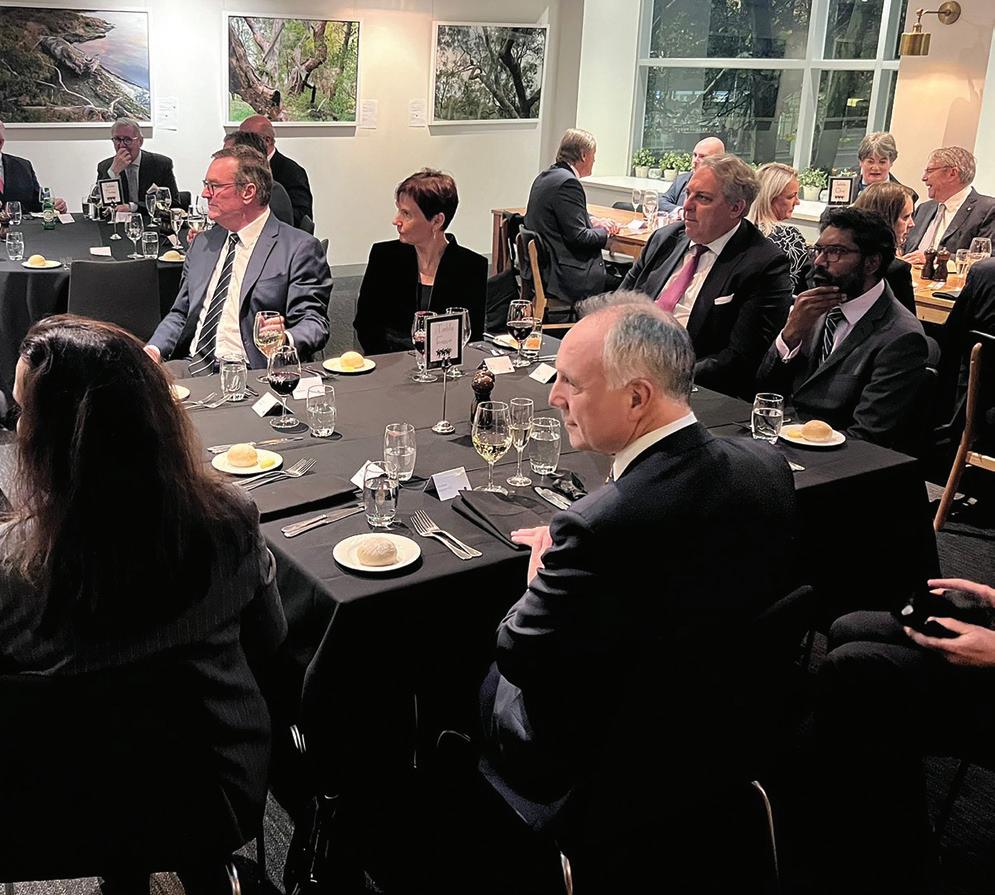
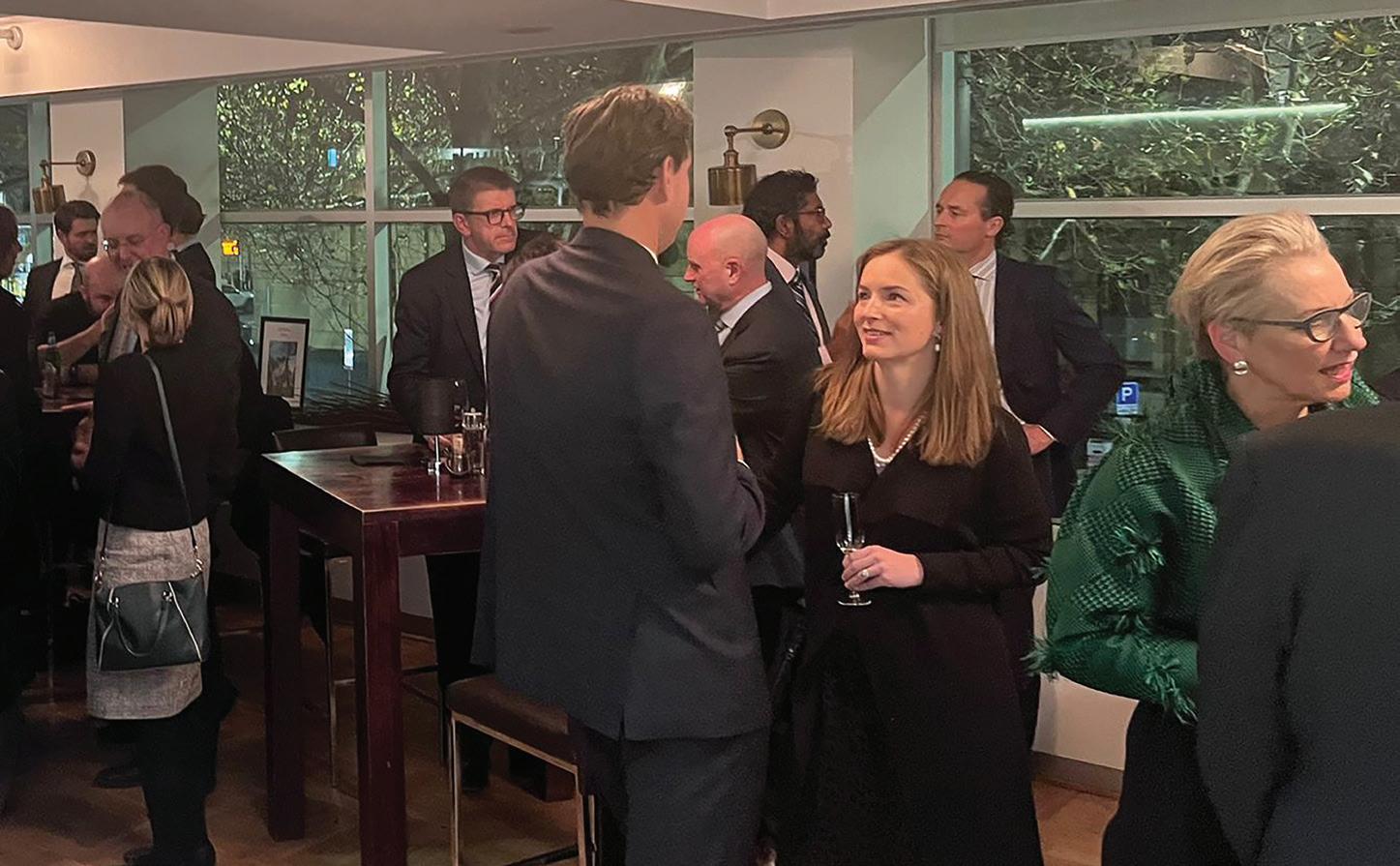





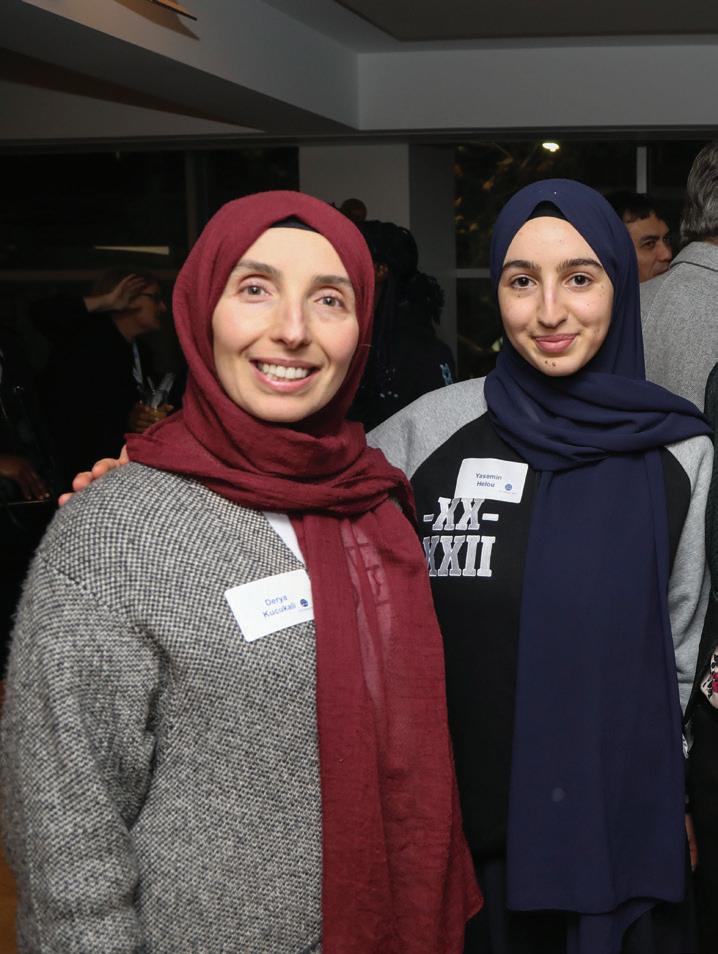

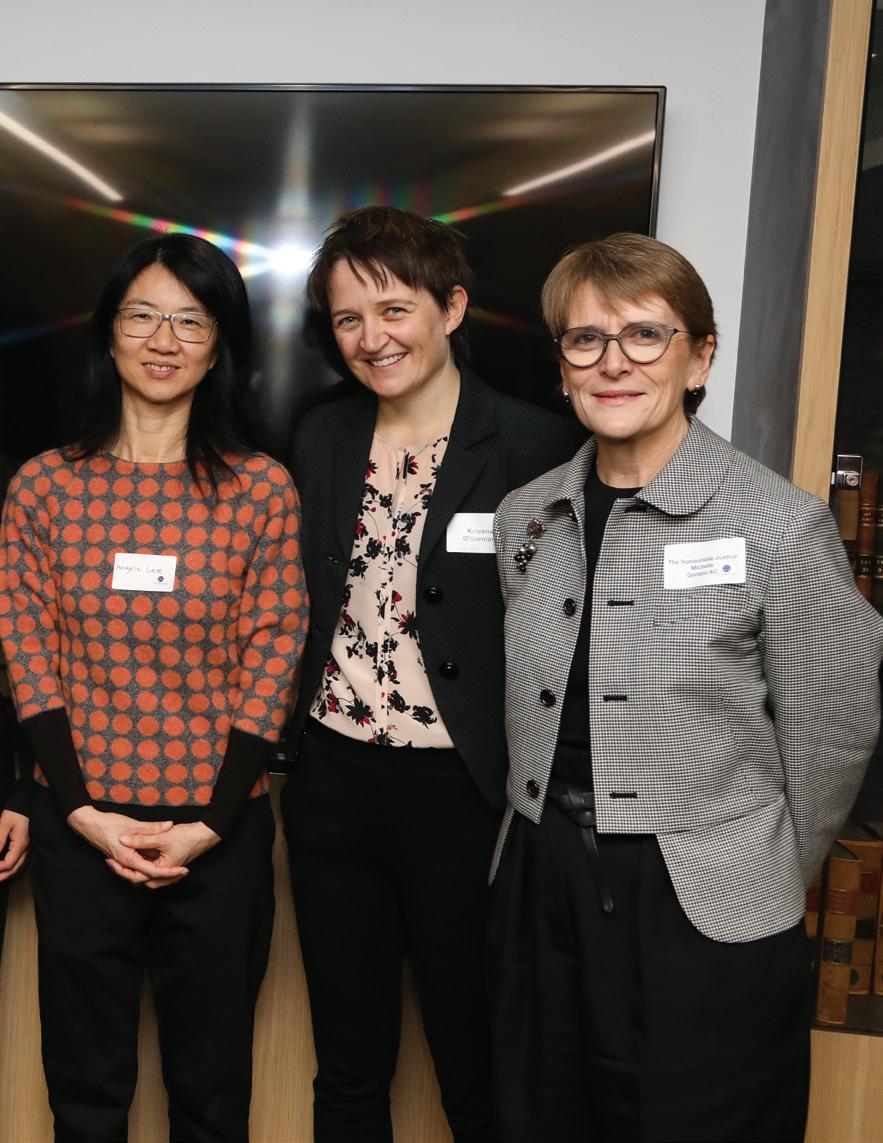
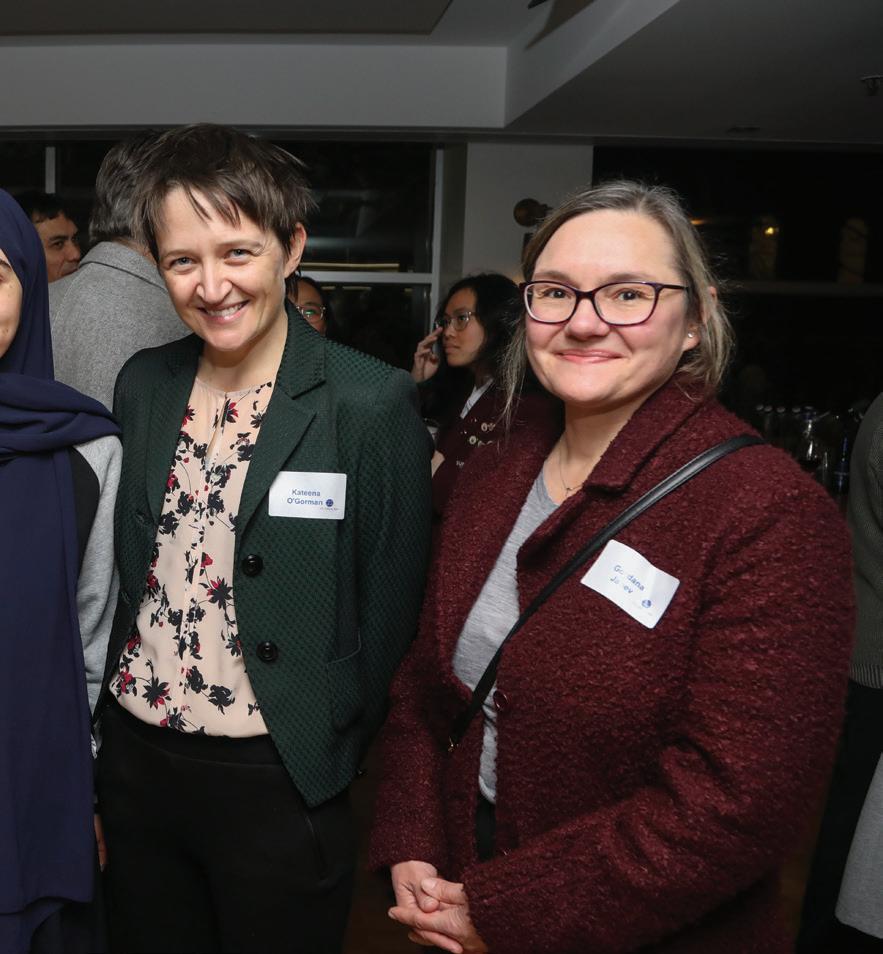

GEORGIE COLEMAN
In June this year, the Richard Griffith Library hosted, for the fifth year, the Victorian Bar Foundation Student Achievement Award Ceremony.
The purpose of the Victorian Bar Foundation Student Achievement Award is to encourage and support bright minds from diverse backgrounds and promote the message that the Bar is open to all on merit; irrespective of socio-economic circumstances, ethnic background, religious affiliation, sexual orientation, gender, gender identity or physical disability. For the past five years, the Foundation has partnered with the City of Hume (which includes outer north-western suburbs of Melbourne such as Broadmeadows, Faulkner and Keilor). It is a diverse area of Melbourne: according to the most recent census data, the most common countries of birth for residents after Australia, are Iraq, India, Turkey and Lebanon. Over half of the area’s residents’ parents were born overseas. In delivering its Achievement Awards the Victorian Bar Foundation has also been assisted by the Meadow Heights Community Foundation.
As part of the program, the highest achieving units 1 and 2 legal studies student at each of the 15 schools in the City of Hume region have each received a prize of $1,500. The students also attend a “Work Experience Day” at the Supreme Court of Victoria and the Bar. The award is a way to recognise the hard work and talent of each of the winners; motivating them to continue to excel in their studies, particularly during the challenging task of year 12 and encourage them to consider a future career in the law.
An important aspect of the Award is the Prize Ceremony at Richard Griffith Library. At the ceremony, the students had the opportunity to meet with the Honourable Justice Michelle Gordon AC, Patron of the Victorian Bar Foundation, the Bar Foundation Chairman the Honourable John Digby KC, Directors of the Bar Foundation, other members of the judiciary, and members of counsel. Also in attendance were the winning students’ proud parents and siblings, and legal studies teachers and others from City of Hume. Justice Gordon presented the Award to the students, together with City of Hume Mayor Cr Carly Moore and Philip Crutchfield KC (a director of the Foundation who stood in for the Bar Foundation Chairman on this occasion).
Justice Gordon inspired the students (and their parents) with her speech on the night, recognising each student’s hard work and talent, speaking of how her career would not have been possible without encouragement and support she received along the way, and encouraging the students to “be inquisitive” and make the most of the opportunities presented to them by the Award.
Philip Crutchfield KC congratulated the students and expressed the hope that the prize encouraged each of them to stay motivated to continue to excel as each student looked to completing the challenging task of year 12 studies. He encouraged the students to keep in mind the possibility of a legal career as they progressed through school and tertiary education, adding that “the Bar would be extremely lucky to have each of you join its ranks as barristers in 10 or 15 years from now”.
The Foundation is planning to extend the reach of the Award in the near future— keep your eye out for updates!
WILLIAM LYE
The Asian Australian Lawyers Association launched the 2022 William Ah Ket Scholarship on 29 June 2022 at the Peter O’Callaghan QC Gallery. William Ah Ket was Australia’s first barrister of Chinese descent. He signed the Victorian Bar Roll on 20 June 1904. His Roll number was 88. The scholarship named after him is awarded annually to the applicant who produces the most outstanding research paper on a topic relating to equality, diversity and the legal profession or law. This year, the topic takes a quote from a biography of Joan Rosanove QC and poses the question: ‘The Australian legal profession and judiciary are lagging behind in cultural diversity, at least by comparison with certain other professions. What structural improvements can be made to the Australian legal profession and/or judiciary to bridge the cultural diversity gaps and break down persisting cultural barriers?’
At the scholarship’s launch, the Hon Michael Black, gave an evocative keynote speech with amusing anecdotes, including the circumstances in which his Honour came into possession of Ah Ket’s law reports. A copy of the speech is published on the AALA website at https://bit.ly/3NsOIld
This year’s scholarship is supported by all three institutions where Ah Ket journeyed through his trailblazing legal career –Maddocks, as founding sponsor, the Melbourne Law School and the Victorian Bar, as supporting partners.
The winner will receive $6,000 and two runners up $1,000 each and an opportunity to meet senior legal professionals and members of the judiciary during the award ceremony in Brisbane on 12 December 2022.
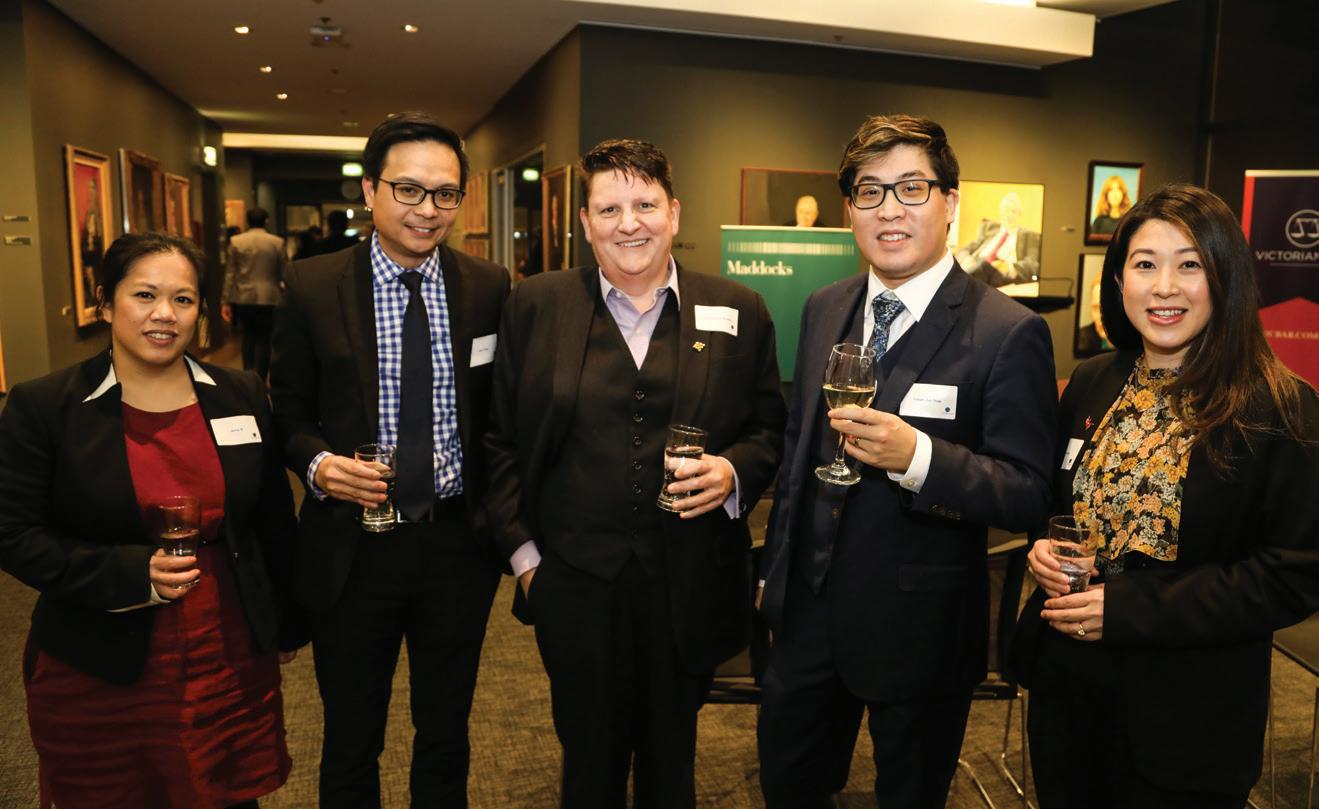

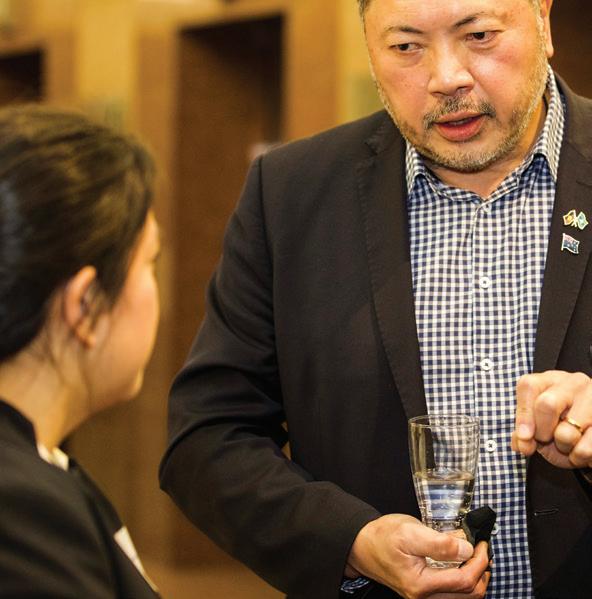


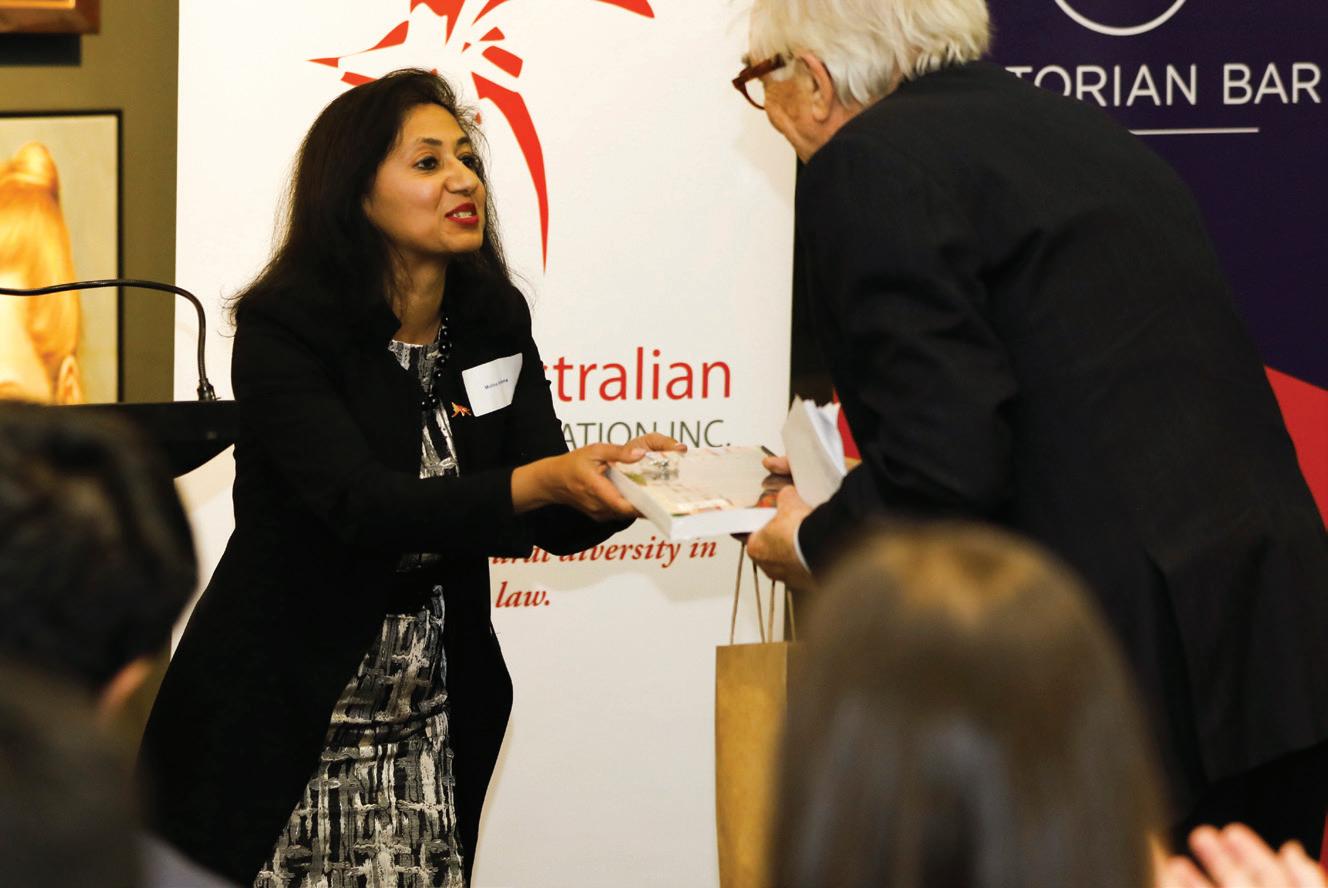
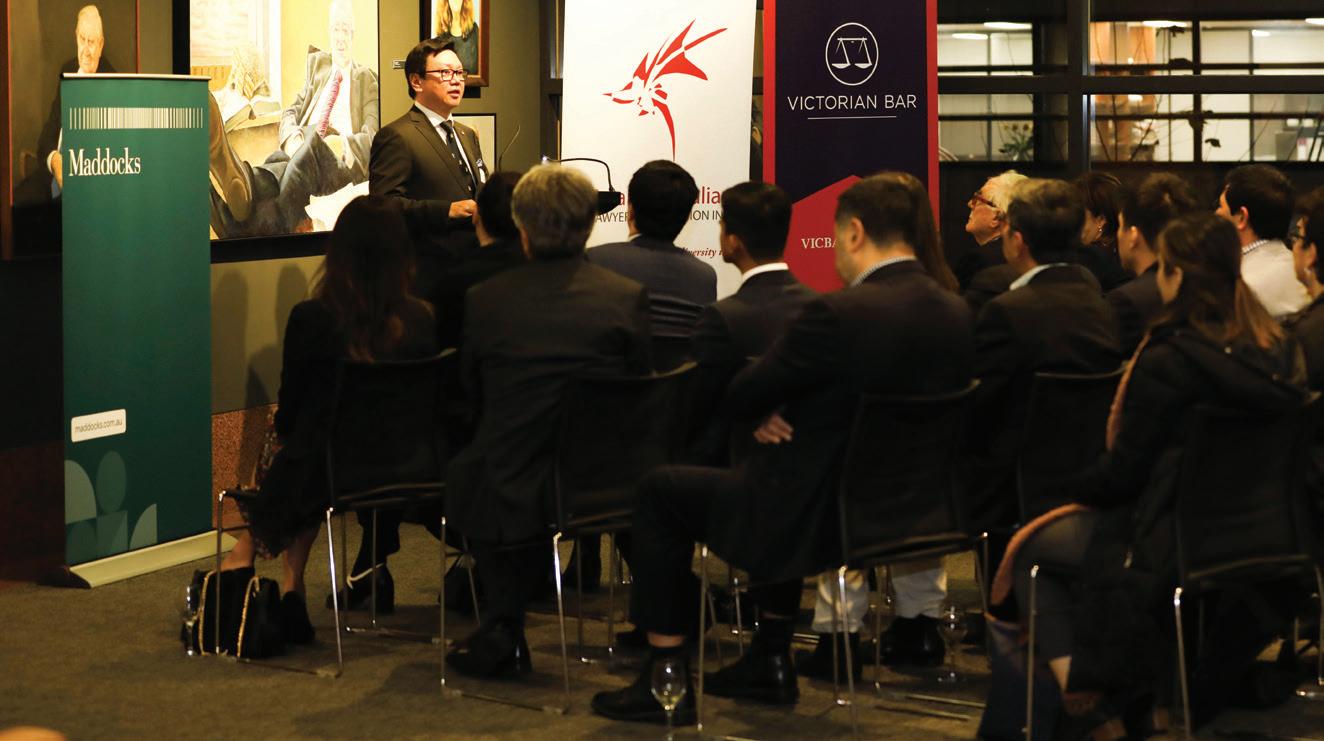





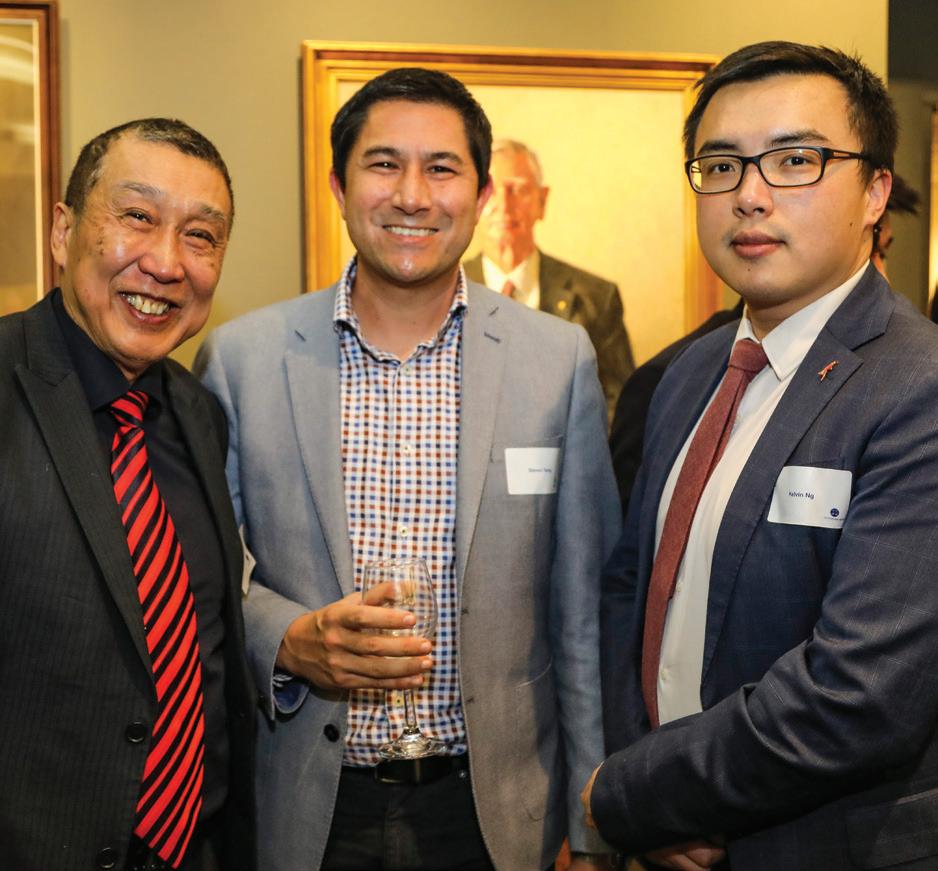
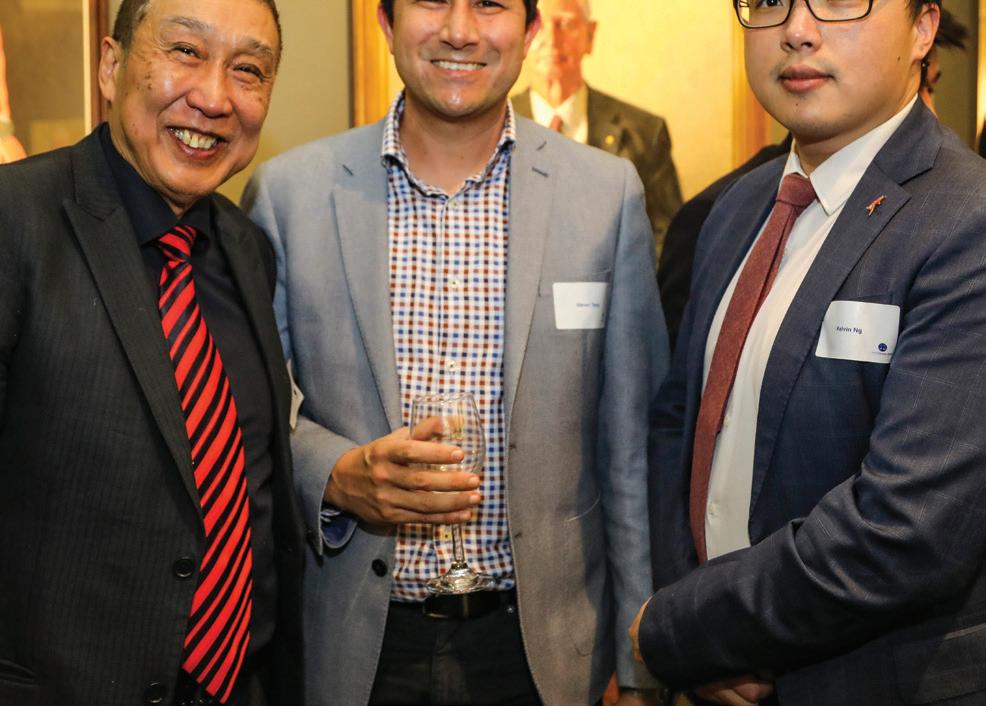
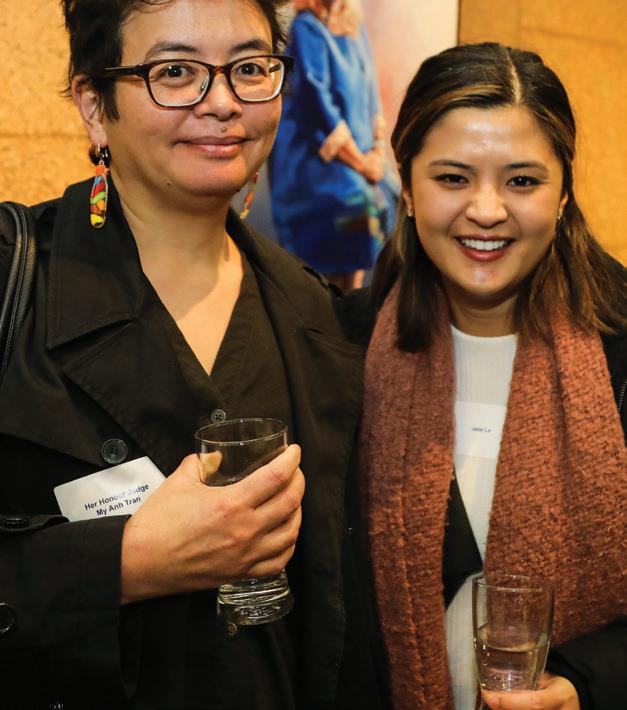

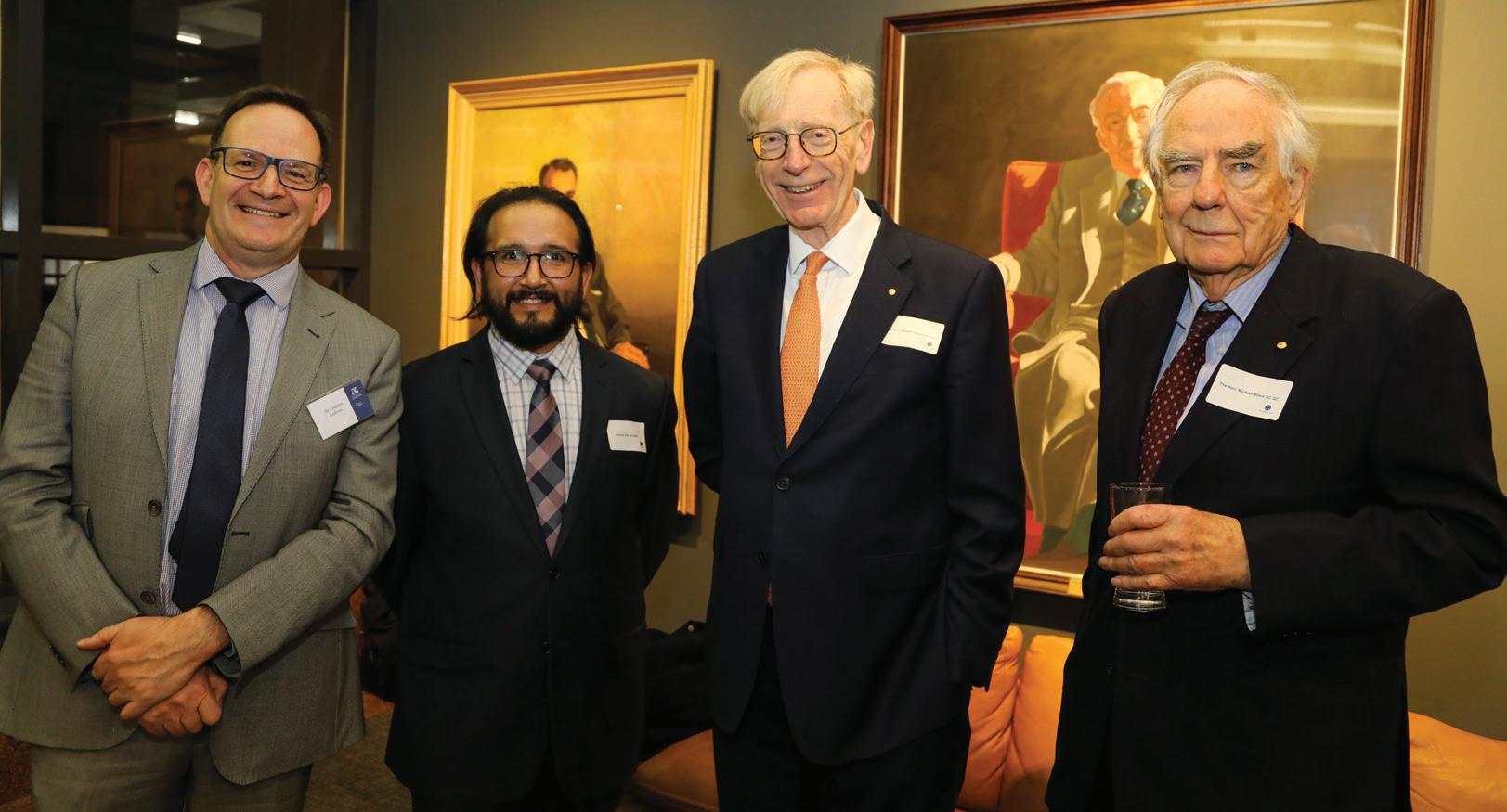
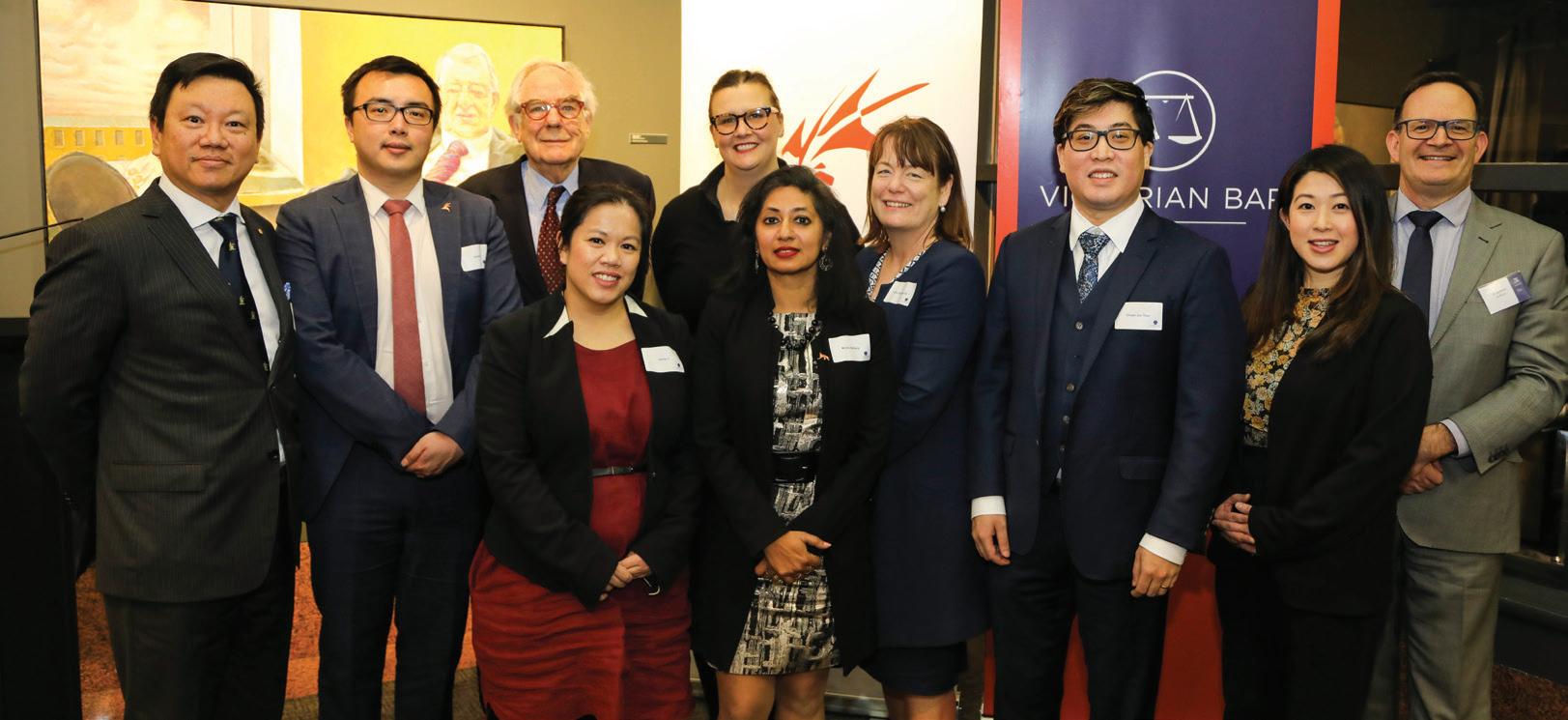

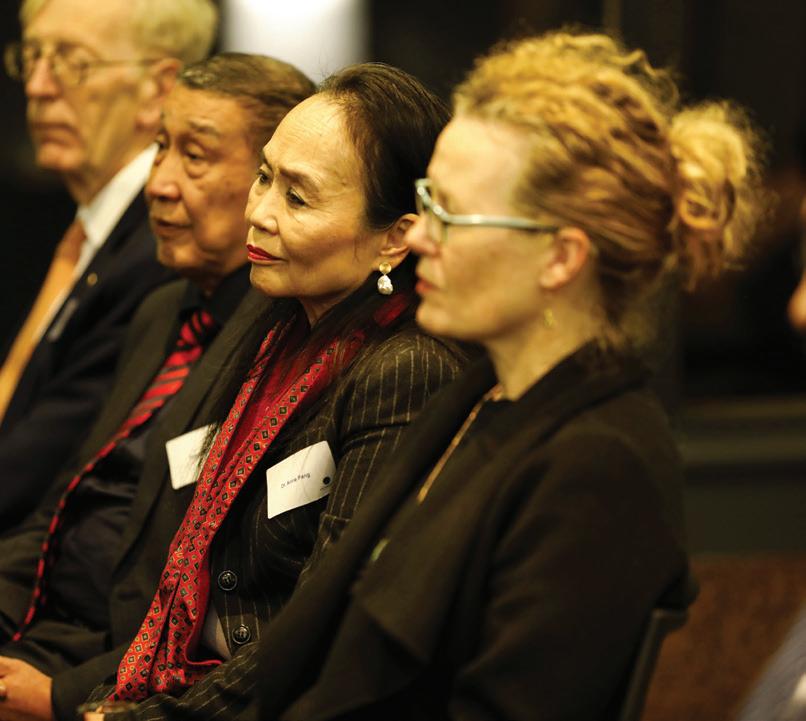


MICHELLE GORDON
Iam deeply honoured to launch the Robin Chan Memorial Grant—a grant honouring Robin Chan who was taken from us too soon on 28 September 2020. The Grant is not only appropriate but so right. Let me explain.
First, the Robin Chan Memorial Grant is to provide support for enrolled Melbourne Juris Doctor students. That is unsurprising. Robin finished his undergraduate studies in Law at the Melbourne Law School in 2003 and was awarded the Supreme Court Prize. Of course, that list of Robin's academic achievements is incomplete. It was preceded by Robin being a Dean's Honours List student in Commerce in 2002. And it was followed by him completing a Master of Tax from Melbourne Law School in 2012 and an LLM from the National University of Singapore in 2015, having studied there as an ASEAN student and finishing as the M Karthigesu Gold Medal and Memorial Prize winner as the top student specialising in shipping law.
Second, the Robin Chan Memorial Grant was established with the support of Robin's family, friends and colleagues to provide assistance to students who are experiencing immediate disadvantaged circumstances and for students who can demonstrate community involvement, with preference given to Indigenous Australian students; those who are culturally and linguistically diverse; or who have a refugee or new migrant background. Again, the right criteria. Robin was the first international student to be awarded the Supreme Court prize. But that personal trait—intellectual excellence—was not only what marked his life in and outside the law. His life was marked by assistance to others.
At law school, Robin was instrumental not only in creating the Indigenous Law Students and Lawyers Association of Victoria, now known as Tarwirri, but he was instrumental in creating the Pre-Law Seminar Series to assist Indigenous law students. Professor Stewart from the University of Melbourne says it was Robin’s invention. The Pre-Law Seminar Series was a package of four seminars to prepare first year Indigenous law students for legal study and practice. The third seminar focussed on essay writing skills. Practice questions were provided and different ways of approaching them were shown to distinguish between different approaches to writing:
» creative v boring;
» logical v incoherent;
» structured v all over the shop; and
» well-supported v sweeping.
Some might say a number of practising lawyers and judges might benefit from that seminar. The fourth seminar focused on exam technique. If you stop for just one minute, you will notice that that series reflected Robin—smart wise, practical and generous.
After graduating, Robin began his paid work in the Law. He delayed beginning a Masters so he could earn an income and care for his sister Lee. So what did he do?
» He worked as a Research Associate in the Court of Appeal Division of the Supreme Court of Victoria and as an associate to the Honourable Justice Chris Maxwell, the then President of the Court of Appeal;
» He was an Articled clerk and then solicitor in the Tax and Banking & Finance groups of Deacons Lawyers (now Norton Rose Fulbright);
» He then worked at the Federal Court of Australia in Melbourne starting as a researcher and then as an associate to the Honourable Justice Kenny AM for 18 months;
» And then after returning to Deacons Lawyers, he commenced as an associate to the Hon Justice Habersberger in the Trial Division of the Supreme Court of Victoria before going to the Victorian Bar in 2013 where he remained until his untimely passing.
And if that is not enough, Robin was the architect of the Melbourne Law Masters subject "Administrative Law in Tax Matters" which was launched in 2020, and he was a member of an Expert Advisory Panel for a project to reform how Administrative Law is taught at Melbourne Law School. That list is again incomplete but the list marks the person. It was a career, a life, marked by excellence and assisting others.
So why me launching the Robin Chan Memorial Grant? Robin was my grandson, in the law. He read with Frank O'Loughlin, who read with me. But that familial relationship was not how or when I met him. My first encounter with Robin was when he was an associate to Justice Kenny of the Federal Court and I was a judge of that Court. His presence was large and infectious. He was super smart and the most wonderful person to have around chambers. So when Justice Habersberger rang me a few years later and said he had this fabulous associate who I knew and who wanted to go to the Bar and do tax work and then posed the usual question— who should he read with?—there was only one answer: Frank O'Loughlin, now Frank O'Loughlin KC. What then followed was— in typical Robin (and Frank) style—not only the most wonderful friendship between Robin and Frank, but also opportunities for Robin to see me in the street, at a function, really anywhere appropriate or inappropriate, and for him to announce, with the largest smile on his face possible, "Hello Grandma". His email to me on my appointment to the High Court said, "congratulations Grandma, I mean judge".
These memories I cherish. They bring a smile to my face. So this Grandma has the wonderful honour to launch, with extraordinary pride, the Robin Chan Memorial Grant and to ask that you generously support this grant. And to support it not only to honour an extraordinary person of great intellect, warmth and generosity and to honour the work that Robin did, but most importantly to be able to continue, in his name, the work that he started—supporting those at law school who are less privileged.
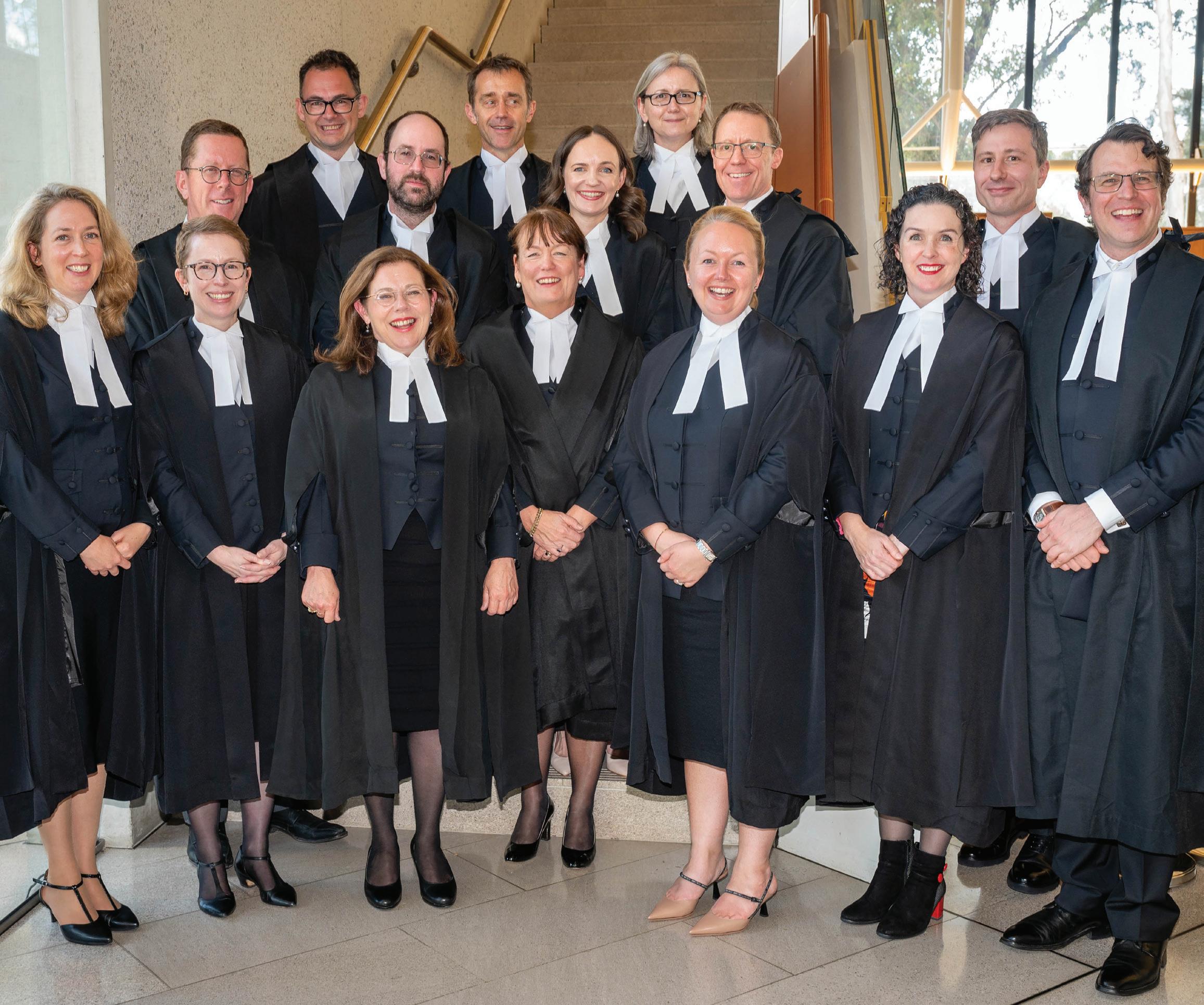
RÓISÍN ANNESLEY
It was a privilege to appear on behalf of the Victorian Bar in the High Court on 11 October 2022, first in the morning at the ceremonial sitting for the announcement of the 2020 silks, and then in the afternoon at the ceremonial sitting for the announcement of the 2021 silks. The disruption to the tradition occasioned by the COVID-19 pandemic did not appear to dampen the enthusiasm of the new silks nor the court in acknowledging their achievements.
The sun shone brightly throughout the day and the court was abuzz as family, friends and colleagues gathered to witness the
new leaders of the independent Bars of the respective states and territories, and those silks appointed by the commonwealth, each announce their appointment as senior counsel.
The tradition of the court acknowledging the nation’s new silks is of long standing. Chief Justice Kiefel remarked:
It is fitting that upon your appointment as senior counsel or King’s counsel for your state or territory you journey to this court and have your appointment announced. Your attendance and that of your Bar association, acknowledges


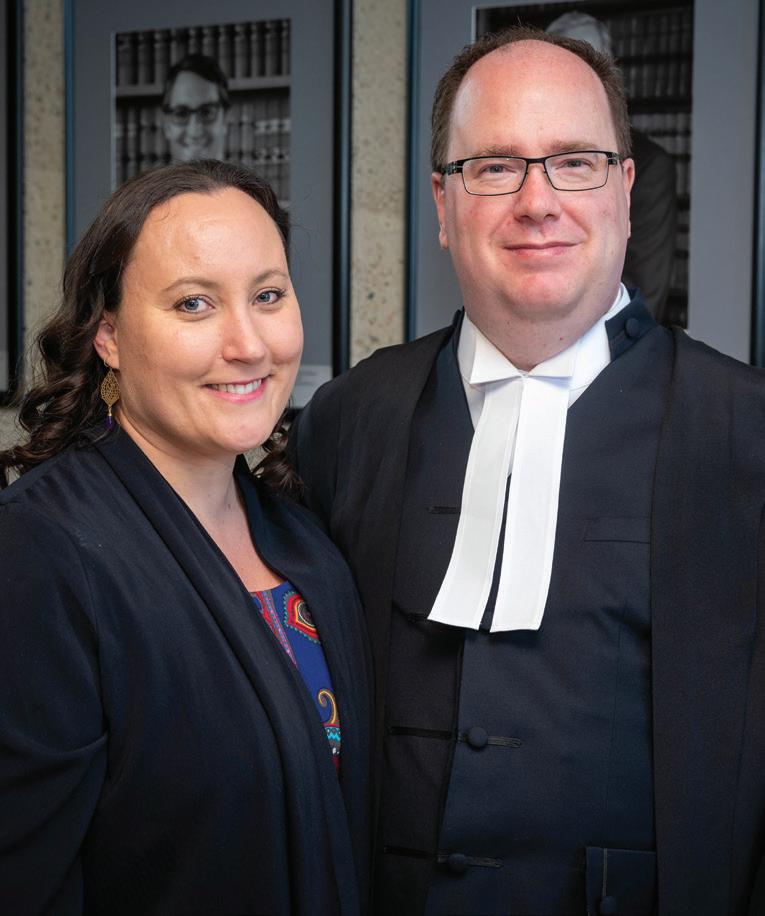
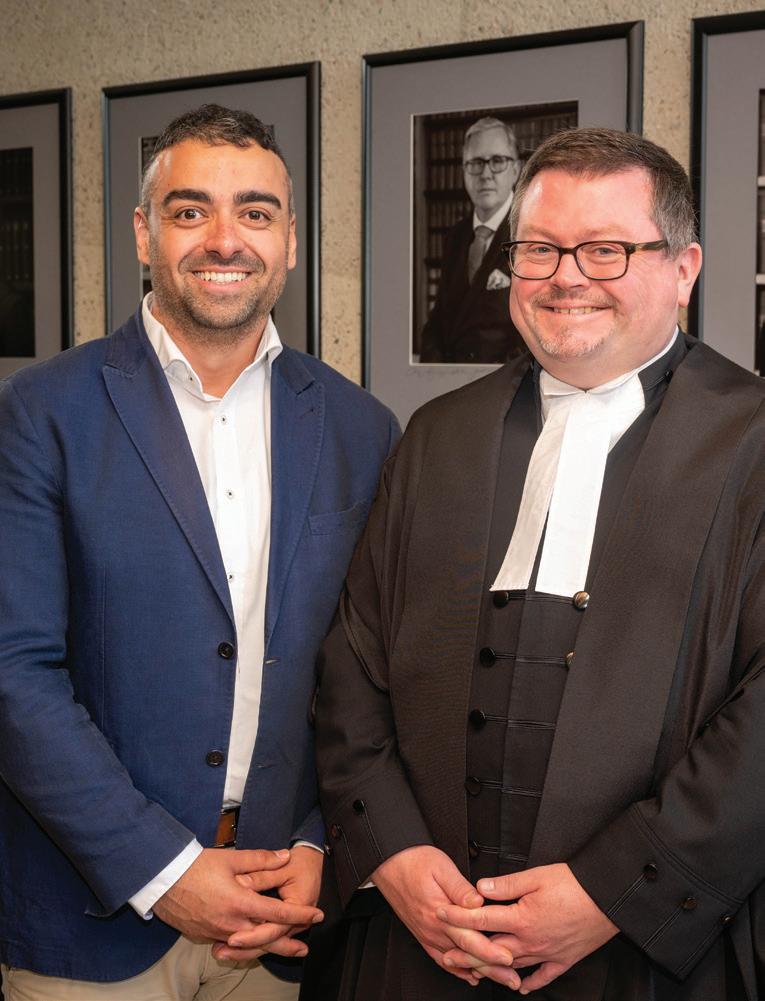
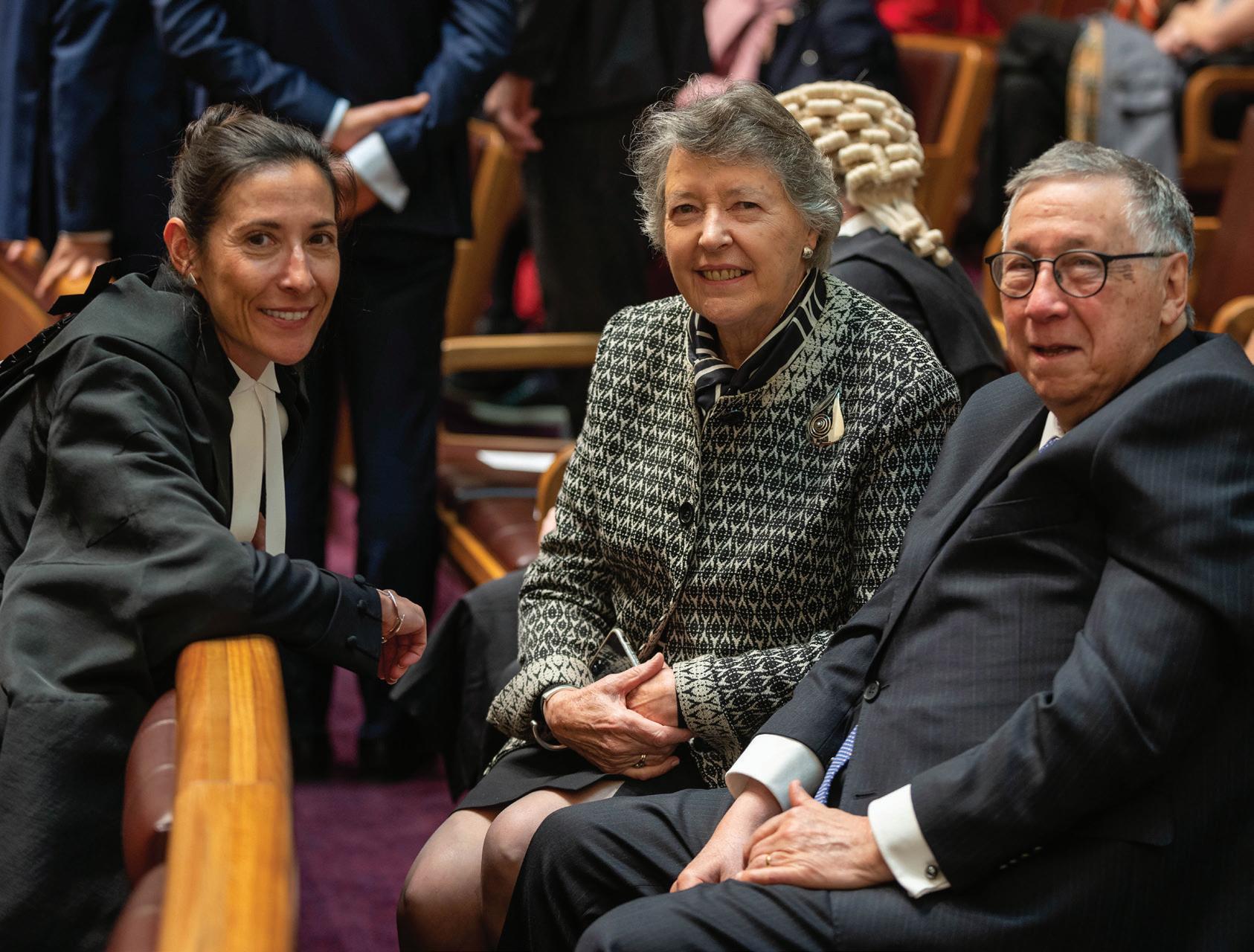
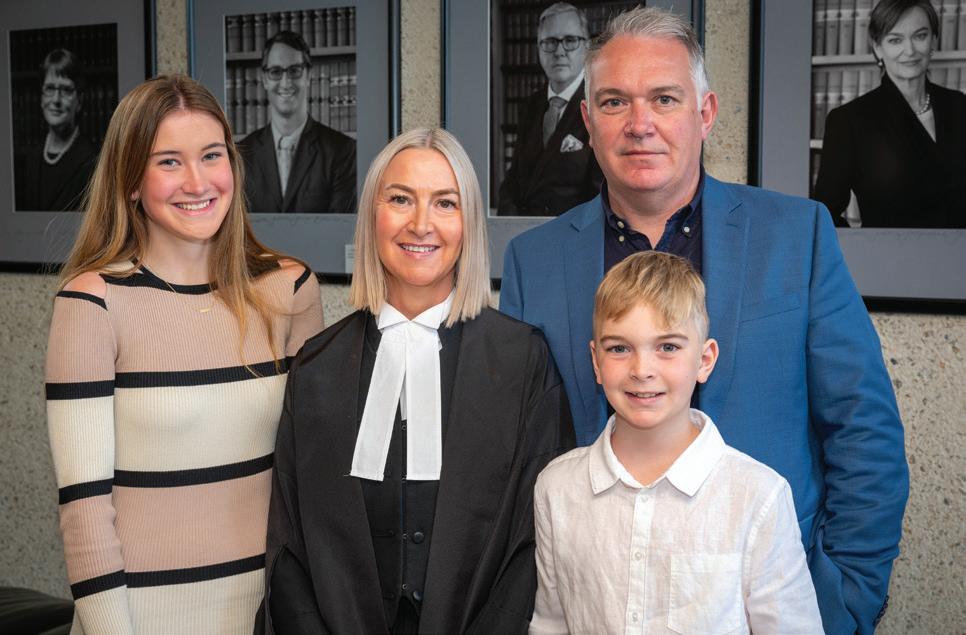
the relationship between the courts and the Bar, and the position of this court at the apex of our judicial systems. The strong relationship between the courts and the Bar and the rule that a barrister’s first duty is to the court has long been an important feature of our legal system. It would not be possible for the courts to discharge their work if they were not able to rely upon counsel to conduct litigation efficiently and in accordance with the high standards of conduct and ethics which may be expected of members of the profession of barristers.
Chief Justice Kiefel recognised that the new silks had been appointed not
as a result of the passage of time in the profession but by reason of their outstanding abilities as advocates, knowledge of the law and leadership skills, which was reflected in their considerable practices, which comprise the most complex and difficult cases within their respective practice areas.
In her address to the new silks, the chief justice reminded them that with their new status within the profession, more would be expected of them by the courts, by the profession and by the Bar associations. She reminded them of their obligations to conduct themselves with dignity and civility at all times, to be prepared to guide and lead the junior Bar by example as much as by the giving of advice. As her Honour said:

Your appointment is made for the benefit of the profession as well as in recognition of your abilities. This is how the profession may continue. The profession will survive if it maintains that which sets it apart from other providers of services. Its hallmarks are integrity and independence. The courts expect every barrister to uphold the professional and ethical standards of the profession, but they expect silks to be the exemplars of such conduct.
Amongst those in the courtroom in the morning ceremony to witness Elizabeth Ruddle SC take her bow was her mother, the Hon Betty King SC. Betty and Liz are confident that their respective


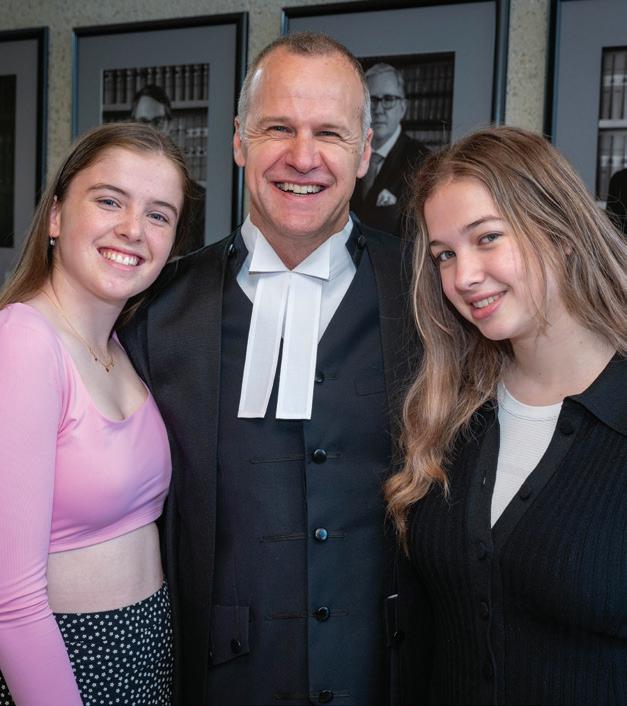
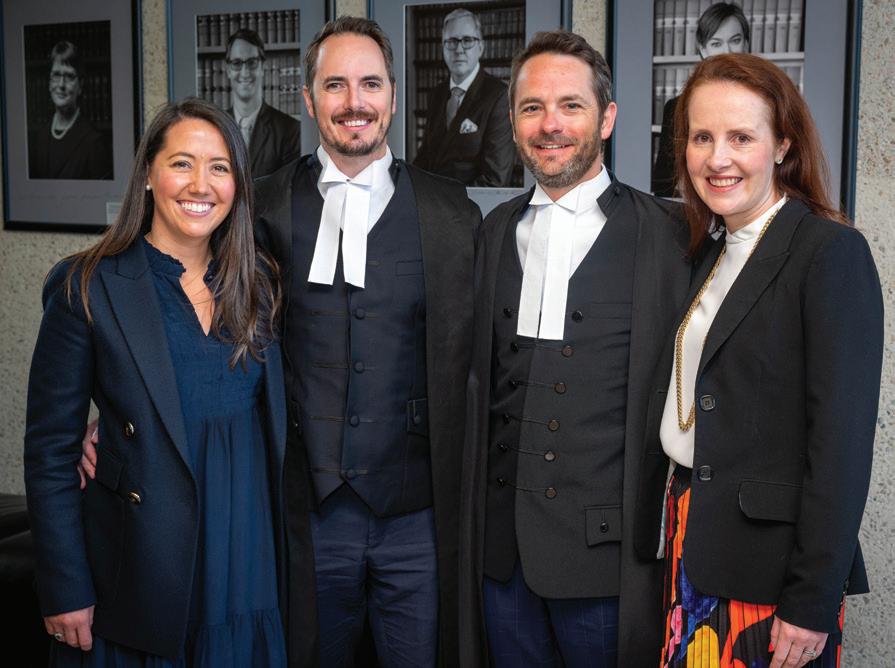
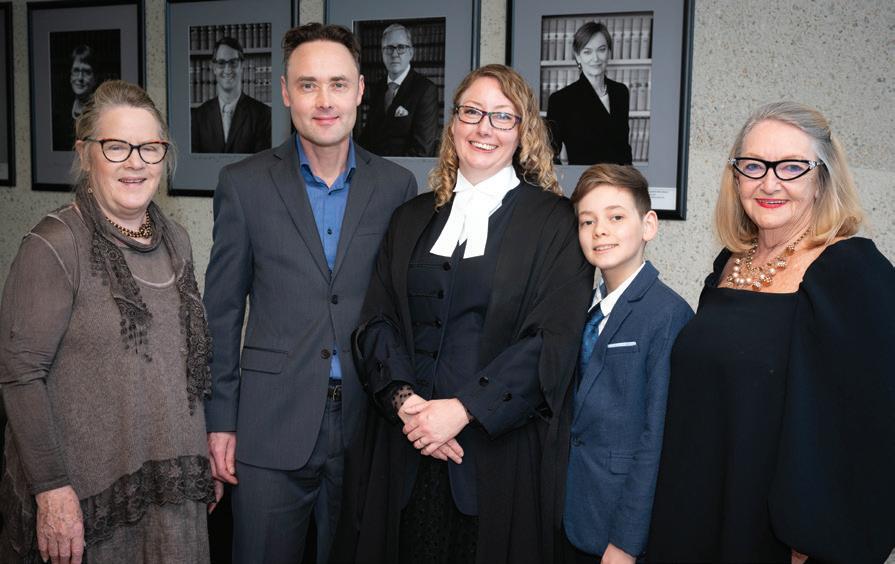
appointments as senior counsel make them the first mother and daughter pair to have been appointed senior counsel in Australia.
In a break with tradition, and only because of the large number of attendees—approximately 300— the Australian Bar Association Silks Gala Dinner was held in the National Gallery of Australia rather than in the High Court building. The evening was a great success and Dr Matt
Collins KC is to be congratulated on his organisation and his role as Master of Ceremonies.
Justice Keane delivered a warm toast to the new silks on behalf of the judges, which was both inspiring and humorous. Justice Keane encouraged the new silks to accept all the adulations and congratulations which had been bestowed upon them—not only because it was fitting to do so, but because in years to come there will be times when

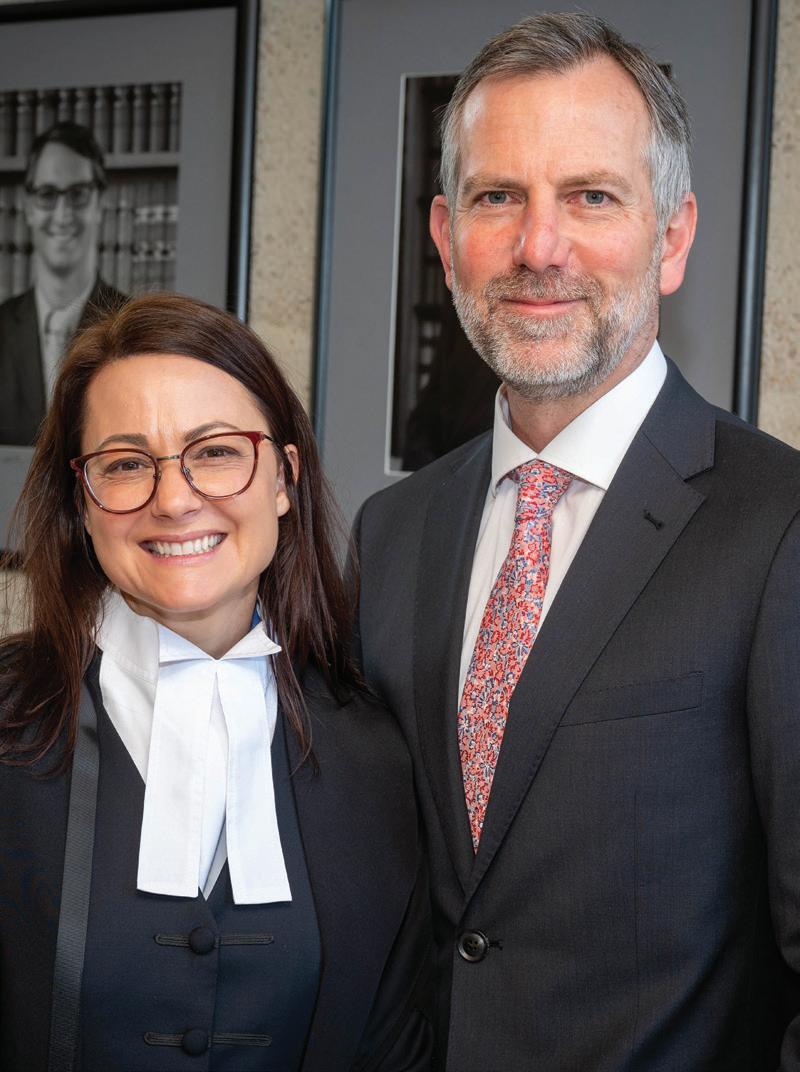
being the silk facing unfriendly and sustained fire from the bench might feel like the loneliest place in the world, and they may need to remind themselves that when they were appointed, everyone told them they could do it!
In reply South Australian Ben Doyle KC, who took silk in 2020, delivered a clever and entertaining speech—one would expect nothing less of the younger brother of the Victorian Bar’s very own Rachel Doyle SC.




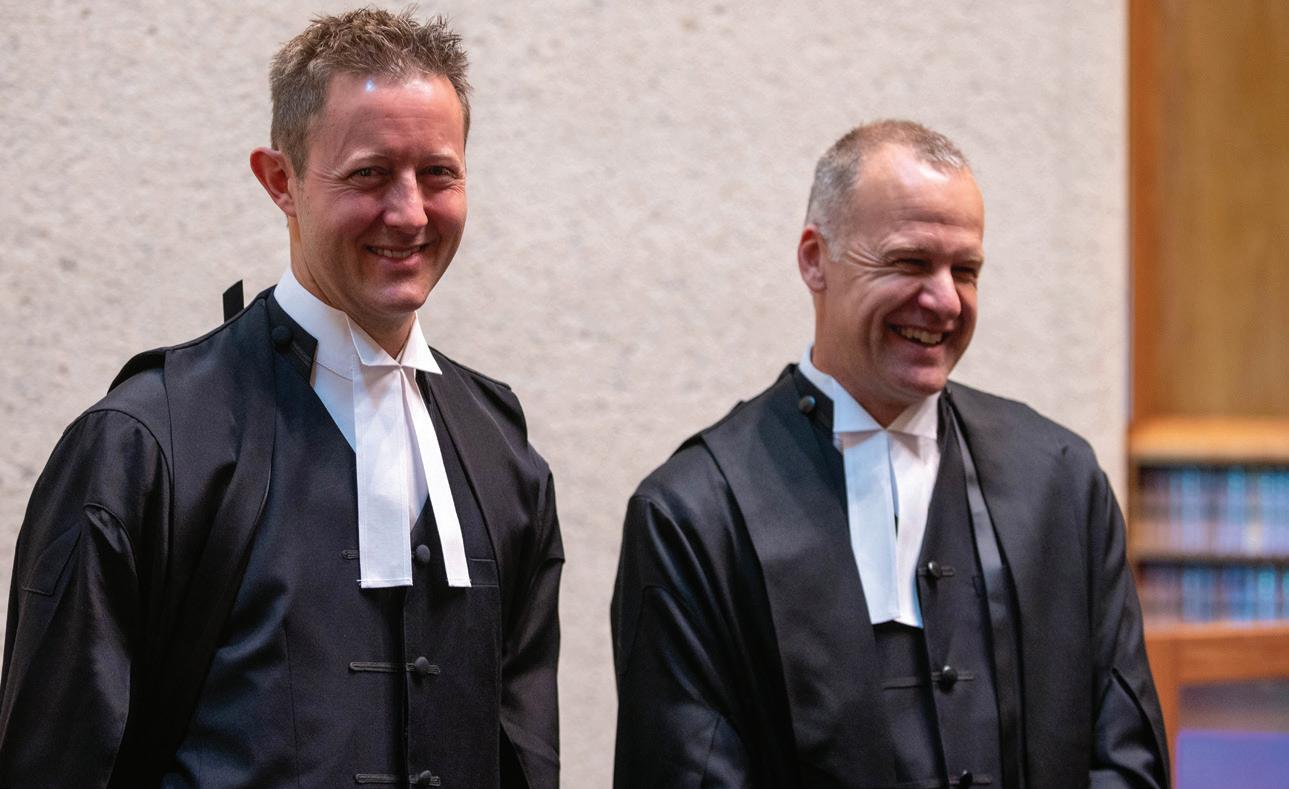
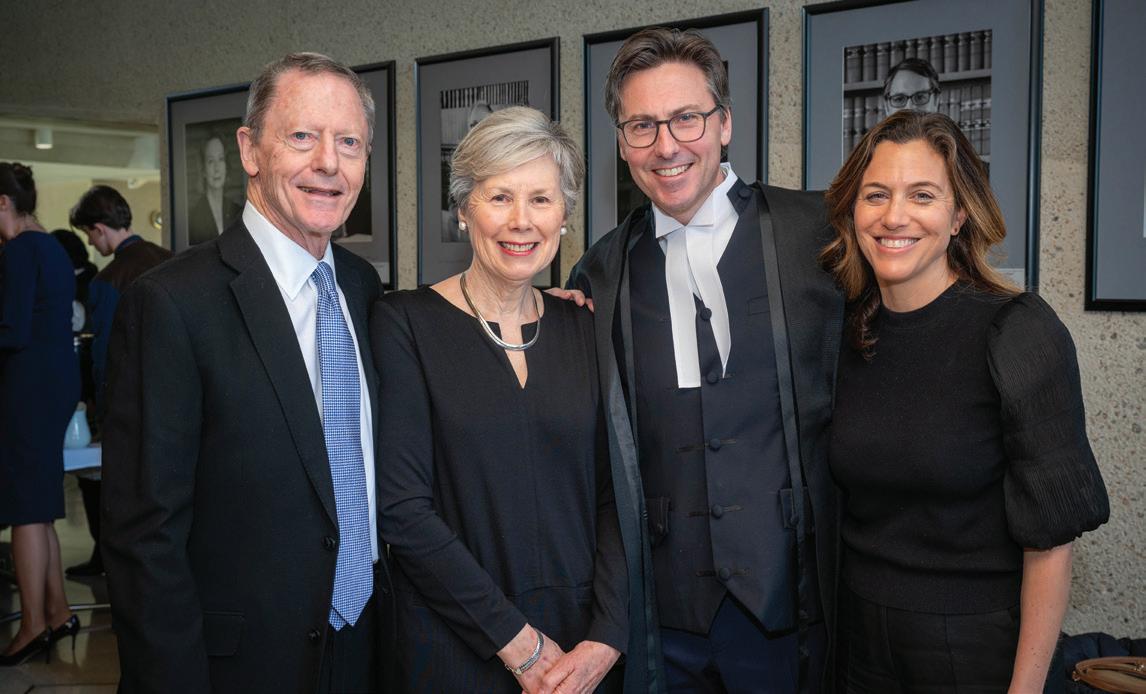
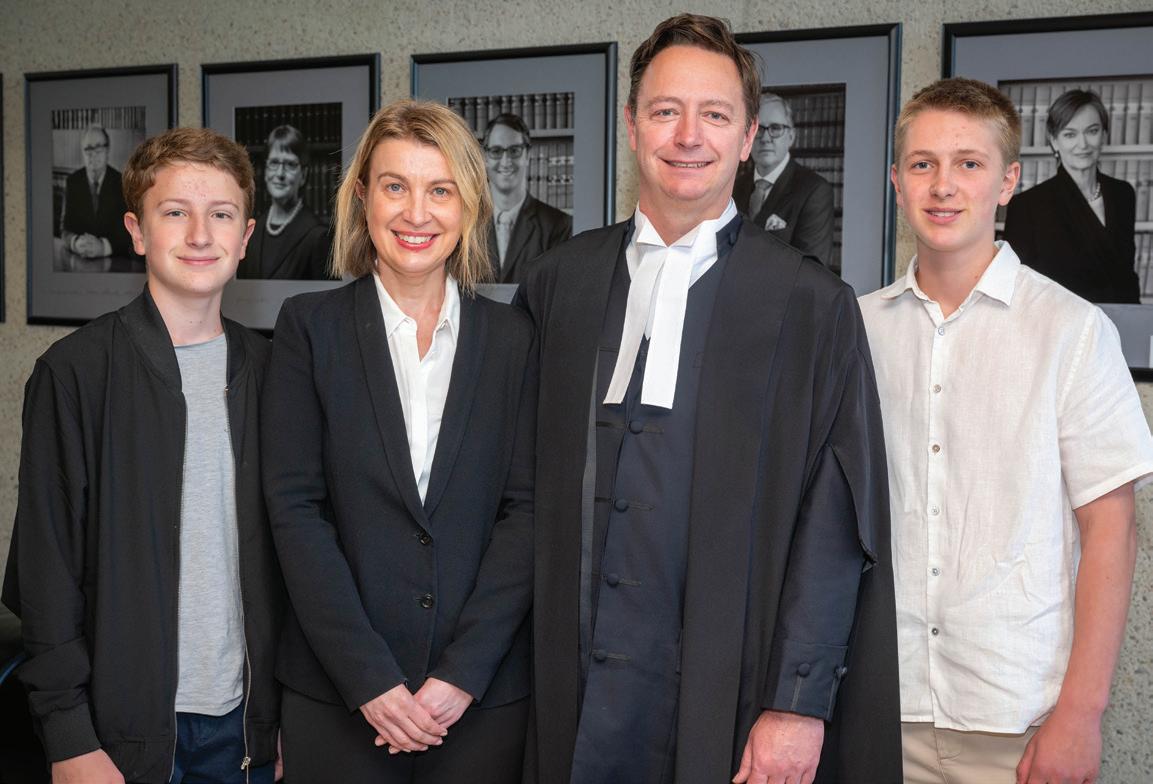

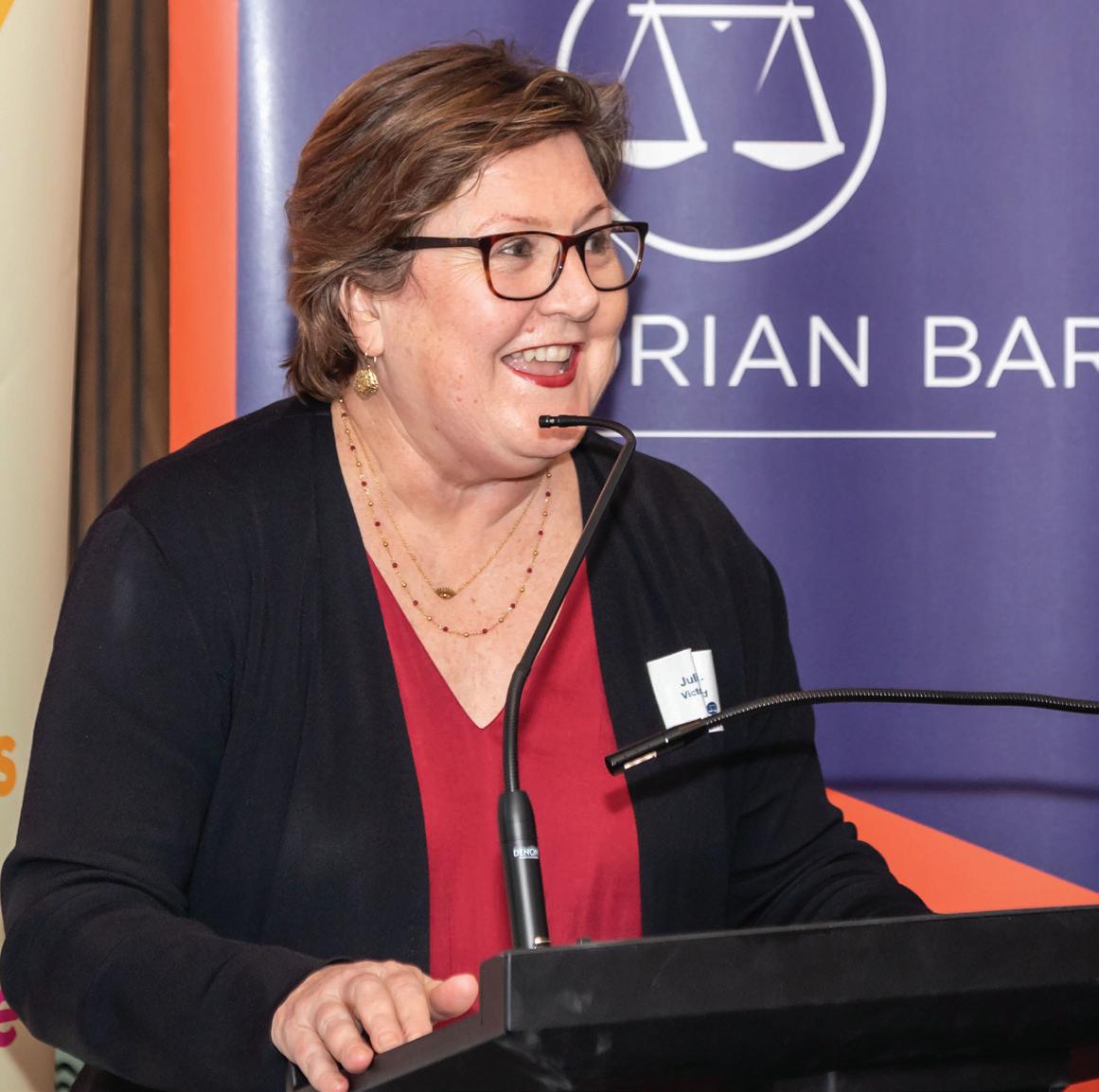
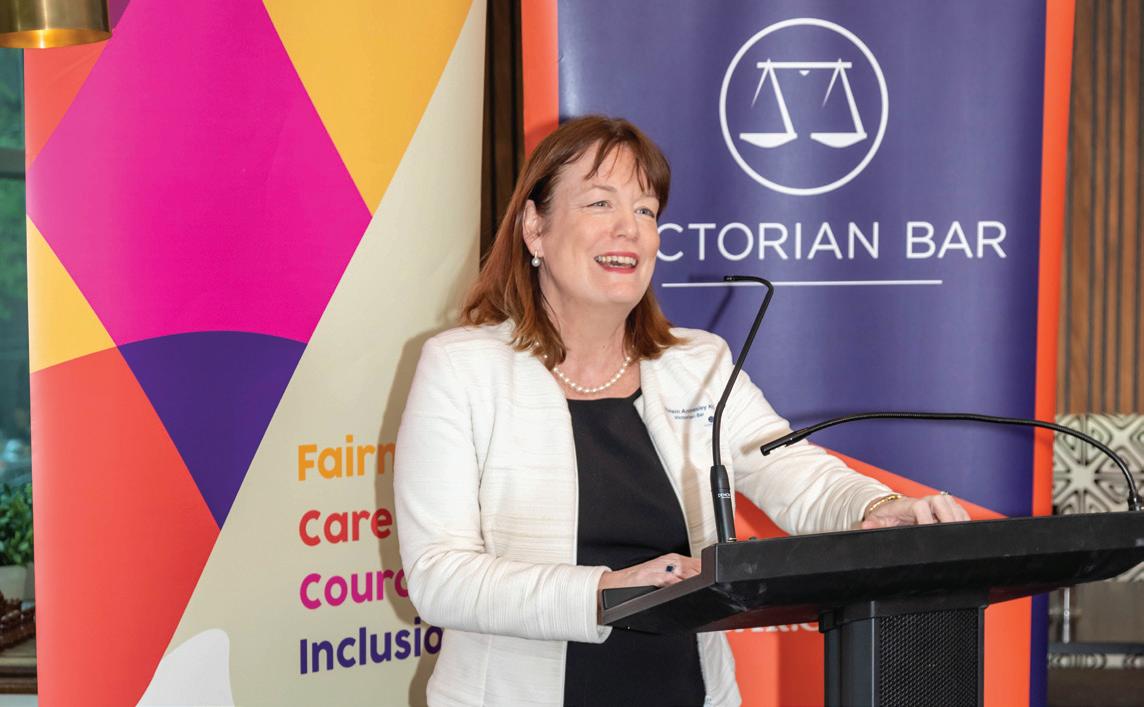


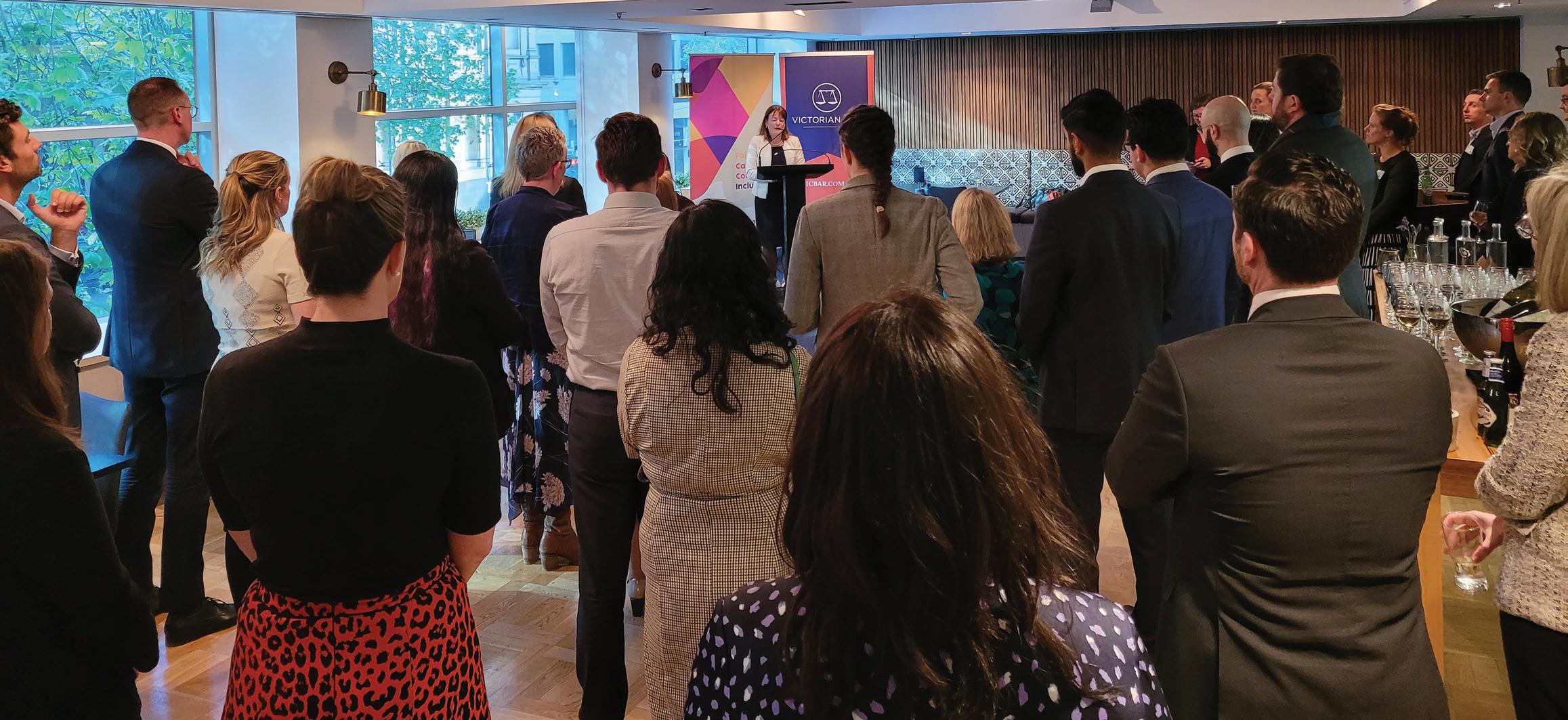
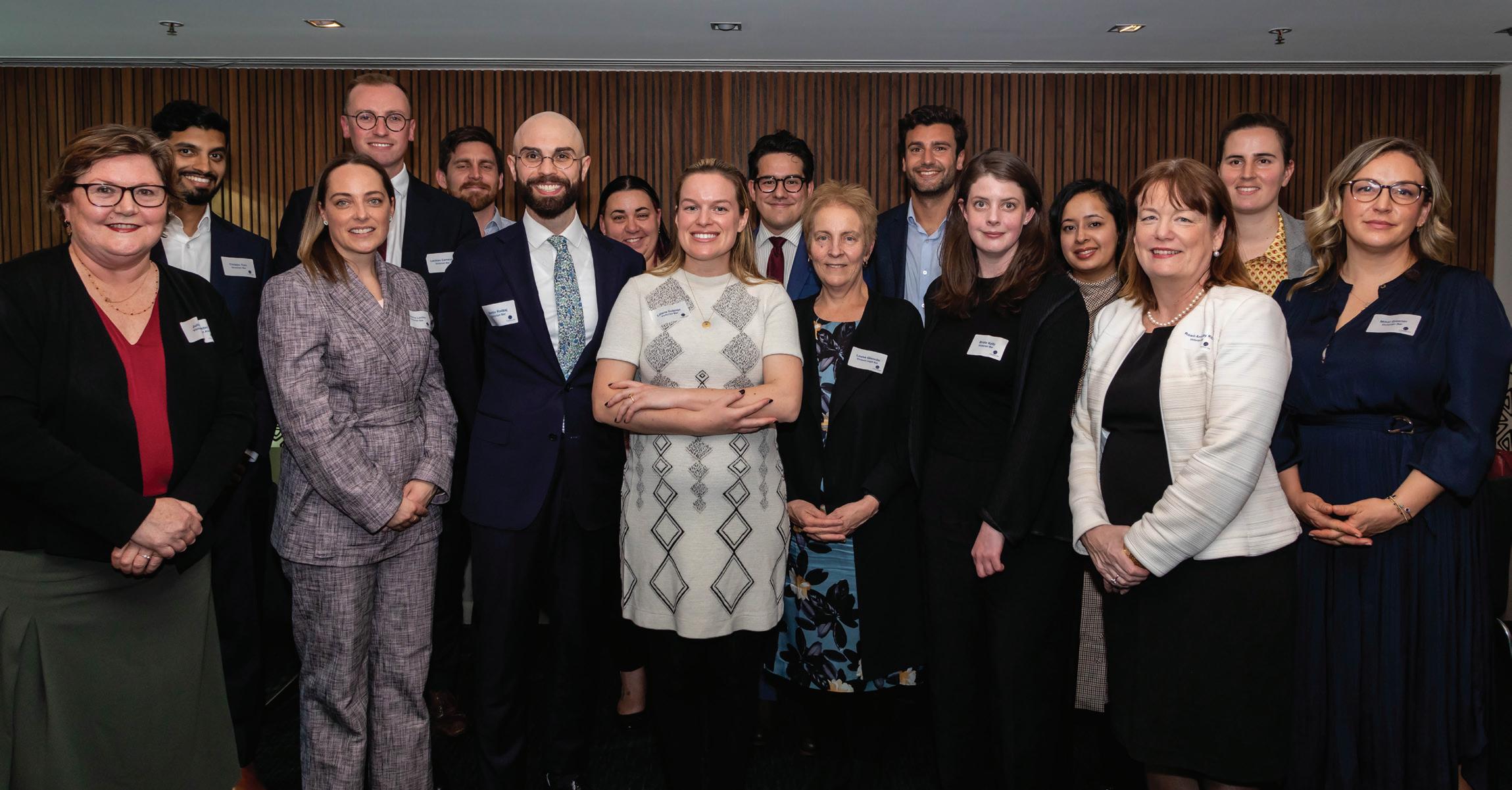
We have officially launched this year’s Trial Counsel Development Program, with women and diverse counsel making up more than half of the 15 places for junior counsel.
It’s the eleventh year of the program which provides training opportunities to the selected junior counsel, by partnering them with senior trial advocates in criminal trials.
In congratulating this year’s cohort, Victoria Legal Aid CEO, Louise Glanville, said the program is one important way to improve gender equity and diversity in the legal profession.
"I have a passion for ensuring that we have a diverse profession," she said.
"We really do need a strong Victorian Bar, and strong public defenders as well, to really support the work of the courts and ultimately for the purposes of serving the Victorian people."
The program is a joint initiative of Victoria Legal Aid and the Victorian Bar.
Róisín Annesley KC, the president of the Victorian Bar, said the program provides a wonderful opportunity for the junior counsel who are selected to participate.
"The program will give you every opportunity to do what juniors do best, which is to improve your advocacy, help with your written submissions under the guidance of really very capable leaders."
Victoria Legal Aid Chief Counsel, Julia Munster, is one of the 50 lead counsel who provide feedback and mentoring to the program’s participants:
"Criminal trials are rewarding but increasingly complex and trial counsel often carry a burden. I am grateful for the experienced counsel who mentored me early in my trial practice and enjoy doing the same for less experienced
advocates, who are the future of our profession."
"It is great to work with advocates in further developing their written and oral advocacy, to jointly develop case theories and pre-trial arguments, share forensic decisions, prepare cross-examination and addresses, and strategies for managing stresses and challenges."
The Parliamentary Secretary to the Attorney-General, Enver Erdogan MP told the event that programs to increase the number of experienced trial counsel were critical to help the justice system respond to the ongoing impacts of COVID-19.
"This program and the commitment of Victoria Legal Aid to increasing equity through its briefing protocol, go a long way to ensuring there is structural support for candidates to succeed as trial counsel, based on talent and hard work.’

LINDA DESSAU, GOVERNOR OF VICTORIA
First, I acknowledge the Traditional Owners of the land on which we are gathering, and I pay my respects to their Elders, past and present, and to Elders of other communities who may be with us this evening.
On this occasion, when the Victorian Bar marks the demise of Her Majesty Queen Elizabeth II, we acknowledge the longest serving British Monarch in history. We reflect on a life of service. We appreciate a relationship with our nation and, in particular, with the State of Victoria—an enduring relationship across more than 70 years.
The phone call that I received at 2.23am on Friday 9 September will be forever etched in my mind.
Across my seven-plus years in this role, we had discussed and planned each step of response, were that phone call to come during my time in office.
There was nothing disrespectful in that. Her Majesty herself, ever the pragmatist, had been involved in much of the planning for the events surrounding her passing, and the funeral arrangements in Britain.
Here, it was important, in order to ensure continuity of government and to follow accession formalities, as well as to arrange respectful mourning protocols.
When that phone call came, however, it was a shock.
Although 96 years of age, Her Majesty’s strength, energy and resilience imbued us with a sense that she could live forever. Of course, that was never to be, even though we had so recently seen her warm smile, as she greeted the 15th British Prime Minister of her reign.
In these last weeks, much has been written about Her Majesty—about her unwavering devotion to duty, her wit and her warmth, her wisdom and kindness, her grace and her dignity.
And her connection with our State of Victoria.
The widespread feeling of grief upon her passing has been palpable.
Tony and I have been privileged to meet with some of the thousands of Victorians who formed a steady stream across many days, as they lined Government House Drive to sign Condolence Books, to leave floral tributes and items, (including some Paddington Bears—one even sporting an attractive Crown!), or as they wandered through our commemorative exhibition in the State Drawing Room.
They were old and young, from different backgrounds, from different parts of our city and state and all with their own different stories.
A busload of folks from aged care were amongst the first to arrive.
On the day after she died, we chatted with three generations of an Indian Victorian family. The youngest clutched a bunch of purple flowers. “The Queen’s favourite colour,” she told us. Handwritten on the paper around them, was the simple note, “We love our Queen”. The little girl told us she liked the Queen because “She was kind, and had a really big job”.
We met a young man in his twenties, in a wheelchair, with a mate by his side. He told us he was here because he had “nearly met the Queen”.
He explained that he had been a patient in the Royal Children’s Hospital when Her Majesty opened the new building in 2011, and he had been thrilled to be one of the patients chosen to meet her. But he was too seriously ill on the day, and the disappointment had stayed with him.
We spoke with a uni student. We’d noticed him quietly reading the various notes and messages that people had left. He was overcome with emotion as he explained that his father had been one of the Coldstream Guards who had served the Queen. And that his grandfather had served her father, King George VI.
Being Melbourne, that Saturday afternoon saw footy final fans too, who had detoured “to pay their respects” on their way to the G.
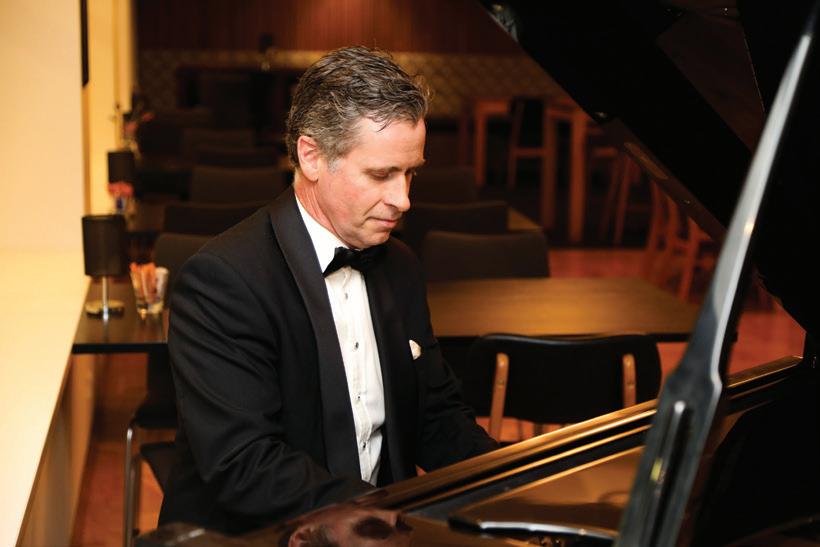
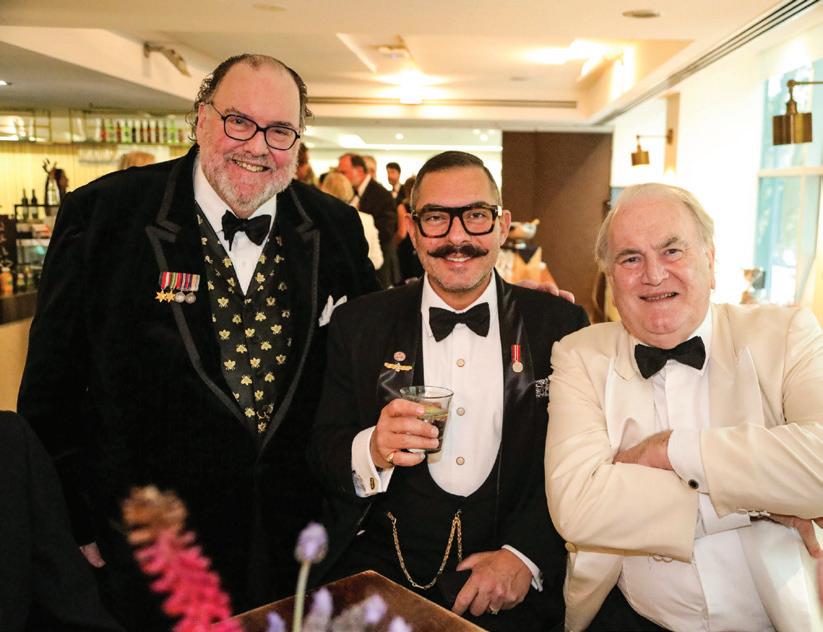
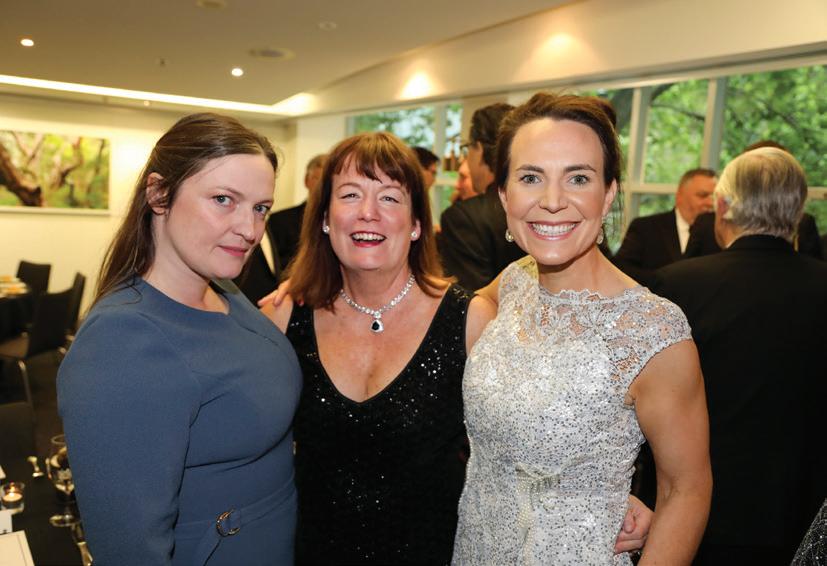
One woman simply offered her view that: “The Queen must have felt emotions like us; she just didn’t let them get in the way of her duty and service.”
A nice perspective.
And then there were just all those who had memories of the Queen’s visits that they wanted to share. Where they were when they saw her. How old they were. Who they were with. How long they’d waited to catch a glimpse.
It is no wonder that so many of us hold memories of Her Majesty’s visits.
She visited Victoria on 11 occasions.
The first, in February 1954, saw Victorians enthusiastically greeting a recently crowned Monarch, a young married woman of 27—a mother of two still very young children.
On her last visit, in October 2011, we welcomed a monarch and world leader of some 58 years, married for almost 65

years, the mother of four adult children, grandmother of eight and, by then, a great grandmother too.
We remember her, and some met her, in the course of major events and important civic occasions. Her Majesty was the first sovereign—in fact, the only one—to open the Victorian Parliament: the second session of the 39th Parliament of Victoria, on 25 February 1954.
During that same visit, she dedicated the new Second World War Forecourt and World War II Memorial, and lit the Eternal Flame, at our Shrine of Remembrance.
As well as opening the Royal Children’s Hospital building in 2011, The Queen had also opened its previous home in 1963, graciously noting it as “a monument to Victoria’s humanity and public spirit”.
And in a charming moment in 2006, when Her Majesty was here to open the
18th Commonwealth Games, the Queen’s baton—had travelled 180,000 kilometres around 71 nations of the Commonwealth from Buckingham Palace to Melbourne— was presented to Her Majesty by one of our most renowned former Olympians, the Honourable John Landy, the 26th Governor of Victoria at the time.
The Queen and HRH Prince Phillip’s visit in 1954 represented the first by a reigning monarch. There was much anticipation.
On the afternoon of 24 February, an estimated one million Victorians (about 40 per cent of the state’s population at the time) lined the streets from Essendon Airport to the city to greet them. Many had camped out overnight to secure the most advantageous position.
The royal couple stopped at Essendon Town Hall, Parliament House and the Melbourne Town Hall, to hear three speeches of welcome.
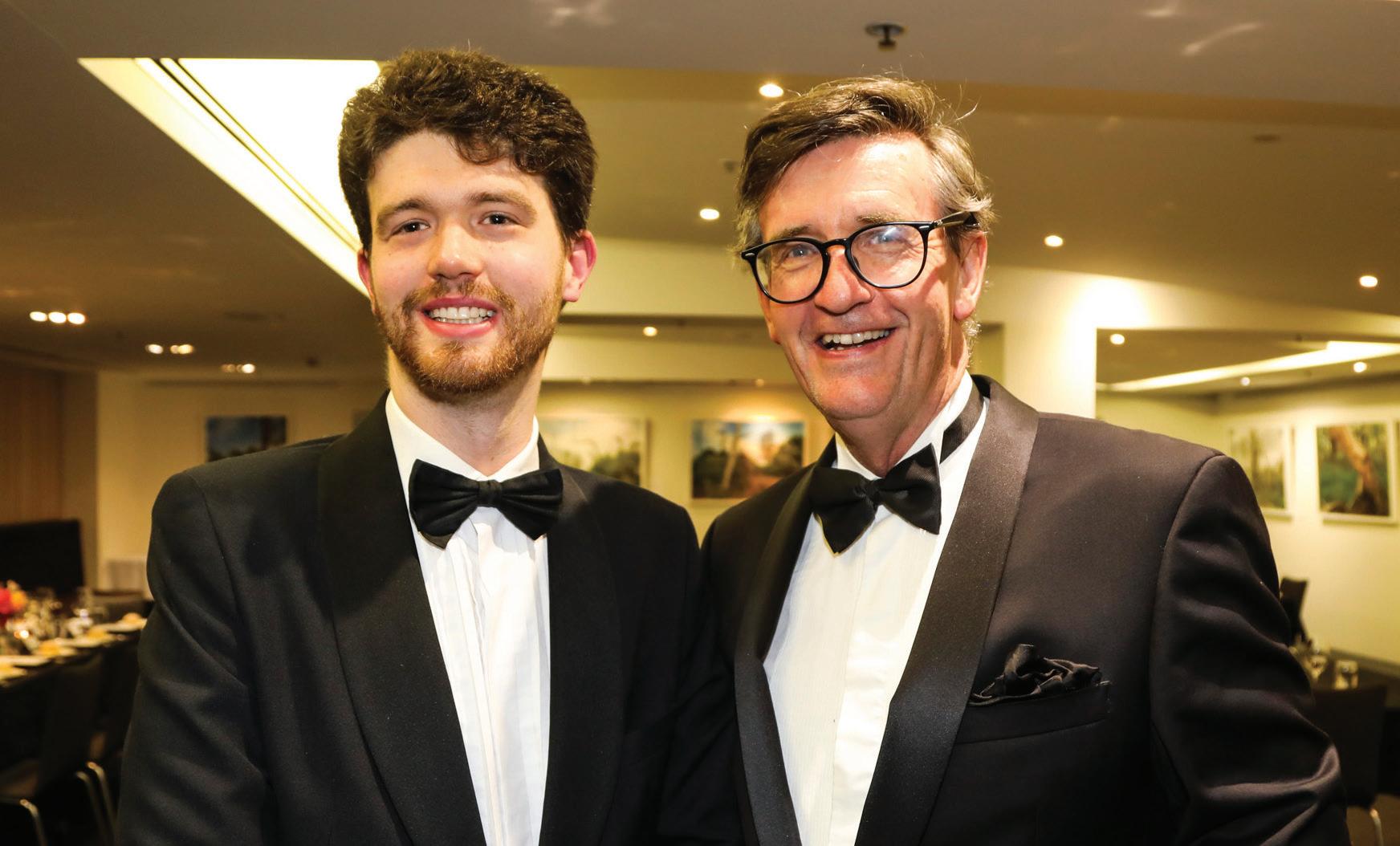
The Age reported it as ”The Greatest Day in Melbourne’s History”. And that the vast crowds “sounded like the roaring of the sea”.
The Queen’s legendary work ethic was apparent from that very first visit.
Their Majesties traversed much of the state. On one day alone, they visited Benalla, Shepparton, Echuca, Bendigo, Rochester, Castlemaine and Maryborough. (Perhaps that reminds you of how some members of counsel used to manage their briefs.)
The public excitement was high, wherever they travelled.
Nearly 100,000 people lined the streets of Bendigo to catch a glimpse of Her Majesty. And in a fit of superlatives, The Bendigo Advertiser hailed the visit the ”proudest, supremest moment this city has known”.
As an aside, I note that the royal couple travelled aboard the Victorian Railways Royal Train. State Car No 5—as it was known—first saw service during that royal tour but was used by Victorian governors for their own country tours thereafter. No longer today!
In talking of Victoria and Her Majesty in the same breath, it’s impossible not to mention a shared love of sporting events.
When Tony and I were fortunate enough to meet her in 2015, sport was a natural and lively topic of conversation between us.
Michelle Payne, just weeks earlier, had become the first female jockey to win the Melbourne Cup, and the Queen was well across that.
Racing was not the only sporting event to attract Her Majesty during her visits to Victoria.
Amongst the many that she attended, the Queen, with HRH The Duke of Edinburgh, and TRH Prince Charles and Princess Anne, were the first members of the royal family to attend a Victorian Football League game, when they went to see Fitzroy play Richmond on 5 April 1970 at the MCG. (It was the first game played on a Sunday, specially arranged to fit in with the schedule of the Royal Tour.)
Half-time was extended to 40 minutes so that the players could change their jumpers, wash their hands and comb their hair before being introduced to the royals. It’s said that it was also to enable some to put in their teeth, but I’m not sure if that part is accurate.
Former player and coach, John Northey, tells a lovely story that Richmond president Ray Dunn who— some at this Bar will remember was never lost for a word in his criminal practice—apparently became over-awed by the occasion and a bit tongue-tied when introducing the players.
Northey said: “When he got to me he forgot my name … He said, ‘Your Majesty this is, is, is ... and Billy Brown was standing beside me and little Billy said, ‘He is John Northey, I’m Billy Brown, how are we today?’”
It is extraordinary when we look back to the Coronation on 2 June 1953.
On the night of the Coronation, some 650,000, almost half of Melbourne’s

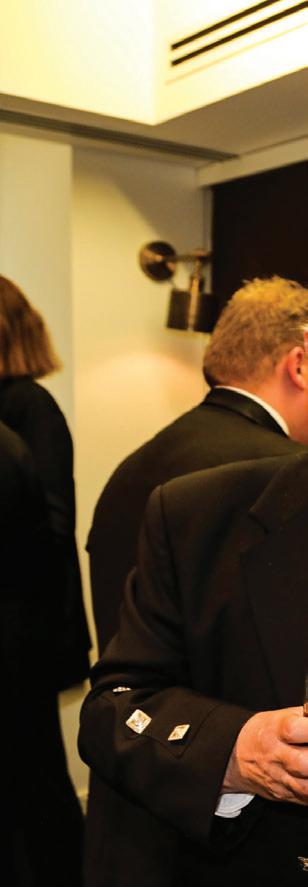
population of 1.4 million, filled the city.
The Argus headline the next morning, colourfully described Bourke Street as like ”a giant sardine tin”.
A headline a little deeper in that paper has caught my eye. It read: ”Do-si-do for Sir Dallas”, with the accompanying article describing that, “Melbourne’s celebrating thousands roared and stomped their approval as the Governor, Sir Dallas Brooks and Lady Brooks joined in square dancing in the streets…”!
Throughout Victoria, in the days surrounding the coronation itself, there were public ceremonies, church services, exhibitions, pageants, balls and gatherings, a Trooping the Colour at Princes Park and, of course, a reception at Government House.
To recognise the occasion, coronation medals were awarded as a personal souvenir by Her Majesty, to 2,300 Victorians who had made a significant contribution to the community. Amongst those recognised were the Governor and Lady Brooks, and John Cain Snr (the Premier of the day). Sir Charles Lowe, Sir John Latham, and Sir Owen Dixon were recipients too.
At the Proclamation and Accession Ceremony held at Government House on the Monday following the Queen’s passing, I spoke to those present and those watching the livestream, in an address from which much of what I say this evening is borrowed.
I noted then that, given how the world had changed, combined with the sombre
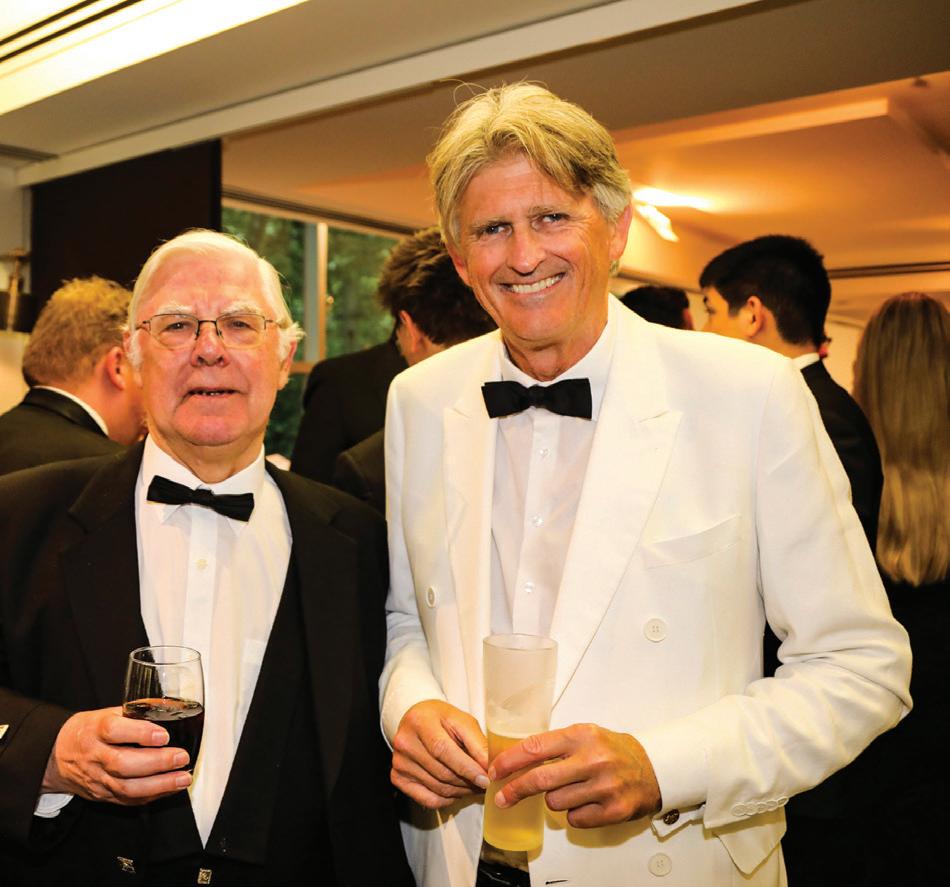
nature of the occasion, people were unlikely to gather in the way that had been seen almost seven decades before.
I was of course correct that our community is notably more diverse than it was all those decades ago. And correct that, with technology, we are more used to the momentous moments of history being played out in our loungerooms, rather than in the streets.
But I had not predicted just how many would gather, whether in Great Britain or here, in quiet remembrance. Or that the funeral service would be watched by a global audience reckoned at more than four billion people.
Much has been written about Her Majesty’s life and the number of duties, events, places and people that were a part of it.
The numbers are astounding.
She met regularly with her many prime ministers and with countless heads of state and ambassadors. She signed nearly 3,000 bills into law. She visited some 117 countries.
It is impossible to calculate how many millions of people she met, at home, in the commonwealth, in her realms and in her territories, and around the world.
We can’t estimate how many people were touched when she received their floral bouquet, shook their hand or waved to them from a car, a plane or a ship.
But the numbers will never tell the most important part of the story. The part about Her Majesty’s impact. Quite simply, how she made people feel.
How a boy in hospital was touched because he had “nearly” met her. That
Despite global changes, despite the changing face of ‘us’ as Victorians and despite our appetite for honest and reasoned discourse on our past, our present and our future, there is widespread appreciation of Her Majesty’s sense of duty, and her devotion to a lifetime of service.
a little girl felt that she was kind. That a student was overcome with emotion, just by knowing that his father and grandfather were given the honour to protect her.
Or all those she visited in times of crisis. Those she mourned beside. Those she congratulated, thanked or honoured. Those who received messages of support when needed, (as happened many times here in Victoria). All of us who enjoyed her wit and her humour, whether playing along with 007 or Paddington Bear.
And how she touched all of us who observed her strength—and her grace— at times of the utmost personal and public tragedy or challenge.
Despite global changes, despite the changing face of ‘us’ as Victorians and despite our appetite for honest and reasoned discourse on our past, our present and our future, there is widespread appreciation of Her Majesty’s sense of duty, and her devotion to a lifetime of service.
I am sure that every one of us— although many were not yet born at the time—can recite the words of the 21-year-old princess who pledged to devote her whole life, whether it be short or long, to our service.
It was a promise made and a promise magnificently kept, with the Queen fulfilling her duty right up to the end of what was, thankfully, a long life.
As we mourned the passing of Her Majesty Queen Elizabeth II, we offered our condolences to His Majesty King Charles III, as well as our support for his own pledge of duty.
When His Majesty’s mother ascended the Throne, we welcomed a queen—a young woman—whose grooming for the role had been unexpectedly cut short
with the untimely death of her father.
With the accession of King Charles III, we have welcomed a man who, for many decades, has walked beside an exemplary sovereign and has been living his own life of service.
We have also welcomed a king who spent part of his formation here in Victoria. A monarch who forged his own special connection with us when, in 1966, he attended the Timbertop campus of Geelong Grammar School.
It is a connection promoted by his visits since. And the messages of support that he has given, including recently when we faced the challenges of a global pandemic.
It is a connection kept through the personal relationships maintained by His Majesty here.
Friendships with former classmates and teachers.
Relationships with those he has met or worked with over the years, including our former Official Secretary, Joshua Puls MVO, who served TRH The Prince of Wales and the Duchess of Cornwall, (as they were then), as Assistant Private Secretary from 2012 to 2014.
The King has pledged himself to duty for the remainder of his life, following the “inspiring example” set by the Queen in “upholding constitutional government” and seeking ”the peace, harmony and prosperity” of his peoples.
I have now had the privilege to meet with the King at Balmoral Castle. He was well informed about our state and curious for updates about the issues that matter to us. I was left in no doubt about his own dedication to service and his commitment to the people he serves…for as short or as long as his reign may be.
And we wish him well.
VBN
Dr Michael Wolff recently scaled Mount Everest. The editors have scoured the archives and are convinced that he is the first member of our Bar to do so. We are sure readers will join us in congratulating him on this epic achievement.



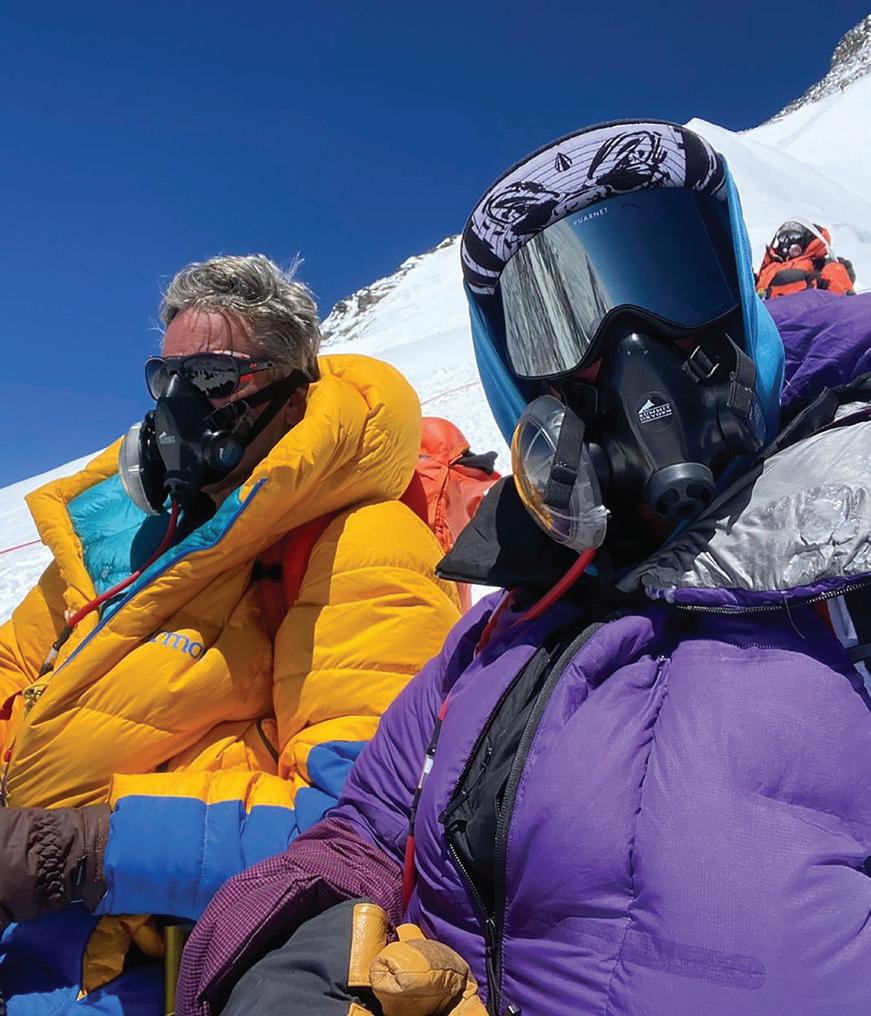







An “incredibly generous” assortment of wigs, robes, gowns and jabots have been donated by members of the Victorian Bar to the Solomon Islands Public Solicitor’s Office (PSO).
The gift was organised by Dirk Heinz and William Kadi who now work for Pacific Legal Network (PLN).
A Monash University law graduate, Dirk spent 14 months as a volunteer lawyer in Honiara working alongside William, a local environmental defender.
The duo advocated for the rights of landowners in their battle against degeneration of their countryside by illegal logging across the archipelago of more than 900 islands.
The PSO is the equivalent of legal aid in Australia and in a country where up to 90 per cent of the population either cannot access or afford private legal representation, the PSO offers a critical public service. The Victorian Bar has previously assisted the PSO with training and seminars.
The donation of several dozen pieces of legal apparel from Victorian Bar members reconfirms an ongoing commitment to their colleagues in the Solomon Islands. Donated items included personal messages of support from the donors to the recipients.
A much-appreciated contribution was also made by Ludlows Legal Regalia.
During his time volunteering Dirk met John Ridgway, founder of PLN, which provides the only coordinated legal service across the Pacific Islands region.
Dirk and William continue to support the PSO in whatever capacity they can through their work with PLN.
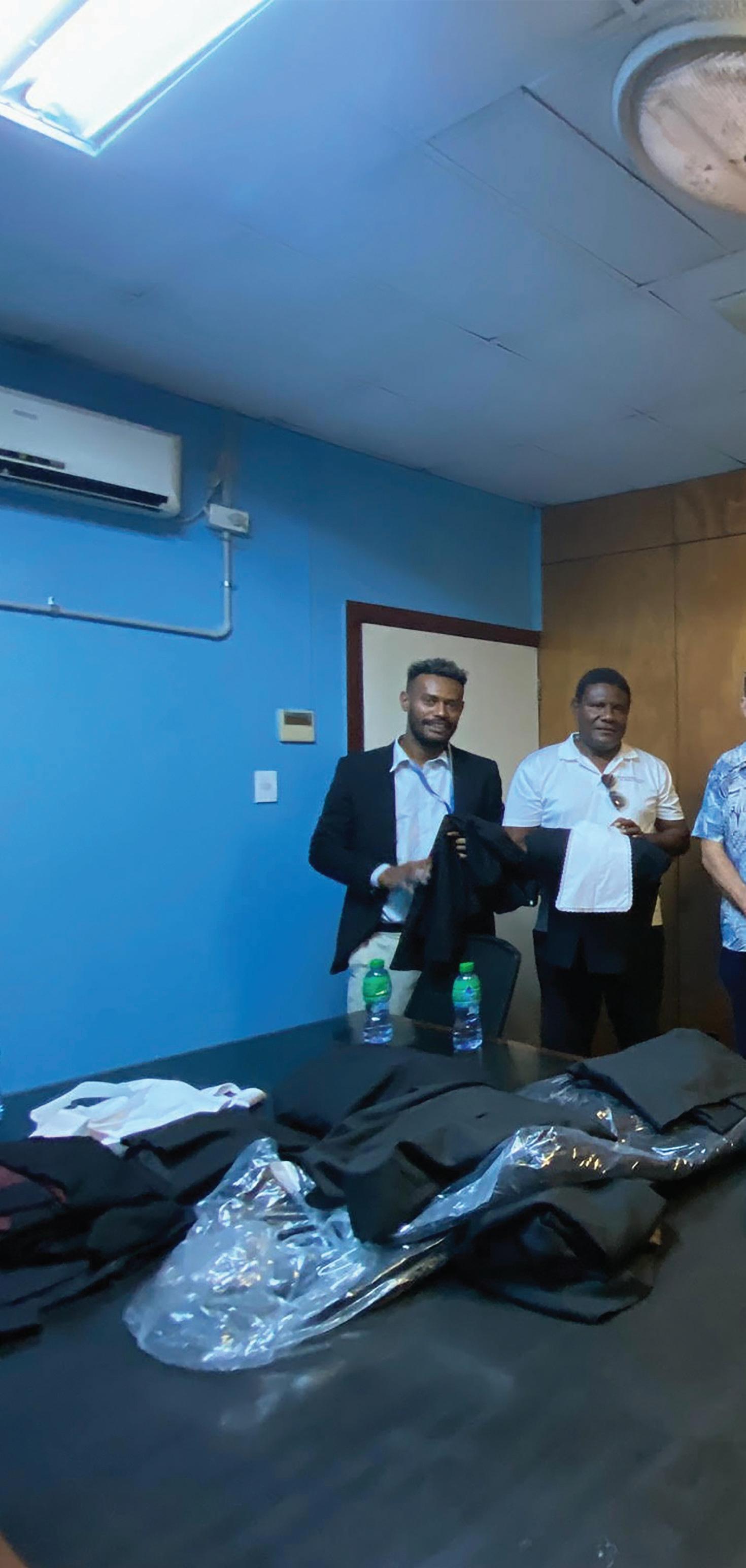
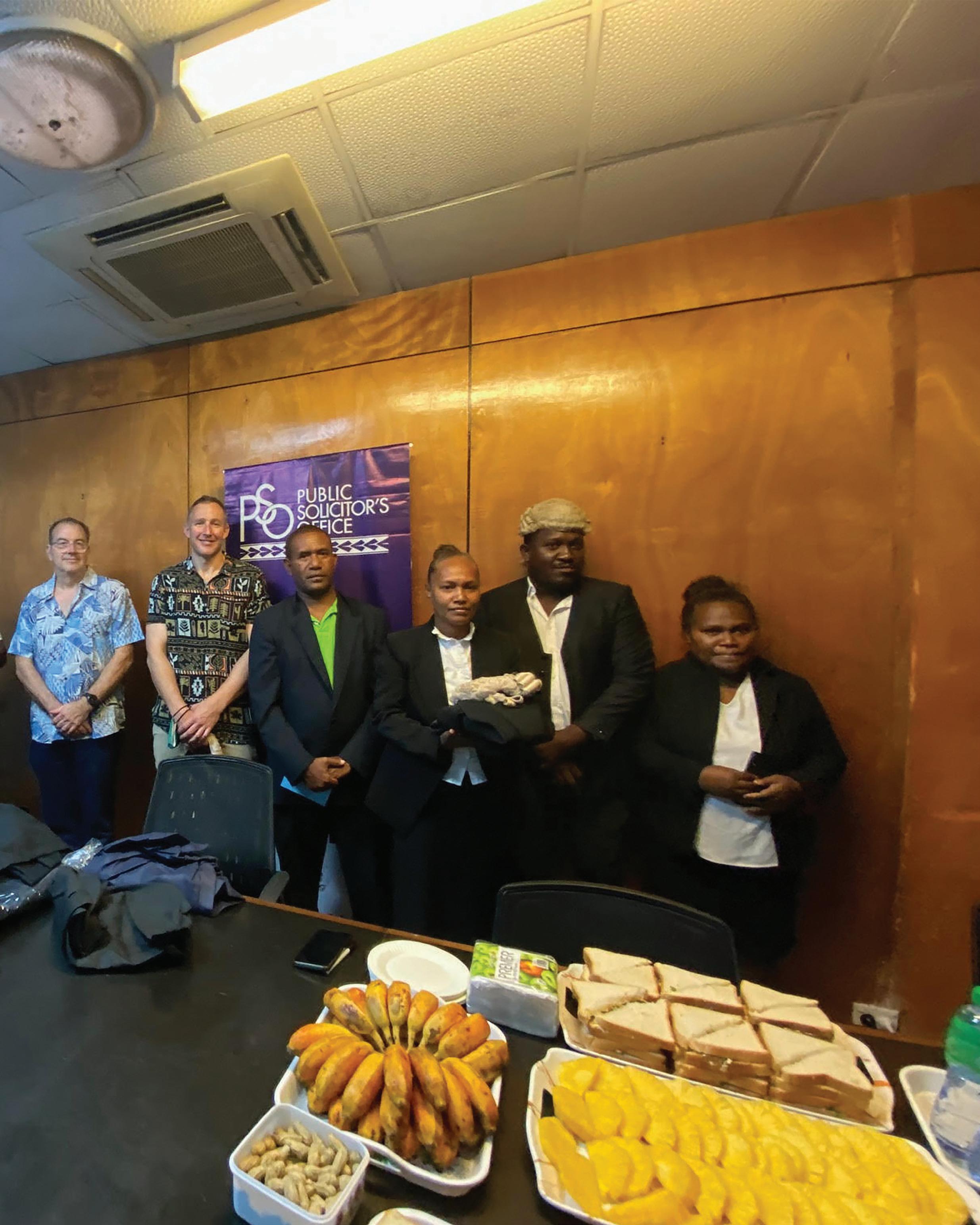
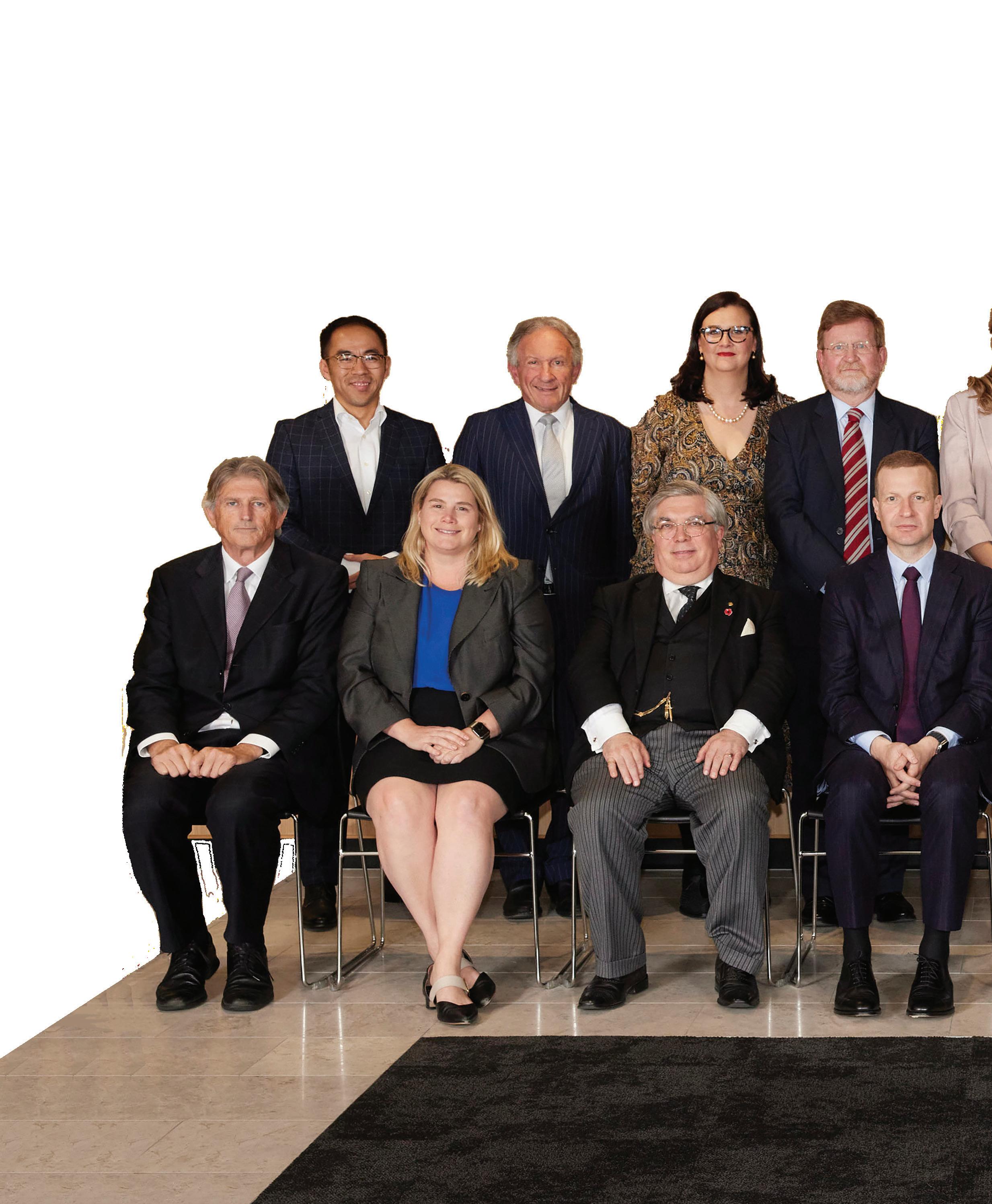
BACK ROW L-R: Daniel Nguyen, Gavin Silbert KC, Dr Michelle Sharpe, Peter Chadwick KC, Jessie Taylor, Alistair Pound SC, Raini Zambelli, Ffyona Livingstone Clark, Dr Sue McNicol AM KC
FRONT ROW L-R: Darryl Burnett, Catherine Boston, Mark Robins KC, Sam Hay KC, Elizabeth Bennett SC, Rishi Nathwani, Nawaar Hassan, Ashlee Cannon
ABSENT: Georgina Schoff KC, Colin Mandy SC, Timothy Goodwin, Andréa Skinner
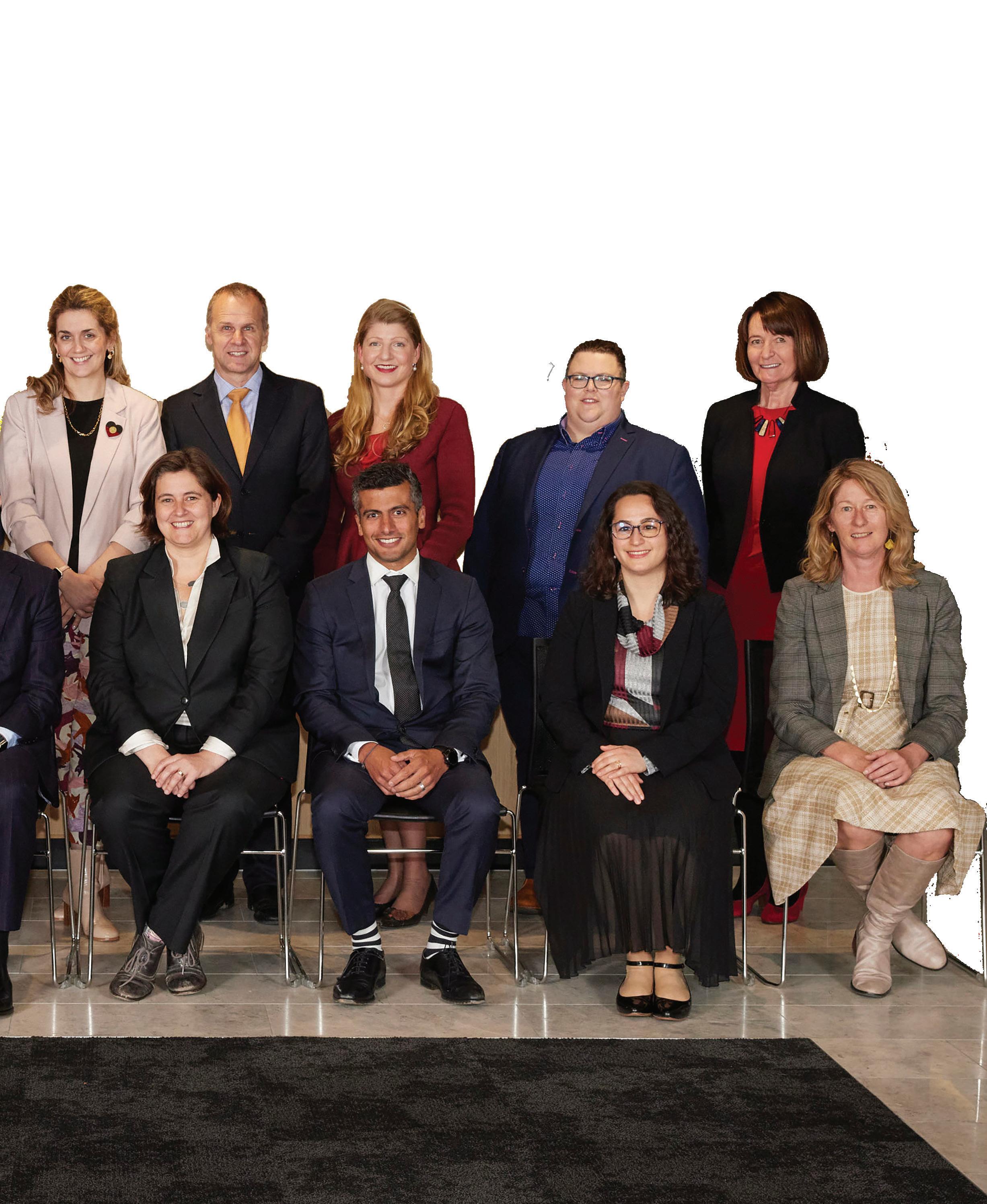
JUSTICE JOHN DIXON
..the Bar is no ordinary profession or occupation. These are not empty words, nor is it their purpose to express or encourage professional pretensions…[you are] by virtue of a long tradition, in a relationship of intimate collaboration with the judges, as well as with … fellow-members of the Bar, in the high task of endeavouring to make successful the service of the law to the community. That is a delicate relationship, and it carries exceptional privileges and exceptional obligations.1
In Bolitho v Banksia Securities No 18 (the remitter), 2 the minor players in the events of that group proceeding seemed puzzled that they could suffer consequences through a fraud perpetrated by the leading players.
I discussed this in Re Zita. 3 When you sign the Bar Roll, you reaffirm the implications of a Full Court order that you be admitted to the Roll of Legal Practitioners. You are accepted as a fit and proper person to always properly discharge your duty to ensure the proper administration of justice, no matter what the challenge.
The expression “duty to the court” is a bit of misnomer because the duty, properly understood, is to ensure the proper administration of justice, which is an element of good governance that all Victorians are democratically entitled to expect. It is a foundational objective of courts to ensure that justice occurs. Before I continue, I want to stress the importance of carefully analysing and understanding the pre-reading that we set. You have already carefully considered Part 2 of the Civil Procedure Act 2010 when preparing for, and sitting, the Bar entrance exam. The paramount duty and the overarching obligations are statutory expression of the duty to ensure
the proper administration of justice as it applies to those persons identified by section 10. From the tenor of correspondence between solicitors that is regularly exhibited to affidavits before the court, it is not clear that the true nature of the obligations and duty is properly understood. They are not aspects of a duty of care, nor are they a series of baseball bats to be used to attack your opponent.
It will be apparent to you from reading David Ipp’s article4 that the paramount duty and the overarching obligations have a long pedigree in the common law. I will come back to this. My immediate point is that David Ipp’s article is essential, indeed compulsory, reading for anyone who wants to appear in court as an advocate. That obviously includes all of you.
You will not always know when an ethical obligation or a possibility of conflict with your duty to the proper administration of justice is lurking and about to ensnare you. My first point is that you must be educated about such matters. Being informed about the myriad ways in the past in which the courts have commented on or enforced the advocate’s duty to the proper administration of justice is essential knowledge to protect you personally from adverse consequences, and to ensure the proper function of the justice system.
It is no coincidence that the common law tradition of setting ethical standards for lawyers emerged simultaneously with the legal profession in the thirteenth century. There has been remarkable consistency in the content of ethical regulation since that time. The six enduring concepts are
» fairness in litigation;
» competence;
» loyalty;
» confidentiality;
» reasonable fees; and
» public service.
The persistence of these foundational concepts throughout history is a consequence of the central role of lawyers and their relationships with each other and with the court. Issues of competence, confidentiality, loyalty and fees have always been central to the relationship between a lawyer and their client. Issues of absolute integrity, honesty, frank disclosure, absence of misleading conduct and of conflict of interest, and proper basis have always been central to the interaction between lawyers and courts.
There are many statements by judges encapsulating these concepts and expressing their importance and they can be found in David Ipp’s article and in the cases decided since that article was written.
In Giannarelli v Wraith,5 Mason CJ in the course of affirming that at common law the advocate is immune from suit emphasised that an advocate’s duty to their client was always subject to their overriding duty to the court, which
evinces a strong element of public interest. Later in D’Orta-Ekenaike, 6 the plurality noted the relevant context of the duty to the court: that judicial power is exercised as an element of the governance of society.
Mentioning those cases reminds me that you are all well aware that in Australia advocates enjoy immunity from suit. That immunity is no longer absolute. While it has not been washed away, as in the UK since Arthur JS Hall & Co v Symons, 7 the signs of erosion are evident.
I would remind you, firstly, of the court’s inherent jurisdiction to enforce the ‘duty to the court’ made clear in the speeches in Myers v Elman 8 Enforcement can occur through wasted costs orders or more extreme measures such as striking from the Roll those who are not fit and proper persons to remain on it.
Secondly, section 29 of the Civil Procedure Act 2010 creates a jurisdiction that enables the court to make a variety of orders when it is satisfied that there has been a breach of an overarching obligation. This jurisdiction is unique to Victoria and there is a growing body of cases that examine how it works. I don’t want to go there today. I have said a bit in my judgments where you can read and consider my analysis of that Act.
I said earlier that your first skill for discharging your duty to the court is to be knowledgeable and educated. The second point I seek to emphasise is that an ethical dilemma can often be anticipated and then avoided. The usual harbinger is the presence of conflict, whether between duties or between duty and interest.
Courts expect that advocates are not conflicted, and although that is true about duties owed to litigants, I am referring to conflicts with duties to ensure the proper administration of justice. Our adversarial system functions on the necessary condition that litigants have the assistance of independent legal representation. When loyalties are divided, advocates can no longer act with perfect good
faith, the absence of which is a cancer on public confidence in the administration of justice.
My third point is that knowledge, information and anticipation and preparation merely inform judgment. Lawyers must exercise judgment. Matters for consideration may range from determining what points are reasonably arguable, what parts of the evidence assembled by the solicitor and the client are properly relevant, or whether the manner or style of presentation to the court may be misleading. Circumstances requiring judgment can be very complex, for example how to properly represent a client whose witnesses intend or are likely to give false testimony. The duties to the client and to the court can be finely balanced and the path that properly honours all obligations can appear to be like a tightrope over shark-infested waters.
My fourth point is that there are at least two qualities of judgment that I would presently emphasise. The first is that judgment must be independent. The second is that courage is often required. There are many lawyer jokes with punchlines constructed around the choice between ethical duty and a pot of gold, but when reduced to a joke, the essence of courage in an independent ethical response is lost.
While your integrity, knowledge, intuition and application will normally guide you to the correct response, sometimes help is needed. In many senses a good advocate must be fearless, and being fearless often requires courage. Standing your ground against a senior lawyer who may be influential in your family’s future financial welfare or against a senior silk whose skills and experience you greatly admire may require that you exhibit all of these qualities, and in spades, but your obligations to the proper administration of justice demand no less.
My final point is to remind you that, as stockbrokers used to say, as soon as your investment turns south,
sell up. Your first loss will be your smallest loss. If you feel that a claim lacks a proper basis or you may have misled the court, your duty to the court is to confront that situation and rectify it and the sooner you do so the better. Mostly, attempts to rectify an admitted error are well regarded. Everyone can make mistakes, people with integrity face up to the consequences of their actions immediately. Judges talk about the qualities of barristers as much as barristers talk about the quality of judges. It is valuable to be discussed in the back corridors of the court as an advocate with integrity who dealt with a difficult situation than as one who created additional problems by covering up.
Ensure that you take time to properly assess the situation on mature reflection, the initial catastrophising may then seem absurd and the proper course of conduct may well become clear and approachable.
At the Bar you are never alone. There are support mechanisms. The ethics committee can help you. Seeking a ruling from it may protect you. Rely on the collective wisdom available to you. Discuss ethical issues with your colleagues, in particular with your mentors. Sometimes having a senior practitioner intercede on your behalf may be necessary to achieve the proper discharge of your obligations.
1 Ziems v The Prothonotary of the Supreme Court of NSW, (1957) 97 CLR 279, 298 per Kitto J.
2 [2021] VSC 666.
3 [2022] VSC 354.
4 David Ipp, “Lawyers’ Duties to the Court”, (1998) 114 LQR 63.
5 (1988) 165 CLR 543.
6 (2005) 233 CLR 1.
7 [2002] 1 AC 615.
8 [1940] AC 282.


LACHLAN ARMSTRONG
Several years ago I wrote a short article that tried to explain the history of the “right to bear arms” in the Second Amendment to the US Constitution, and the impact it has on the ability of Congress and State legislatures to pass meaningful gun-control laws.
The article seemed a tolerably accurate summary back in 2016, and in the years since.
But it turns out it was mostly wrong.
So there are three reasons for attempting a little update to the earlier note.
First, the gun problem in the USA—what I previously called ‘the American predicament’—is a tragedy and one on which everyone seems to feel free to voice confident opinions. But the opinions, at least in Australia, are rarely informed and that does the Americans a disservice. I suggest that, as lawyers, we at least should do better.
Second, my earlier attempt to explain the US law turns out to have reflected a body of case law that their Supreme Court has just up-ended. That June 2022 decision—Bruen1—is the particular prompt for this article.
Third, the earlier review of Second Amendment jurisprudence turned out also to provide an overview of some important principles (or methods) of constitutional interpretation in the US. Understanding it gives some insight into other horror stories, like the recent overturning of Roe v. Wade, 2 which drag in other “Bill of Rights” elements and frankly are beyond the modest aspirations of your present humble correspondent.
As lawyers in a liberal democracy, we can hardly criticize that approach. But if this was such careful and well-structured jurisprudence, what has changed?
So those are the three reasons for writing now—it is topical, the law has changed, and the change gives some insight into other things going on over there.
Discussion about change necessarily begins with ‘the before-times’, so I will try to summarise my 2016 summary.
We can skip now over my sketch of the historical circumstances leading to the adoption of the Second Amendment in 1791, and its extension to bind State legislatures via the Fourteenth Amendment in 1868. The essential point is that the wording of the Second Amendment offers two competing interpretations.
One focuses on its reference to “militia” and concludes that the right is a narrow one, relating to States’ powers to organize what Australians might call local Army Reserves. But the second holds that the reference to militia simply identifies one specific reason why a more general, individual right should not be infringed.
My earlier article noted that for many years the narrower view seemed to prevail, albeit that there was little Supreme Court authority on the point. Then in 2008, in a decision called Heller, SCOTUS emphatically rejected the narrow view.3 It held that the Second Amendment acknowledged a broad individual right to keep and bear arms, and protected it from federal regulation. And in a later decision, McDonald, the Court confirmed that the Fourteenth Amendment protected that broad right against infringements by State legislatures as well.4
The interesting question then for lawyers5 was how the Americans manage any gun-control legislation in the face of those Supreme Court rulings. I tried to explain that the
lower courts in the years since Heller had adapted other principles of constitutional law to develop a twostep test for determining whether a particular gun-control measure was constitutionally permissible.
In the first step, the courts would ask whether the statute or regulation imposed a type of restriction that was analogous to laws in place in the American Colonies at the time the Second Amendment was adopted in 1791, or in the young States when the Fourteenth Amendment was adopted in the aftermath of the Civil War. If it was, then the constraint was likely to be permissible.
But if the restriction did not have a clear analogue in that history, a second question arose. It was whether the challenged law imposed an “undue burden” on the underlying constitutional right.
The “undue burden” test was applied using a “means-end” analysis. This required the courts to “scrutinize”:
whether the challenged restriction related to conduct close to the “core” of the constitutional right, like the right to keep a handgun in the home for self-defence, or something more peripheral, and whether the restriction was a severe one like a ban, or a milder one like a licensing requirement.
For non-core rights with mild restrictions, rational basis scrutiny required only that the regulation be rationally related to a legitimate public interest. At the next level, intermediate scrutiny required the relevant government to demonstrate a reasonable fit between the law and a substantial government objective or public interest. For restrictions going to “core” concerns like self-defence in the home, strict scrutiny required the government to prove the restriction was narrowly tailored to achieve a compelling public interest.
I suggested, in the end, that as lawyers we should be cautious in criticizing the “insanity” of American gun laws. The Heller interpretation of the Second Amendment might not be the one we prefer, but no fair-minded person could say it is legally unreasonable. And once that concession is made, as it must be, we must likewise acknowledge that the post-Heller lower-court decisions reflected thoughtful, principled attempts to balance that constitutional right against fully-articulated concerns about public safety. The post-Heller law was not that gun-control measures are impossible, only that the US Constitution requires that they be carefully justified by cogent evidence. As lawyers in a liberal democracy, we can hardly criticize that approach. But if this was such careful and well-structured jurisprudence, what has changed?
The facts in Bruen were simple. A longstanding ordinance in New York prohibited private citizens from carrying firearms in public without a special permit obtained by demonstrating some acute need distinct from the needs or preferences of the wider public. And even when that need was demonstrated, the licensing officer had a discretion—was a “may issue” rather than “shall issue” jurisdiction.
The plaintiffs had no special need. They just wanted to carry handguns while going about their daily lives, for possible self-defence. The State ordinance blocked that, so they challenged its constitutionality.
The lower courts dismissed the challenge on a summary basis, applying earlier intermediate authority called Kachalsky6 Kachalsky had applied the usual post-Heller two-step analysis: (first step) although the permit requirement had been around since about 1905, it had no close analogue to laws existing in 1791 or 1868 so it
presumptively infringed the Second Amendment right; and (second step) on the question of what level of “scrutiny” to apply, the core of the Second Amendment was the right to keep arms for self defence in the home, so a licensing requirement relating to arms in public places was in the mid range of the spectrum of “burdens” on the underlying right. “Intermediate scrutiny” (aka “heightened scrutiny”) applied. This was translated as an enquiry whether the permit system “substantially related to the achievement of an important government interest”. The Kachalsky appeal court accepted it was. The public-carry restrictions “passed constitutional muster”.
When Kachalsky was deployed to grant summary dismissal in Bruen, the Bruen plaintiffs appealed. And since Kachalsky applied the postHeller two-step analysis, the Bruen appeal squarely raised the question whether the two-step analysis was in fact a correct extension of the original Heller ruling.
And in characteristically blunt terms, the six conservative justices forming the majority in Bruen emphatically ruled that the two-step approach “was one step too many”.
Unsympathetic to the grumblings from lower courts that Heller had not seemed to define the rules of scrutiny to apply in Second Amendment cases, the majority insisted that Heller had in fact made clear the focus had to be “constitutional text and history”, and had explicitly rejected the kind of means-end analysis that had subsequently emerged.
The Bruen majority then re-set what presumably is the new test for assessing the constitutional validity of gun-control laws. There are two “relevant metrics”:
» first, does the challenged law impose on the right of armed self-defence a burden that is
comparable to regulatory models in sufficiently common use in the 1790s or, perhaps, the 1860s?
» second, is the justification for the challenged modern law comparable to that which might be discerned as having supported any historical predecessor?
Applying that test to the New York ordinance, the starting point was to enquire whether the regulation constrained the right to keep and bear arms.
On this issue the majority rejected a contention that the Second Amendment was really about guns in the home. They made the notunreasonable point that while “keep” might indeed focus on the private sphere, “bear” tends to suggest a public activity. The New York restriction on public carry did, therefore, burden the constitutional right.7
The next question—the first ‘metric’—was whether the “may issue” permit regime had an analogue in laws predating 1790 or 1860. That is, was it a “comparable burden” to some historical precedent?
Here the majority organised the evidence into discrete chapters—the pre-1790s English law inherited by the American Colonies, the pre-Revolution legislatures’ own enactments, the post-Revolution States’ laws subsequent to the Second Amendment, the State and Federal laws leading up to 1868 and the Fourteenth Amendment, and finally the post-1860s laws.
The historical review seems comprehensive, and assuming that to be so, the majority’s analysis is compelling. The record showed only occasional restrictions on public carry of weapons, and even then their explicit object was to prevent or sanction such public carry as was liable to incite terror in the community. In terms of restrictions on public carry without that ‘terrorising’ element, really the only analogue to the New York ordinance was its own 1905 predecessor.
The Bruen law therefore fell at the first hurdle—it was not a comparable burden to any law extant in the 1790s or, less relevantly, the 1860s. SCOTUS reversed the Second Circuit and remanded the case “for further proceedings consistent with this opinion”. One assumes they will be proceedings of the somewhat truncated variety.
The US law after Heller seemed to take history as its starting point, but thereafter allowed the terms and merit of a law to be assessed entirely by reference to current conditions. Bruen removes that modernising element. Modern gun controls must fit within the analogical bounds of the laws on the books in the 1790s. Moreover, while Bruen’s first metric constrains US lawmakers to the types of regulations that were in common use in the 1790s, the second metric seems more likely intended as a further constriction, not any invitation to re-widen the enquiry. That is, firearms in 1791 might not have been rarer, per capita of population, but they were certainly less lethal than today. Regulatory constraints on self-defence options that might have been justified in colonial times might actually be less justified in modern, well-armed America. The argument is inevitable, that in 2022 the everyday risk of an active shooter with (semi)automatic weaponry makes it more rather than less reasonable for citizens to want ‘public carry’ of their own (semi) automatic weapons, ‘just in case’. Indeed, the ‘comparable justification’ test seems to create an inherent weakness in the Bruen majority’s reassuring remarks that since historical laws had often included prohibitions on carrying firearms into “sensitive places” like churches and schools, modern restrictions to like effect can continue. When churches and schools have become the most notorious venues for “active shooter” atrocities,
there is less justification now for a regulation that would deny parishioners, or teachers or students, some equivalent means of active self-defence.
You cannot question the New Yorkers’ energy. Within barely a week after Bruen, they had passed a suite of amendments to preserve the ordinance. They shifted it from a ‘may issue’ to a ‘shall issue’ regime—but then superimposed such a raft of new criteria that the overall response can only be characterized as an act of very angry defiance.
The principal additional licence conditions fall into three categories. First, applicants must complete an onerous practical training course, and then re-qualify after a prescribed interval. Second, the legislature blew out the list of “sensitive places”, where even a licence does not permit public carry, so that it seems that very few public spaces in Manhattan would not now qualify as “sensitive places”.
Third, and most remarkably, the personal and household information a licence applicant is required to disclose was amended to include a list of all social media accounts held by them over the preceding three years.
Pause to consider that. As one commentator put it, “you can have a gun, but first show us your speech”. I do not see how this could possibly pass constitutional ‘muster’.
At this point I should declare my position, if indeed it is unclear. I think the US gun situation represents an appalling failure of democractic systems. I am so thankful to live in Australia, where access to firearms is a privilege not a right, is expensive, and is closely and continuously regulated. We couldn’t field a militia worth a hill of beans in the event of an emergency, but in the meantime we don’t have litigation over public carry of guns because none of us expects in our daily commutes to encounter anyone else with a gun.
That’s the trade-off we make. So be it. Our primaryschoolers don’t need to practice active shooter drills and first-aid for sucking chest wounds.
So I despair for America in this regard. But their tragedy cannot glibly be blamed on the Supreme Court. Anyone who says the Heller interpretation of the Second Amendment is plainly wrong is kidding themselves. The same applies for Bruen
The weight to be given to text and history in constitutional interpretation is a question on which superbly well-informed minds have differed profoundly and in good faith. And once it is accepted, as it must be, that the majority’s approach is a reasonable one, then I suggest the Bruen majority also makes by far the better argument. The dissent has no real answer, except that,
well, gun violence is a problem. It is, but it is not for judges to rewrite the Constitution.
The problem then is not the Supreme Court’s make-up, or legislators’ preparedness to attempt gun controls, and certainly not the lower courts’ preparedness to uphold controls that are enacted. The problem is that all of them are hamstrung by the Second Amendment itself.
And there is no realistic solution. Fresh constitutional change would require a two-thirds vote of both Houses of Congress or, if two-thirds of the States request one, a majority vote in a convention called for that purpose —and then ratification by three-quarters of the State legislatures, or by three-quarters of similar conventions called in each State. There is zero prospect of that happening.
Constitutions should be hard to change. They need to stand against populist sentiment, and if the Second Amendment were more fragile then so too would be the First and Fifth and Fourteenth Amendments. But surely there is a line, and one cannot help but feel that a democratic system incapable of dealing with such a problem as the Americans face in gun violence is a system that is failing the people.
So if you are inclined to shrug your shoulders, do so now. The reality is that the background tempo of deaths from handguns whether legal or illegal, and the regular high-profile massacres associated with assault rifles, are going to continue—period. There is simply not much they can do about it.
And finally, if you are inclined to downplay all this as a guns issue, pause for a moment. I have explained how Heller and Bruen increasingly confine constitutional permissibility to the statute books of the 1790s and 1860s. How many ‘analogues’ do you suppose we find in those dusty tomes to imply constitutional protection, or authorize federal protection, of abortion rights, rights to contraception, affirmative action programs or LGBT equality?
1 New York State Rifle & Pistol Association, Inc. v. Bruen, No. 20-843, 23 June 2022 (current citation 597 U.S. ___ (2022)).
2 See Dobbs v. Jackson Women’s Health Organization, No. 19-1392, 597 U.S. ___ (2022) (24 June 2022).
3 District of Columbia v. Heller 554 US 570 (2008).
4 McDonald v. Chicago 561 US 742 (2010).
5 A low bar.
6 Kachalsky v. County of Westchester, 701 F. 3d 81 (2012).
7 The Court barely paused in reiterating that Heller had obliterated any argument that the Second Amendment was only concerned to protect the firearms technology of 1790, ie., muskets. The right to bear arms means such arms as might be in common civilian use by the time a law is passed to regulate them. If AR-15 type firearms were ever to be prohibited or meaningfully restricted, it probably needed to happen in the mid 1960s, before the ‘Armalite Rifle’ mechanism meant that semi-automatic longarms—previously heavy things tolerable only in the armed services—became lightweight, simple, cheap, and hugely popular.
LUCY LINE
Members of the profession, the judiciary and the academy have worked over the last two years to create a digital platform which places at practising barristers’ fingertips high quality journal articles, and judicial speeches specifically chosen for their potential utility in Victorian proceedings: https://www.judicialcollege.vic.edu. au/resources.
The journals regularly reviewed by the editor include: Alternative Law Journal, Australian Bar Review, Australian Business Law Review, Australian Law Journal, Cambridge Law Journal, Criminal Law Journal (Australian), Journal of Law and Medicine, Law Institute Journal, Law Quarterly Review, Melbourne University Law Review, Modern Law Review, Monash University Law Review, Oxford Journal of Legal Studies, and research papers from the Victorian Parliamentary Library Service.
Examples of articles many barristers might not chance upon but for the initiative are Thomas Prince’s recent two-part article in the Australian Law Journal, ‘Recurring Issues in Civil Appeals’, and Hasan Dindjer’s

article in last year’s Modern Law Review, ‘What Makes an Administrative Decision Unreasonable?’
Speakers at the launch of Scholarship for the Legal Community observed that academic and extra-judicial writing is rarely relied upon by counsel. Further, academic writing is not commonly cited in judgments. Nevertheless, it is well accepted that legal scholarship is indispensable in understanding the underlying principles of an area of law and that it can therefore help guide the correct application of law to real life problems. Many judges have indicated a receptiveness to having academic work cited in court.
Many of the articles are freely available and hyperlinked. For subscription only resources, users are taken to the Law Library of Victoria website where registered users can access the articles for free.
The Judicial College has helpfully and concisely summarised 21 of the articles so far on its website.
Areas of law presently addressed are: contracts, corporations, torts; criminal law, evidence, equity, trusts and estates, public law, competition law, consumer law, and indigenous legal issues. The most recent included resources are given prominence. Older materials may be found by clicking the ‘archived material’ hyperlink.
TSAMUEL BURT, PETER O’FARRELL AND MAYA ROZNER
he role of the International Advocacy Training Committee is to advise and assist with the provision of advocacy training in the South Pacific and assist members of the legal profession of other countries.
The Victorian Bar has been presenting advocacy skills training workshops in PNG since 1990 when a team led by the late Robert Kent QC first travelled to Port Moresby.
This year, a group of 10 representing the Victorian Bar spent a week during November 2022 in Port Moresby, Papua New Guinea to deliver the 22nd Civil and Criminal Intensive Advocacy Skills Training Workshop to 81 students at the PNG Legal Training Institute (LTI).
Students attend the Workshop as part of the LTI’s year-long pre-admission training course. This year’s students are nearing completion of their professional training year and admission to practice.
The Program was delivered as part of the PNG Australia Law and Justice Partnership, which is jointly funded by the Australian Government and the LTI.
The group is pictured below with Victorian Bar Readers’ Course PNG Alumni Tauvasa Tanuvasa,
who is now the PNG Solicitor General, outside Parliament House in Port Moresby.
During the Workshop the LTI students demonstrated inquiring minds and determination to learn. Their attention during class was consistently focused and their questions were thoughtful and precise. Their collective endurance for long days of learning was remarkable, as well as the care they showed the group from the Victorian Bar. They were hungry for self-improvement and determined to make the most of the opportunity to work with the VicBar team to try out new advocacy approaches and grow in confidence.
The staff and students at the LTI provided a highly organised and coordinated approach to the delivery of the Workshop and the VicBar Group were greatly assisted by the PNG Alumni of the Victorian Bar Readers’ Course. The team were also grateful to JSS4D and Cardno for providing well organised security and transport throughout their stay.
A WhatsApp group was established to connect all PNG representatives who have completed the Victorian Bar Readers’ Course. The alumni were pleased to meet each

other and discuss ways in which they can assist with advocacy training of students and local solicitors in the future. It is hoped that this network and connectivity will greatly assist moving forward.
The generosity extended to the VicBar Group by the staff and student at the LTI was further extended by the invitations to attend the new Supreme Court facilities, the Solicitor General’s Office and Parliament House. At a moment’s notice, staff from these facilities educated the VicBar group on the legal and bureaucratic frameworks of these central PNG facilities in the administration of Justice and Government in PNG.
The 81 LTI students, who named themselves ‘Team 81’, were provided with several opportunities to perform individually, including opening submissions, evidence in chief, cross examination, plea making and closing submissions.
Feedback was provided to students and recorded so that changes in the performance of the students over the course of the week could be monitored. There was an obvious improvement in the student performances during the delivery of the Workshop.
Women in particular face many difficulties in PNG where domestic violence and patriarchal cultural practices are widespread. Two out of 118 elected parliamentarians in PNG are women. The near equal gender mix in the LTI student cohort was therefore encouraging.
The return to face to face delivery allowed VicBar to provide the students, and in particular the women students, with encouragement and strategies for empowerment and developing confidence in their abilities in the presence of their peers. It was exciting to see the confidence of the students grow. The VicBar members conducted the Workshop in a way that demonstrated leadership in respectful relationships between students and coaches of both genders

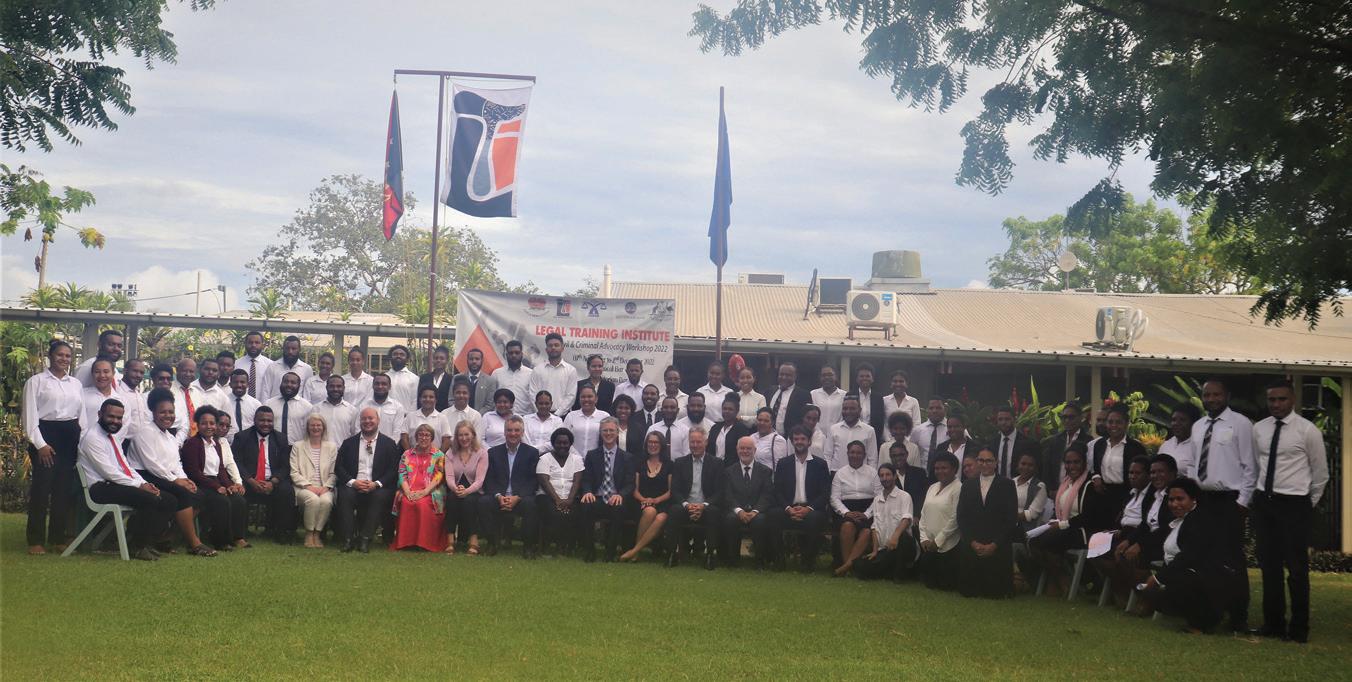
and which sought to illustrate the importance of respect and diversity in the law.
The VicBar Group were honoured to represent the Victorian Bar and very pleased with the improvement of the students that was exhibited over the course of the week. In turn, the VicBar Group learned a lot from the students and local people they encountered across a range of legal, government, cultural and social situations.
A formal dinner was hosted by the LTI with guests including representatives from:
» the PNG Judiciary
» the PNG Solicitor General
Tauvasa Tanuvasa
» the LTI Council
» the Australian DFAT and High Commission
» the PNG Centre for Judicial Excellence
» JSS4D
» Members of the PNG Legal Fraternity
» A number of PNG Alumni of the Victorian Bar Readers Course including Anthony Roden Paru (2022 Alumni) who spoke at the dinner about his journey in the law from university, through the LTI, into practice and the Victorian Bar Readers’ Course.
The VicBar Group was hosted and greatly assisted by the leadership of Angelyn Paranda, the Acting Director of the LTI, together with her wonderful staff and students, who were well prepared for the Workshop. Ms Paranda’s organisation and leadership made the logistics of the week very easy for the VicBar Group.
The VicBar Group were humbled by the opportunity to represent the Bar in PNG and left Port Moresby determined to continue to foster the relationships that were built upon and are essential to the continuing success of these training opportunities.

“Stalking is not well understood in our society, and many people do not even realise that it is a crime. People who experience stalking often do not report it, and when they do, they often fail to receive the help that they need. For too long, the response to stalking has relied heavily on victims taking action to avoid being stalked. We need to shift the focus to the people who commit the crime.”
Chair of the VLRC, the Hon Tony North KC.

VLRC
The VLRC was asked to review Victoria’s legal responses to stalking, harassment and similar conduct. The report’s focus is on non-family violence stalking and the Commission was asked to look at the personal safety intervention order system, what prevents the law from effectively responding to these behaviours, and how to improve the law and justice system’s response to the behaviours.
The Commission considered other reforms and the findings of other inquires, including the Royal Commission into Family Violence, and the Royal Commission into Victoria’s Mental Health Systems. The Commission received 115 submissions and 254 responses to an online form asking about people’s experiences of stalking.
The 238-page report contains forty-five recommendations, including improvements to the personal safety intervention order system, and amendments to the Crimes Act to make the offence of stalking clearer and easier to apply.
The Stalking Final Report was tabled in Parliament and published online on 21 September 2021. The report is available at www.lawreform.vic.gov.au
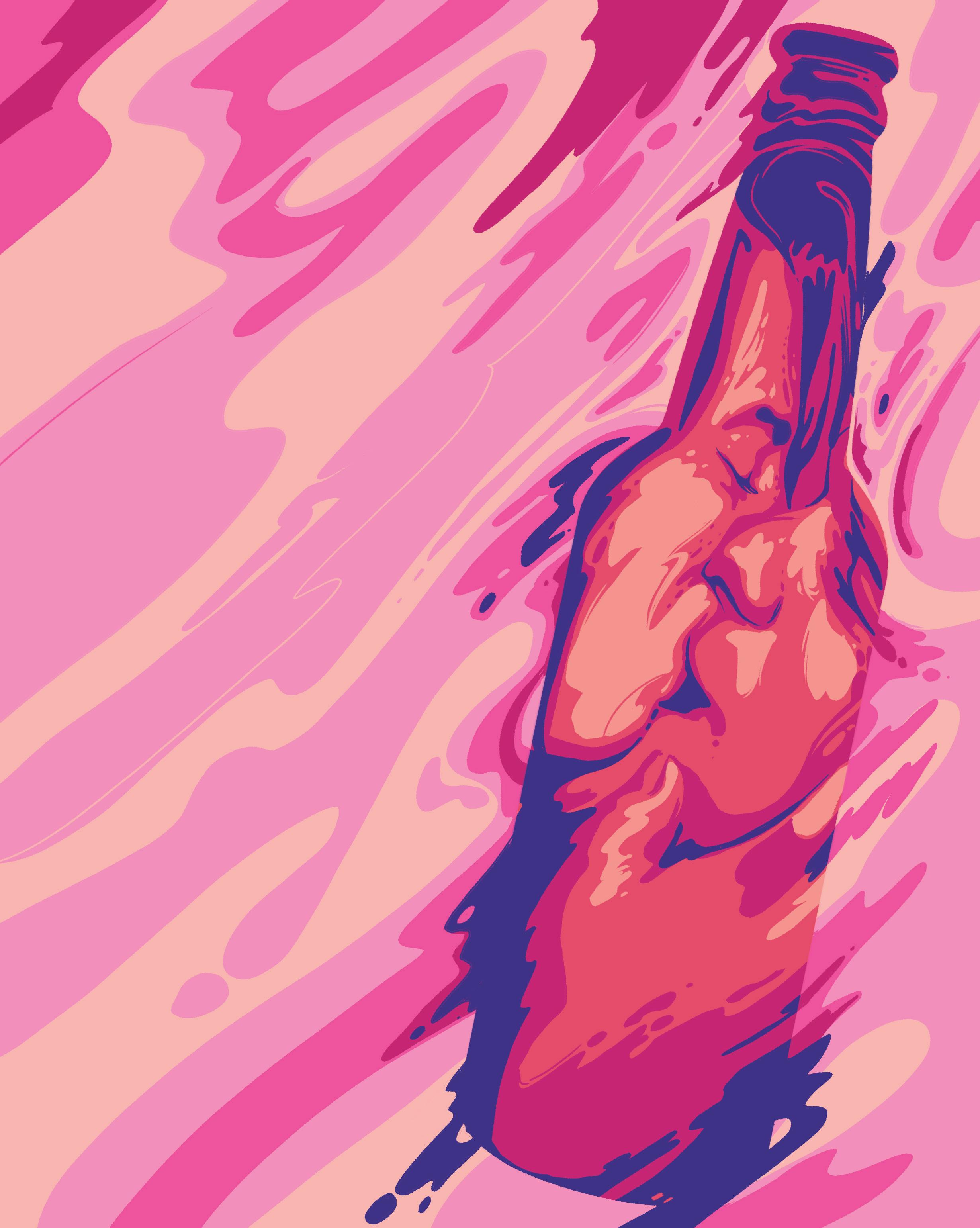
DAVID HALLOWES, SHAUN GINSBOURG AND ABBIE ROODENBURG
Last week, the Victorian Government introduced a Bill into Parliament that is designed to change sexual offence laws regarding consent. The rationale for this amendment is the promotion of the principle of “affirmative consent” as a requirement for all sexual activity. The Criminal Bar Association, a group representing barristers that both prosecute and defend sexual crimes in Victoria is concerned that the proposed wording of sections of the Bill will lead to unintended and unfair consequences.
The laws surrounding consent in the state of Victoria have undergone significant amendment in the past decade, particularly by reforms introduced in 2015 and 2017. These changes have recognised the many circumstances in which a person cannot consent, for example, if they are asleep or if they withdraw their agreement to a sexual act. Further, in order to prove an accused’s guilt, the prosecution need only prove that they did not “reasonably believe” that the complainant was consenting.
A genuine, if unreasonably held, belief in consent is not a defence. An accused who gave no thought to whether the other person was consenting has no defence.
This suite of reforms also limited the circumstances that can lead to a reasonable belief. An accused cannot rely on a complainant’s lack of protest or physical

resistance as a reasonable basis for believing the complainant was consenting. Similarly, intoxication or cultural and religious beliefs cannot be relied upon; and a complainant is taken to not be consenting if they are significantly intoxicated.
These changes to consent laws were complemented by amendments to the mandatory directions that are given to the jury by the presiding judge during a trial. In these statements, the presiding judge instructs the jury as to how they are to consider a defence of consent. Paramount in such cases is a direction that “people who do not consent to a sexual act may not protest or physically resist the act, for example, the person may freeze and not do or say anything”.
The Criminal Bar Association recognises that these past reforms have made sexual offence law more robust and that this reflects the changing social standards within our community. Indeed, these many changes reflect and promote the principles of affirmative consent. It is with that understanding that the new provisions need to be assessed.
The changes contained in last week’s Bill take these laws one step further, requiring people to take active steps to ascertain the consent of the other party (or parties) prior to engaging in sexual activity —exempting only those who can prove that a mental illness or cognitive impairment made this more difficult.
Sexual behaviour between teenagers and adults is, by its nature, nuanced. Romantic interactions might involve subtle movements and gestures and, to an extent, reading the actions of others. The proposed Bill attempts to make such interactions black and white.
Sexual behaviour between teenagers and adults is, by its nature, nuanced. Romantic interactions might involve subtle movements and gestures and, to an extent, reading the actions of others. The proposed Bill attempts to make such interactions black and white.
Perhaps think back through your own past romantic encounters and ask—When have you got it wrong? When did you not read the signs correctly? Should those actions be criminal?
Have you woken a partner from sleep with a kiss? Have you been drunk with another person at a party and engaged in a sexual encounter where neither of you recalls the exact details of the event the following day?
It is said that the proposed legislation does not seek to make the above acts criminal, and indeed, at the time, neither party to the act may regard them as such. But if the relationship breaks down and a complaint is subsequently made, how in those examples could an accused person mount a defence? Either no steps were taken to ensure consent in the example of a waking kiss, or the accused and/or complainant cannot recall the steps taken. Yet the proposed changes to the definition of consent seeks to make a blanket rule to cover all possible situations. This is particularly concerning where the law, and its interpretation, can turn on a single word in legislation. It should not be assumed that the potentially harsh operation of the new law would be avoided by compassion or common sense. Complainants will reasonably expect the law to be applied. Police and courts will be obliged to apply it.
The Criminal Bar Association is concerned that these amendments will disproportionately affect teenagers and young adults, as
they explore their sexuality and relationships and introduce alcohol into their lives. This is not to excuse sexual offending behaviour, but to question whether actions, in nuanced sexual encounters and relationships, ought be made criminal if prescribed steps are not taken by an accused.
In 2018, the maximum penalty of 25 years imprisonment for rape was supplemented by a “standard” (normal) sentence of 10 years. Once convicted, lifelong reporting can follow under the Sex Offenders Registration Act. For those that commit offences as young adults this can remove their ability to travel, coach their child’s soccer team later in life and requires annual reporting to police.
The Criminal Bar Association supports important social policy change. There is no doubt that greater education about consent is required for our community. However, given the serious consequences of a conviction for a sexual offence, the law in this area should not be used to drive improvement in sexual behaviour. It should instead reflect well-established and widely understood standards. Shelving the new law would not prevent education programs in schools and the community being used to raise those standards. Indeed, shelving the new law is not to shelve affirmative consent. Such principles are already enshrined in our legislation.
This article appeared in The Age on August 11, 2022.
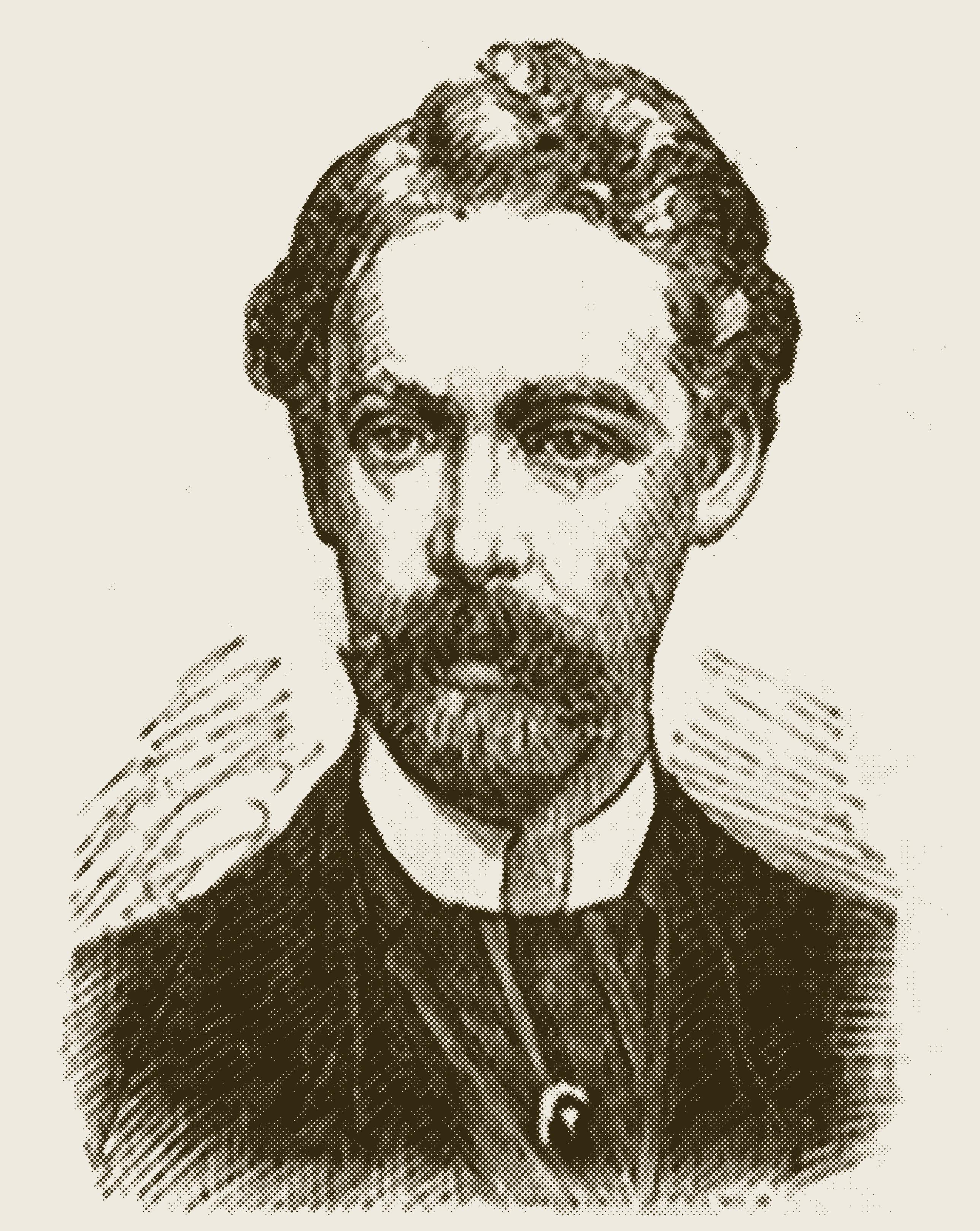
An Incident in Collins Street
IMATTHEW HARVEY
t is Friday morning, 12 October 1894. A medium sized man, wearing a suit and sporting a silk hat, is walking down Collins Street towards his chambers. Suddenly, a large man approaches. “Put up your hands, you ruffian,” he demands.
Unfazed by the challenge, the medium sized man responds: “Who are you speaking to?” Adopting the boxer’s stance, the two men shape up. The large man is Dr O’Hara, a highly regarded Melbourne surgeon. The medium sized man is James Liddell Purves QC, an eminent silk at the Victorian Bar.1
O’Hara delivers a ferocious right to Purves’s head. Undeterred, Purves delivers some heavy blows to O’Hara’s chest and shoulders. The story now becomes unclear, either O’Hara punches Purves on the nose and then delivers one to his jaw or Purves trips on the asphalt, but in either event Purves falls to the ground, his nose bleeding, he lies flat on his back in Collins Street. He is lifted from the kerb, taken into a nearby drapery store, cleaned up and brushed down. Despite this incident, within half an hour or so, Purves is appearing before the Supreme Court in a shipping matter.
Some years earlier, Dr O’Hara had given evidence in a proceeding that he had charged a fee of 500 guineas for surgery. Purves had asked him in
cross-examination whether the fee was excessive. Dr O’Hara answered that he had once been paid 1,000 guineas for an operation. In his address to the jury, Purves intimated that the 1,000 guineas were paid for an abortion—illegal at the time. This incurred the rebuke of the trial judge and the enmity of Dr O’Hara.
What does this incident say about James Liddell Purves? It is perhaps best answered by Purves’s words in an interview he gave later that afternoon: “… a public man never knows what is going to happen to him in this free country. A politician or a lawyer is always sure to offend someone, if he does his duty fearlessly and honestly …”.2 Without a doubt, Purves was a robust, energetic, and fearless advocate at the Victorian Bar and beyond. He was motivated by a sense of public duty, which was given full vent by his involvement in the Australian Natives’ Association.
On 23 August 1843, James Liddell Purves was born in Swanston Street, Melbourne. He was the eldest son of James and Caroline Purves. His father was an old colonist from Berwick-on-Tweed. Purves attended school in Melbourne. At the age of 12, he travelled with his parents to England. There he attended various schools and, eventually, Trinity College, Cambridge.3 He spent several years on the
Continent, becoming proficient in French and German and in losing his money gambling.4 In 1863, he was called to the Bar of England. In December 1866, having returned to Australia, he was admitted to the Victorian Bar.5
I would like to say that Purves was a studious lawyer. But he was not. Despite this, he developed a large and successful practice, taking silk in 1886. Alfred Deakin ascribed his success to his powers of crossexamination, his worldly wisdom, and his remarkable gifts as an advocate.6 Another contemporary described Purves as a man of pre-eminent forensic ability, saying:
What a splendid presence he had! And what personality! There was something magnetic about the great “J.L..” His rich, sonorous voice, so full of expression; his dare-devil manner; his insight into character; his keen and trenchant humour—all contributed to making him a popular and successful advocate.7
To appreciate Purves’s skill as a cross-examiner, one should look at his performance in a dispute over a will in 1891. Purves was briefed for John McMeckan who sought to upset the will of his uncle, who left an estate worth £120,000. One of the issues at stake was whether the uncle, in preparing his will, was under the undue influence of one of his nieces, Miss Grace Mackie. Miss Mackie gave evidence to disprove the allegation of undue influence. Purves’s cross-examination of her reads:
Purves: How old were you when you came to Victoria?
Mackie: About 20. (pause)
Purves: Is that a lady’s answer or a truthful answer?
Mackie: A lady’s answer (laughter).
Purves: Then you were more than 20?
Imagine that sonorous voice, imagine the cheering crowd. This was a man who could advocate a cause passionately and eloquently.
Mackie: Yes (laughter).
Purves: What was your age when you came to Victoria?
Mackie: 25 (laughter).
Purves: Why did you tell me a wanton falsehood and say you were 20?
Mackie: Because I was 20.
Purves: And the rest?
Mackie: Yes (laughter).
Purves: Why did you did tell me a falsehood?
Mackie: It just occurred to me.
Purves: What do you mean?
Mackie: It wasn’t particular.
Purves: Do you mean that it wasn’t relevant to the court case?
Mackie: Yes. Not of any consequence.
Purves: Do you say that you would imperil your soul for something of no consequence?
Mackie: No. I beg your pardon.
Purves: It isn’t my pardon. It is something far beyond me or anyone else in this court. Why did you tell me that lie?
Mackie: I cannot say.8
Purves seizes on this surprising first answer from Miss Mackie and by using humour ultimately has her admitting that she had lied to the court. His agility and guile as a cross-examiner are plain to see.
Purves was elected to the Victorian Parliament but never excelled as a parliamentarian. However, Deakin speaks glowingly of Purves as a promoter of the cause of federalism. This arose from his involvement in the Australian Natives’ Association.9 During the 1890s, Purves would make rousing speeches, advocating
an independent federation of Australian states.
On Friday, 7 March 1890, Purves delivered a speech at a branch meeting of the ANA at the Brunswick Town Hall. In that speech he said:
The pioneers of this continent were a brave and generous people, the descendants of a brave and generous race. But the descendants are equal to their forefathers and to their brothers across the seas. All I advocate for Australians is equality. The present ties that bind us to the old country are merely the silken ties of affection and blood … they might become as weak as thread, or as strong as iron chains. If we are equal as men with Britishers, we should have equal rights but no colonial born man, no matter what his position might be, can take his place amongst the statesmen of the Empire. That ought to be put an end to. That is intolerable, considering that we have a right to maintain perfect equality with those who rule over our destinies in England. The only way to ensure that equality—is that there should be federation—a united Australia.
Imagine that sonorous voice, imagine the cheering crowd. This was a man who could advocate a cause passionately and eloquently.

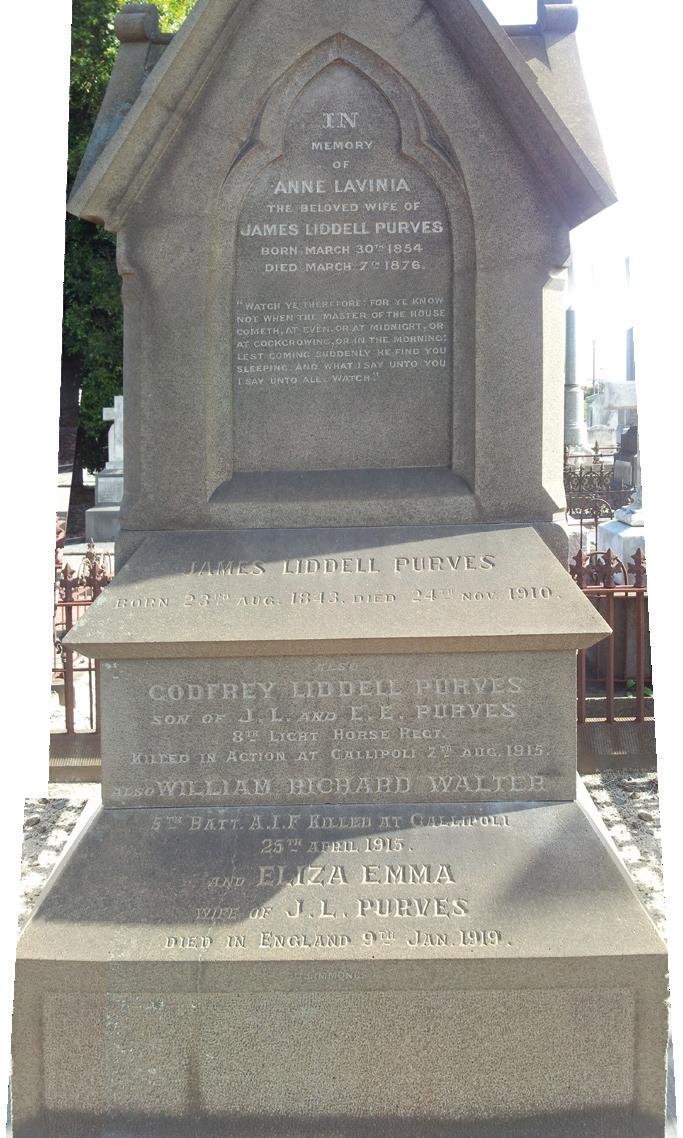
Victoria from 1890 to 1910. His success ended when he died suddenly on 24 November 1910.
The next morning, Sir John Madden, chief justice of Victoria, expressed the court’s regret at Purves’s passing and praised him for his extraordinary gifts in assisting the court. Sir Edward Mitchell KC expressed sincere appreciation of the chief justice’s speech.13
I do not want to end this article, dwelling on the death of this extraordinary man. Instead, I will finish with one more story. Purves was not a paragon of virtue. One day, he was involved in a case in which he called, as a witness, the keeper of a well-known brothel; Purves asked her for her name and address. The witness answered: “Oh, Mr Purves, you know my address.” Purves replied: “Yes, I know your address. But my learned friend would like to
1 A detailed description of the incident, including an interview with each pugilist, is in The Argus, 13 October 1894, pg 7.
2 The Argus, 13 October 1894, pg 7.
3 The Australian Dictionary of Biography, Vol 5, MUP, 1974 (ADB); The Argus, 25 November 1910, pg 6; and The Age, 25 November 1910, pg 7.
4 Alfred Deakin, The Federal Story, Robertson & Mullens, Melbourne, 1944, pg 5.
5 ADB; The Argus, 25 November 1910, page 6; and The Age, 25 November 1910, pg 7.
6 Deakin, op. cit., pg 6.
7 Philip Jacobs, Famous Australian Trials and Memories of the Law, Robertson & Mullens, Melbourne, 1942, pp 129-130.
8 Jacobs, op. cit., pp 83-84.
9 Deakin, op. cit., pg 6.
10 This is the author’s reconstruction of a speech reported in The Mount Alexander Mail, 10 March 1890, pg 2.
11 ADB; and The Age, 25 November 1910, pg 7.
12 Deakin, op. cit., pg 6; A Dean, A Multitude of Counsellors, F.W. Cheshire, Melbourne, 1968, pg 14 6.
13 The Argus, 26 November 1910, pg 18.
14 Dean, op. cit., pp 148-149.

ANDREW KIRKHAM
This poem, as most common lawyers would recognise, concerns a personal injuries claim by Ms McLeod against Mr Lind and apparently Mr Locke as the third defendant. There appears to have been a second defendant not named. The first person mentioned is Mr Lander, known as ‘Chick’ Lander, (hence “to keep Chick on his toes”), a prominent solicitor frequently involved in defending personal injury claims. He appears to have briefed Barry Dove to act for the first defendant. Barry went on to become a County Court judge. The next person mentioned is Peter O’Callaghan after whom the Portrait Gallery is named. He appears to have been briefed for the second defendant. The third barrister mentioned is Frank Dyett who had a practice in liquor licensing but practised in personal injuries as well. He appears to have been briefed for the third defendant Lock. He too went on to become a County Court judge. Counsel for the plaintiff and, I suspect, the author of the poem, was Cairns Villeneuve Smith. After being involved in the sensational murder trial of Aboriginal man Max Stewart in South Australia he came to the Victorian Bar and was in due course also appointed to the County Court. The judge referred to is “Justice ‘Frosty Frank’ Nelson” who commenced as a judge in the County Court and was elevated to the Supreme Court. Given the poem’s use of “Mr Justice” in reference to him, I would assume this case was conducted in the Supreme Court. On the other hand, it may simply be that the line scans better than it would with the word “judge” preceding “Nelson”. Both Jack Mornane and Victor Belsen were prominent and able personal injuries counsel and went on to be County Court judges. Neil McPhee was one of the most able lawyers the Victorian Bar has seen and the Neil McPhee Room is named after him. I believe all counsel mentioned were, or became, silk. The poem appears to indicate that no offers of compromise were made by the defence to the offer to settle for $40,000. The plaintiff is triumphant that the jury returned a verdict of $50,000—high, but not too high that it could not be held on appeal.
It was bruited on the wind that McLeod versus Lind Was altogether an extraordinary affair;
Of the three defendants named, one was quite erroneously blamed,
And in point of fact was never even there.
Said Mr. H.G.Lander: “It is libel, if not slander, To impute unto my client any fault;
My perusal of the pleadings in these scandalous proceedings Reveals the Plaintiff either knave or dolt.
That you may understand it better, I have set it out by letter, And explained the whys and wherefores of the case; From heroics I abstain, but it is abundant plain, That my insured was never near the place.
So no monies I’ll distribute, to no compromise contribute, The Plaintiff’s pride rides here before her fall, And thus, in accents gruff, I call your collective bluff, On Liability, the best of luck to all!
Now if I your ranks affront, and you brand this as a stunt, And execrate my name with jeers and groans, Pray, please terminate your tricks, it’s only stones and sticks, Not words, that hurt these aching, ageing bones.
I have instructed B.R.Dove to eschew the velvet glove, And watch unmoved the bitter tear-drops fall, This whole alleged collision excites my sharp derision On liability, the best of luck to all!”
Then assembled from afar a most distinguished Bar, To try the case McLeod v Lind and others.
Of Counsel there were four, deemed learned in the law, A happy band of fratrididal brothers.
There was Barry Robert Dove (whom his wife and children love)
Of dignified and sacerdotal bearing,
Next, that famous steak and claret man, Peter J. O’Callaghan, Upon his pumpkin head a shamrock wearing.
To withstand the battle’s shock for the third defendant Lock Appeared a most engaging circuiteer,
Frank Dyett was his name, moderate drinking was his game, Beloved by Licensed Victuallers far and near.
Versed in contract and in tort, he strove mightily in Court,


The day’s work done, his full cup runneth over, From Bordertown to Sale he had quaffed the amber ale, As light relief from detinue and trover.
In this tangled legal wood the hapless Plaintiff stood, Oppress’d by apprehension and concern, “Must I tread this fearsome journey, without mouthpiece or attorney, Will no one’s heart, for me, to pity turn?”
Then spoke a figure spare, with a quiet ascetic air, “I prithee, Madam, set your cares at nought, With earnestness and pith, I Cairns William Villeneuve-Smith
Will urge your cause unto the waiting Court.”
“Fear not your dread foes’ fury, we have a judge and jury, And seven noble hearts, will beat as one, We shall not fail or falter, nor our objective alter, Till we emerge from darkness to the sun.”
Said the pensive lady “Sir, it were churlish to demur, My piteous pleas from trembling lips must fall. But I do not fancy you can long survive this murderous crew, So, on every issue, God have mercy on us all!”
Bawled O’Callaghan the Celt “Into action let us belt, My shillelagh is poised ready for the fray, If this cause grows sometime dull, I’ll slip out and smash an English skull,
As befits a corps commander of the I.R.A.
My temper does not mix with pommie legal tricks, Now hearken to old Erin’s battle call. One cannot be serene, when a waarin’ o’ the Green So, on liability, the curse o’ Cromwell on ye all!”
Said amiable Frank Dyett: “This case will be a riot, From curial inculpation I am free. With no forensic pressures, I’ll just chalk up the refreshers, and, to keep Chick on his toes, a circuit fee.
At this caper I’m no fool, I proved at Warrnambool, When I overcame the ravenous Neil McPhee, (He’s gone respectable with silk, with others of his ilk, And struts around in dull sobriety).
Our appetites are hearty and the scale is party party, For beer and briefs our prospects never pall. Let insurers court disaster from the genial taxing master, With refreshers and refreshments ‘Good Luck All’!”
Said Mr. Justice Nelson: “You’re worse than Jack Mornane or Belson,
Seldom have I had to listen to such crap. All the merits here lie with the Plaintiff’s counsel, Villeneuve-Smith Whom I hold to be a very decent chap.
He’s not difficult to please, seeks but a modest 40 Gs,
As some solace for this badly injured dame, Yet for her legal quittance, you proffer but a pittance, Why don’t you clowns pay up and play the game?”
Then spake egregious Dove, eyes lifted piously above:
“In this regard, I cannot help at all.
I can make no proper offers from Lander’s pregnant coffers, But I can say this—’The best of luck to all’!
But if litigations shift and fluxions call for some fresh instruction
And it appear our dubious cause is lost, Safe in my encircling arm, she need fear not hurt nor harm, If she decently withdraws, and pays our costs.
But I’ll not chaffer with these codgers, I have spoke with Lander (and with Rogers)
My instructions they are brief and pristine clear —
Unless the plaintiff do rescind, qua my guiltless client Lind, Her fate will be draconic and severe.”
Then were summoned the stout jury, and they list with mounting fury,
To the recapitulation of her plight,
And their tears commingled with the broken hearted Villeneuve-Smith,
And their looks the first Defendant did indict.
It was relayed by phone to the non-combatant one, That disaster’s tide was running strong and swift. But the voice replied serene, with not a hint of spleen, “Among defendants, I trust, there is no rift?
If we unite and fight, we’ll put this harridan to flight, And make her taste the wormwood and the gall. ‘Twill be exceeding droll, if we knock off this old doll, so, on liability, ‘the best of luck to all’!”.
You could pierce the silence with pin, as the jury filed back in, Their righteous anger awesome to behold,
Said the foreman: “If you please, we have fixed on 50 Gs. It’s nice and high. But not too high to hold!
I think we’ve nicely pinned the first defendant Lind, His guilt was clear, as in a crystal ball.
To our sense of fun we pander, what’s sauce for Lind is sauce for Lander, So liability’s the biggest joke of all.”


In this Back of the lift section of the Victorian Bar News, the Bar acknowledges the appointments, retirements, deaths and other honours of past and present members of our Bar
Supreme Court
The Hon Associate Justice
Matthew Barrett 60 County Court
Her Honour Judge Barbara Myers 61 Magistrates’ Court
Her Honour Magistrate Lucia (Lucy) Raponi 61
His Honour Magistrate Brett Sonnet 62 Coroners Court
His Honour Coroner Paul Lawrie 62
63
63
Giuseppe John Sala 63
Angela Cranenburgh 63
The Hon Sir (Francis) Gerard Brennan
AC KBE QC 64
Nicholas Hanos 64
Douglas Raymond Meagher QC 65
The Hon Paul Richard Mullaly QC 65
His Honour Joseph Gullaci
The Hon Robert Clive Tadgell AO QC
John Kelly Arthur
The Hon Robert Brooking AO KC
The Hon Michael R B Watt KC
Richard M Read
John Bailey
Bar Roll No 2970
Matthew Barrett commenced pupillage with me in 1995 after having completed an Associateship with the Honorable Justice Sweeney of the Federal Court of Australia. He joined an illustrious set of counsel on Level 17 West: Chernov QC, FX Costigan QC, Weinberg QC, the Crennans x 2, Hansen QC, Hedigan QC, Jolson QC, Jack Barnard QC, Phil Kennon QC, as well as Santamaria the Elder but None the Wiser.
Within only a day or two, it became apparent to me that the young Barrett was whip smart. Moreover, his social skills were the envy of his contemporaries and made no small impression on his erstwhile senior colleagues on the floor. Whereas their playgrounds tended to be the Australia Club or the Savage Club, Barrett was more egalitarian: he frequented his surf life-saving club on the Peninsula or his frisbee club at Albert Park. Indeed, his range of pastimes was remarkable: hang gliding, roller blading and the less hazardous oil painting. I recall one afternoon he captivated Barnard and Costigan with his “hold my breath under water” party trick. Barrett had won a competition in what is called “free diving.” Competitors would hold their breath, surfacing only when their bodies were about to explode. Barrett held his breath for close to three minutes. Not bad.
It goes without saying that most of these extra-curricular activities involve a heightened risk to life and limb for us mere mortals. For Barrett, however, there was no adrenalin rush, just an icy calm and deliberate purpose. Excellent attributes for a successful advocate.
Matthew soon developed a busy and broad practice at the Bar, ranging from commercial law to common law, construction law, equity, and trusts, wills, and succession. His calmness in and outside the court was his hallmark. So too was his clarity of thought and expression, courtesy, dignity and respect for the courts and other practitioners. Having developed a substantial practice, and having chased one frisbee too many, Barrett decided to embark on a lazy Doctor of Laws at Monash University on the doctrine of unclean hands. He successfully completed the doctorate and has never, since then, had trouble booking a table at a restaurant.
Barrett was an extremely popular addition to chambers both in ODC West and where he was ultimately to settle in the Far East of 200 Queen Street, with Ian Hardingham QC, David Collins QC, Kevin Lyons QC, and other close friends of his. His kindness, generosity, good humour, and empathy made him a welcome member of chambers and a loyal friend. Matthew has been a wonderful father to his treasured girls, Cleo and Teddy and a devoted partner to Trudi, an emergency physician, an appropriate choice of partner for someone with Matt’s propensities. He has always been immensely proud of the achievements of his parents (his late father, Michael, was a solicitor) and of his siblings Simon, Kate, and Nick. When Kate was selected to be an Associate to the late Sir Gerard Brennan on the High Court, Matthew’s pride in her was palpable.
With his depth of understanding and experience of the law and the personal qualities which he has in spades, Matt is well-qualified to make a fine associate justice of the court. From the perspective of the advocate, he will become known as a delightful person to appear before. May his time on the Bench be as stimulating and satisfying for Matt as his appointment will be for the enduring benefit of the legal profession of Victoria.
PAUL SANTAMARIA KC
Bar Roll No 4474
Judge Barbara Myers was appointed a judge of the County Court on 25 October 2022.
Judge Myers was born in the United Kingdom and grew up in London. The middle of three daughters, her Honour is the first of her family to practise law. Her career success both in the United Kingdom and in Australia is a matter of great pride to her family.
Her Honour undertook her studies at the University of Southampton, where she obtained a Bachelor of Laws with honours.
Judge Myers was called to the independent Bar of England and Wales in 1988, as a member of the Inner Temple. She completed her first six pupillage in a set of admiralty/ commercial chambers in Essex Court, then her second six with Ernst Horridge in a common law chambers in Queen Elizabeth Building. At the end of her second six she was taken on as a member of QEB and remained there until she migrated to Australia in 1998.
Judge Myers enjoyed practice in a wide range of common law, criminal law and family law cases at the English Bar for 10 years. She regularly appeared in courts
in London, as well as appearing in courts in the south east of England, predominantly Southend and Canterbury.
In 1998 Judge Myers took a two-year sabbatical, so that her husband Jonathan could take up an exciting job opportunity in Australia. Her plans to return to England were thwarted when she fell in love with Australia and when she and Jonathan started a family here. Judge Myers is the mother of three beautiful daughters. At that early stage of their childhood, her Honour decided to enjoy a break from the law.
Encouraged by friends to return to the law, Judge Myers needed to undertake some further studies in order to obtain her Australian qualifications. In order to familiarise herself with the local laws and customs, her Honour undertook paralegal work with Wisewould Mahony, followed by work at the Department of Treasury and Finance, as part of the Longford Litigation Team, before undertaking two years as a paralegal at Slater and Gordon.
Upon completing her qualifications to practise in Victoria, Judge Myers was called to the Victorian Bar in 2012. She was the first reader of Penny Neskovcin. Her Honour took silk in November 2021.
At the Victorian Bar, Judge Myers practised widely in common law with a strong practice in personal injury, professional negligence, general insurance and coronial inquests. Her Honour regularly appeared in the Supreme and County Courts, often in trials heard by a judge and a jury of six. She was highly sought-after junior and then senior counsel, continually briefed by TAC, Workcover and private insurers on behalf of defendants.
Judge Myers was a regular on the Bendigo, Warrnambool and Mildura Common Law circuits, initially as a junior and then leading counsel, even prior to taking silk.
Judge Myers was regarded as extremely hardworking, sensible,
straight forward and good fun Her abilities as an effective advocate, strategist and adviser were in high demand. Always polite, Judge Myers was fearless as an advocate: opponents and witnesses underestimated her at their peril. Judge Myers has an excellent knowledge of the law and was always on top of the latest cases. Her written submissions were comprehensive and well received by the Bench.
Judge Myers was a popular member of the Common Law Bar Association, Lennon’s List and the 13th floor of ODCW. No matter how difficult the case, the Bench, the client or the instructor, nor how heavy the workload, Judge Myers was always able to find the fun. It is a quality that I am sure she will bring to the Bench.
Outside the law, Judge Myers is devoted to her family and friends. She enjoys adventurous travel, sometimes in luxurious comfort, sometimes in less salubrious conditions. She is a keen gardener. Judge Myers will be much missed at the Bar but her appointment to the Bench is very welcomed by the Bar. She will make an outstanding contribution to the administration of justice in this State.
RÓISÍN ANNESLEY KC
Bar Roll No 2930
Her Honour studied at the University of Melbourne where she obtained a Bachelor of Arts majoring in French and Italian and a Bachelor of Laws. She then worked as a legal officer at the Victorian Government Solicitor’s Office from 1989 to 1994. She read with the late Ross Ray QC, coming to the Bar in 1994. In her early days at the Bar, her Honour had a broad practice appearing in summary crime matters, intervention order
applications, criminal appeals and family law matters. She later practised mainly in the Family Division of the Children’s Court, to which she has now been appointed a magistrate.
In her long career at the Bar, her Honour appeared for parents, children, other family members and to prosecute for the Department of Families Fairness and Housing (previously DHHS and DHS). Her Honour held the position of inhouse counsel for the Department from 2002–2006 in the newly formed Court Advocacy Unit (now Child Protection Litigation Office) and appeared in the long running Children of God case over a period of two years. Her Honour was a good example of the cab rank principle at work and accepted briefs to defend and prosecute as required.
Her Honour was widely respected by all she came into contact with during her years at the Bar. Her reputation was to be well-prepared, focussed, intelligent and a brilliant cross-examiner! Her colleagues were always pleased to be seated at the Bar table with her. Her Honour also provided unofficial mentoring, wisdom and support to her junior colleagues and peers, which was gratefully received in what is widely regarded as a “robust” jurisdiction. Her Honour always provided good company and was known for her quirky sense of humour and unerring sense of style.
Although we miss the day-to-day camaraderie, her Honour’s appointment to the Bench has been universally welcomed and we all now enjoy appearing before her and know that she brings to her new role all of the qualities necessary for a good decision maker in an important but often overlooked and misunderstood area of Law.
On a personal note, her Honour is supported in taking on her new, demanding role by her husband and three daughters.
CHRISTINE POLLARD
Bar Roll No 4603
Brett Sonnet is surely the most credentialled black letter lawyer ever appointed to the Magistrates’ Court of Victoria. As a barrister he appeared in over five hundred cases before the Court of Appeal and some 50 cases before the High Court of Australia.
His Honour graduated from Monash University with honours degrees in Law and Jurisprudence in 1989. Following his admission to practice in 1991 he worked in private practice doing criminal defence work and volunteering at the St Kilda Crisis Centre and as a part time duty lawyer at the Heidelberg Magistrates’ Court before working for Victoria Legal Aid. From 1998 until 2010 he worked for the Office of Public Prosecutions. So outstanding was his work in that capacity that in 2010 he became the first and only solicitor appointed as a Crown prosecutor in Victoria, moving from the solicitor’s branch of the profession to the Bar Roll.
It was as a Crown prosecutor that his Honour excelled. He appeared before the High Court of Australia in some of the most significant criminal cases in the past 15 years including Momcilivic v The Queen (2011) 245 CLR 1 and Likiardopoulos v The Queen (2012) 247 CLR 265. His written submissions were highly valued by the High Court; in a social setting members of that court questioned why he had not applied for silk.
His Honour’s most important case was one in which no judgement was ever delivered. Farah Jamah was a tall Somali teenager convicted of raping a white female in a Doncaster nightclub. Closed circuit television showed no non-white patrons at the critical time. Jamah was convicted by a jury after a five-day trial. He had alibi evidence and the prosecution
case rested solely on DNA evidence. Jamah appealed his conviction, and his Honour was sufficiently disturbed to direct another DNA analysis which revealed that the DNA sample responsible for the conviction was contaminated. Not only was Jamah not guilty but he was an innocent man. The Crown conceded the appeal. The whole sorry saga was told in The Tainted Trial of Farah Jamah by Julie Szego.
As a prosecutor his Honour was readily recognised by the Court of Appeal for his fairness. His Honour has always exhibited an empathy for the underdog and will be a sympathetic ear for those appearing before him.
GAVIN SILBERT KC
Bar Roll No 3295
Coroner Paul Lawrie was appointed on 23 August 2022. Prior to appointment his Honour practised as a member of counsel for over two decades, signing the Bar Roll in March 1999. His practice was busy and diverse, encompassing criminal defence, inquests, prosecutions, personal injuries, disciplinary proceedings, and appearances as counsel assisting in the Coroners Court and before IBAC.
His Honour’s approach to practice was characterised by skill, hard work, organisation and extraordinary levels of service to his instructors which was tempered and enhanced by his natural empathy and compassion.
In his early years, his Honour gave his time generously to the activities of the readers’ course. More latterly he continued his service to the Bar as a member of the ethics committee.
Despite his busyness his Honour found time and enthusiasm to be an effective mentor to six readers: Grant Reynolds; Kyle McDonald, Frank
Scully, Viola Katotas, Ekbol Taghdir and Timothy Glass.
His Honour’s working life in advocacy commenced well before his call to the Bar. In 1990 he joined the prosecutions division of Victoria Police, where he served as a police prosecutor and instructor to prosecutors. Before that, his Honour had served as a constable and senior constable at stations including Collingwood, Essendon and Heidelberg.
Demonstrating his capacity for hard work and organisation, his Honour completed a Bachelor of Laws in parallel with his full-time work as a prosecutor and instructor.
Having obtained his degree his Honour served articles with Clayton Utz, where he continued to practise as a solicitor until commencing the readers’ course in early 1999.
Despite the demands of the law his Honour has from his schooldays maintained a keen interest in science. Subject to a particular passion for astronomy, these scientific interests remain lively and broad ranging. It is recommended that his Honour not be questioned about this unless the interlocutor has time on their hands.
The scientific hallmarks of enquiry and rigour of thought, and his empathy and compassion ensure his Honour will be an exemplary appointment to the Coroners Court.
CHRIS HANSON
The Hon Justice Lesley Taylor appointed to the Court of Appeal
The Hon Justice Karin Emerton appointed President Court of Appeal
The Hon Tim Bourke appointed Deputy Chief Magistrate
Bar Roll No 1967
t is with deep regret that members are advised of the death of Giuseppe John Sala, or Joe as he was known to most, on 20 April 2022. Joe was born on 17 August 1948 on the Southeast Coast of Sicily in a small town named Floridia. He emigrated to Australia with his parents, initially settling, like so many other Italians, in North Melbourne.
Joe attended Assumption College in Kilmore where, in his last year, he earned a scholarship based upon his sporting prowess. He was a keen footballer and demonstrated significant skill as a full forward combining natural talent with his own style of continental flare (the rare practice of attempting to ‘draw a foul’ in the goal square sadly passing away with him).
After matriculating from Assumption College Joe studied arts with a diploma of education at Monash University. He worked as a teacher for a number of years before returning to Monash University to study Law. After completing his law degree he worked at Galbally & O’Bryan, where he was articled to Peter O’Bryan.
Joe signed the Bar role in June 1985 and commenced reading with Peter John Galbally Q.C. He practiced in the common law jurisdiction principally acting for plaintiffs from migrant backgrounds. He augmented this part of his practice volunteering for the Italian Assistance Association— CO.AS.IT—an organisation he was most passionate about. Joe was a much loved member of the Fourth Floor, Owen Dixon Chambers West, for many years until his retirement in 2017.
Joe was known for always being in possession of a smile and
friendly embrace, quick to throw his hand up high and holler a “hello” across William Street. Our deepest sympathies are extended to his wife Margaret, his three children and four grandchildren.
Bar Roll No 3576
Angela was born on 17 September 1946 in Palestine. Shortly after her birth, her family migrated to Southern Rhodesia. In 1961 she moved to Australia.
Prior to being called to the Bar, Angela had a long and successful career in education. She was a high school English teacher for 27 years. She developed a fascination for the law and decided to have a career change. She became a part-time mature-aged law student at university and graduated in law in 1999.
She commenced her legal career as a solicitor running her own practice from 1999 until 2002. Angela signed the Victorian Bar Roll in November 2002. She read with Bruce Walmsley.
At the Bar, Angela practised predominantly in family law and its related areas of domestic partners (de facto property), crimes family violence and Children’s Court and in commercial and property matters. Angela was an accredited mediator. Angela was a member of the Family Law, Children’s Court, Criminal Law sections of the Victorian Bar; the Women Barristers’ Association and the Family Law Section of the Law Council of Australia. Angela was associated with community legal groups and she was actively involved
in the Victorian Bar pro bono legal assistance scheme. She frequently provided pro bono advice and representation to those who could not afford legal representation.
As a barrister, Angela was hard working, thorough and tenacious. She was always friendly and happy to sit down and offer advice or have a chat.
Angela was proud of her Jewish culture, heritage and faith. She was an active member of the women’s chapter of B’nai Brith and regular attendee of the Frankston Synagogue.
Angela passed away suddenly on 10 May 2022. Her funeral took place on 11 May 2022 at the Chevra Kadisha Cemetery in Lyndhurst. She is survived by her four children, Nadine, Melissa, Andrea, Aron and four grandchildren and two step grandchildren. She will be sadly missed.
VBN
The late Sir Gerard Brennan’s litany of achievements is well-documented.1 In paying tribute to his outstanding life and career, we take this opportunity to give an insight into some of the traits of the person who gave so much to his family, his colleagues, his community, the law and this country. When appointed in 1995 as the tenth chief justice of the High Court, Sir Gerard was nearly 67 years old.2 Some observed that because his tenure would be short, a chance had been wasted. More recently,3 Paul Keating explained:
1 See the obituary published by the Victorian Bar on 7 June 2022. See also http:// www.austlii.edu.au/cgi-bin/viewdoc/au/ cases/cth/HCATrans/2022/135.html.
2 He was a member of the High Court of Australia from 1981 to 1998.
3 On 18 August 2022, a commemorative sitting of the High Court was held in memory of Sir Gerard, which was attended by many, including the Hon Paul Keating, Prime Minister of Australia from 1991 to 1996. Mr Keating has authorised the inclusion of this account in this publication.
“Some asked me at the time, ‘Why appoint Gerry as chief justice when he would have only a little over three years to run?’ The answer was clear. Moral clarity and incisiveness. If you appoint someone to the top job, even for a short time, with moral clarity and incisiveness, they can help shape the country for the better.”
Mr Keating added:
“In public life, there is a confusion between insight and progress with the idea that it is time in the job that matters. The creative spark is the source of all progress and sparks do not linger. Gerry possessed a vast panoply of legal understandings and experience—and from that cumulus he could manage the odd lightning strike.”
His contribution to the jurisprudence of the common law speaks for itself. However, he also made an invaluable contribution to the collegiality and inclusiveness of the High Court. On the first Tuesday evening of every month, he invited his colleagues for drinks in his chambers. Further, when moving through the corridors of the court, he would always give a warm greeting to passers-by. And on the last sitting day before Christmas every year, he would ensure that he caught up individually with every staff member throughout the entire court to offer them the season’s greetings. After his retirement, he invited his associates to an annual lunch that he continued to host for 21 successive years up until December 2019.4
He loved his time as a barrister, especially as senior counsel. He considered the significance of the independent bars throughout Australia could not be overstated. In his view, they are integral to the independence of the legal profession and to the democratic society we all enjoy. He had particular affection for the Victorian Bar, and considered the way it managed itself, the conduct of its barristers generally and the
4 COVID-19 restrictions meant subsequent lunches were not feasible.
absence of material barriers to entry to be some of its exemplary features. As a mark of his respect for the Victorian Bar, he attended the bar dinner annually while a judge of the High Court.
When it came to charity, his motto was “think globally and act locally”. He was always conscious of contributing to those around him who were less fortunate. His generosity was remarkable given all his other endeavours.
Our judge enriched the lives of all those who were fortunate enough to know him. He will forever be in our hearts.
JAMES ELLIOTT, ENDORSED BY HIS COLLEAGUE TONY CAVANOUGH (FORMER ASSOCIATES OF SIR GERARD BRENNAN)
Bar Roll No 2291
Nick Hanos was born on 5 May 1950 at Kavala, a seaport in northern Greece.
His father Athanasius, a journalist, was sent to cover the 1956 Olympic Games in Melbourne. He fell in love with the city, stayed on, and his wife and young family soon followed.
Nick’s secondary education was at Waverley High School where he excelled academically and in athletics. Thereafter he studied law at Monash University. His articles were done at Messrs Stewart & Sons in Echuca. Nick was admitted to practice on 2 May 1977.
Nick practised as a solicitor on a broad range of matters before signing the Bar Roll on 24 November 1988. He read with Damian M Austin. Armed with patience, self-belief and a supportive wife in Jan, Nick trekked his journey as counsel. As the years unfolded, he successfully conducted a broad practice in the Magistrates’ Court and the County Court.
While some counsel clamour to be heard, Nick chose to observe, listen and then if appropriate, comment accordingly. It served him well professionally and in life generally.
Meticulous in his case preparation, Nick’s firm but respectful advocacy proved that courage and courtesy remain pivotal to good advocacy. Nick’s practical skills particularly with machinery generally, fashioned a mindset which was conducive to resolving disputes in a practical way.
Away from the law, Nick loved the outdoors, including riding around his property with his trusted dogs, planting trees or simply building something.
His general demeanour revealed a man remarkably at ease with himself, buoyed by inner confidence.
Jan and the children Laura, Paul and Amelia were his rock, his central focus.
A man for all seasons. So sadly missed.
DAMIAN AUSTIN
Bar Roll No 725
Born in 1941, living in Pascoe Vale and then Mentone as a child, Doug was the son of Winifred and Ray Meagher, a decorated World War II officer, successful businessman and senior cabinet minister in the Bolte and Hamer governments. Doug attended various schools including Mentone Grammar, Chelsea Mordialloc High, and Wesley College from which he graduated in 1958.
He studied law at Melbourne University as a member of Trinity College. In addition to the law, he developed keen interests in philosophy, history, art history and the humanities more broadly. He was the secretary of the Melbourne University Liberal Club, writing its constitution, and he ran with the university athletics club. He was invited and trained with then current mile world record holder and Olympic champion, Herb Elliot, under the famous coach Percy Cerruty. Upon graduation, Doug challenged the law school to run the 80 miles from the Old Quad to the
Portsea Pub, which he proceeded to do and ordered himself a beer upon arriving, later explaining that the establishment had a terrible wine list in those days! He was a keen squash and tennis player, playing first grade pennant tennis for many years at Beaumaris. Later in life he enjoyed playing bowls.
Doug joined Melbourne University Regiment at the age of 17 in 1958. He was commissioned as an infantry officer in the CMF, and held various commands and postings. At the age of 31, then a Major posted as the training officer at 1 RVR, due to his frank critiques of the shortfalls of training conducted by officers senior to him and their resultant unhappiness, he was ordered to conduct an exercise of the standard he required of others. Doug proceeded to plan and conduct a substantial exercise in which he commanded several thousand army, naval and air force servicemen and assets. His several thousand pages of orders and plans, written on a typewriter without a staff to assist him, were used for many years afterwards as an example of how to run large combined arms exercises. Doug subsequently volunteered to deploy to Vietnam as a Major, regarding it as his duty to do so, but he was nonetheless grateful when shortly prior to his departure all future deployments were cancelled by the Whitlam Government. Having held postings as the Brigade Major of 4 Task Force and 2IC of 6RVR, he retired from the CMF in 1976.
Doug had graduated with First Class Honours in April 1963, having been invited to sit the Honours exams over the summer holidays at the conclusion of his undergraduate degree as was the custom then. He signed the Bar Roll on 28 May 1964 at the age of 23, reading with Sir Edward Woodward QC. During his early years at the Bar Doug lectured and tutored in, variously, commercial law, advanced contracts and torts at Melbourne University and Monash University, and in commercial
contracts in the articled clerks’ course at RMIT.
Much of Doug’s junior practice concerned commercial, corporate and equitable proceedings and regulatory prosecutions. Some examples include Doug being frequently briefed by the Commissioner of Corporate Affairs, and being retained by both Murdoch and Hancock in commercial matters. However, by the age of 32, he had also acted in several criminal proceedings, including prosecuting a murder alone and unled in which he obtained a conviction and a sentence for hanging, later reprieved. By his mid 30s, Doug had also obtained what was at that time the highest award in a personal injury case, again unled, and which he later said resulted in his never being briefed in the area again!
At the age of 38, Doug was briefed by a water authority in the State Rivers case. It concerned the liability of water authorities for flooding. For several decades, the water authorities had the burden of proof obliging them to disprove negligence, meaning they nearly always paid to settle any claim for damage suffered from flooding in their geographic area. Doug advised that the burden could be shifted by challenging causation, so that the starting position would be that the water authorities were not liable. He advised he would need to lose the case at first instance and win on appeal to change the law, and that he would need to disclose those instructions to the court. Doug proceeded to do just that, appearing alone at first instance and on appeal. The appeal ran for six weeks before a full court of five judges. Doug succeeded, changing the relevant law of causation, and saving water authorities countless sums thereafter.
In 1980 at the age of 39, while still a junior Doug was briefed as lead counsel assisting the Joint Commonwealth / State Royal Commission into the Federated Ships Painters and Dockers Union, known as the Costigan Commission. For many years prior, Doug had
an interest in computers and, amongst other things, their use for intelligence gathering and analysis. Doug convinced Costigan, and subsequently the state and federal governments, to build a computer occupying an entire floor of 200 Queen Street, which was used to analyse data pursuant to his requirements. Employing Doug’s methods, what commenced as a commission into tax schemes developed into one that also concerned serious organised crime of all varieties including theft on a grand scale, the handling of massive importations of drugs, the shipments of armaments, all manner of violence and murder including contract killings, extortion, money laundering on an industrial scale, extensive fraud on social security and pension systems, compensation fraud and the widespread use of asset stripping to avoid tax liabilities, which became known colloquially as bottom of the harbour schemes.
Doug was firmly of the view that the power of commissions should not subvert the right to a fair trial. With some exceptions on public interest grounds, he considered public hearings by commissions to be a misuse of the state’s power that may result in people suffering the consequences of adverse allegations without any offence being proved against them, without any avenue of redress, and as prejudicial and contrary to the proper administration of justice. Persuading Costigan of those views, the vast majority of the Commission’s hearings were held in camera and referrals for prosecution were not publicly disclosed.
That left the Commission open to attacks, which it received in many forms, often from wealthy people, who had been the subject of its investigations. Some attacks focused on the lack of public hearings and suggested the Commission was not achieving anything; some attacked the use of the computer as unsafe; at least one fellow practitioner publicly suggested the idea there was serious
organised crime in Australia was fanciful. Others slandered Doug in the press. Some tried to stop him in the courts: he was famously sued by Malcom Turnbull on behalf of Kerry Packer, a hopeless suit dismissed as an abuse of process. Evidence emerged of a contract killer hired to assassinate Doug resulting in police protection for him and his family for several years. Doug regarded all of these as good indications the Commission was making progress.
The Commission ran for four years. It resulted in more than 2000 successful prosecutions, a benchmark unsurpassed by any other royal commission. The National Crime Authority, now the Australian Criminal Intelligence Commission, was established on its recommendation.
Doug’s methods were subsequently studied and adopted in North America, Europe, the United Kingdom and Hong Kong. His methods led to significant advances in detecting and prosecuting serious, industrial levels of organised crime, tax evasion and fraud in Australia and overseas. He was offered substantial sums to pursue that work in at least one of those jurisdictions, but preferred to remain in practice at the Bar.
Doug took silk in 1981 at the age of 40 and was granted letters patent the following year. From the 1980s until the early 2000s, he ran several of the largest commercial and criminal cases in Australia. His exploits in some of those became legendary:
» his two-month opening of the State Trustees case,
» the prosecution of Grimwade, the Elders, IXL and Fosters proceedings,
» the Pyramid Building Society case,
» he was retained to bring the long running Ranger Uranium Mine case to a conclusion and did so,
» the Jensen police shootings case, his preparation of which was used as an example to teach the most senior police officers how to prepare to prosecute serious crime for many years afterwards
» the attempt on his life from a car spraying machine gun fire across the William Street entrance to the Supreme Court which he was about to walk out of and in respect of which, when asked about his reaction, he said he used a side entrance to leave on that occasion,
» his successful defence of the Stolen Generations case for the Commonwealth,
» the successful defence of the Seal Rocks case,
» his retention in London to pursue HSBC and its directors in respect of major civil fraud claims causing him to become a member of the Inner Temple in 1998.
Doug was appointed to various positions over the course of his career. Some of these included:
Senior Counsel, National Companies and Securities Commission Inquiry into BHP (1987); to audit computerised legal information retrieval systems (Vic) (1988); to advise federal and state courts on the introduction and use of computers in the courts throughout the 1980s; and Consultant to the Director of Public Prosecutions (Vic) (1985–1995).
Doug also served on various law reform commissions and he was retained to advise on legal reform. Some examples include advising in respect of companies and corporations law reform at state and federal level over several decades, the Insurance Ombudsman Scheme, the establishment of ASIC, the Evidence Act 1995 (Cth), the establishment of the Court of Appeal in Victoria, various criminal reforms at state and federal level, various other regulatory reforms at both state and federal levels, and the initial enactment of the IBAC Act 2011 (Vic) which notably reflected his views by providing that hearings should not be open to the public with some exceptions on public interest and exceptional circumstances grounds. Doug made various other contributions to the Bar and the profession. Some of these included as
a member of Bar council (1977–1978), as a long standing member of the Bar’s ethics committee and as a lecturer to the Australian Institute of Judicial Administration (1985–1992). Doug continued to lecture from time to time throughout his career as a guest lecturer in courses such as the Masters of Law at Melbourne University, at various judicial conferences and occasionally on the readers’ course.
By the time Doug was a silk he was regarded as a leader of the Bar and an extremely able advocate capable of running major cases in most areas of practice. He had evidently developed his skills to a high standard prior to then: Lord Denning, whom he appeared before as a junior, described him afterwards as amongst the best barristers he had seen and one of the greatest cross examiners he had witnessed in the common law world.
Doug was also known for employing skills differently to most others and to great effect. For example, he regarded re-examination in criminal prosecutions as where the prosecutor’s job really commenced and would often effectively win the case with his re-examination of a witness. He also had a particularly strong memory and could speak without notes for hours.
Doug has been described by several former opponents and judges as a model of decorum. He was highly principled, was known for his great integrity and firmly believed in the role of counsel as officers in the administration of justice. He was also known for his independence of mind and his lack of concern for what others thought of him. He frequently gave frank advice and ran cases he knew would not be well received regardless of the consequences to himself.
Doug is remembered by many of the great number of barristers and judges who appeared as his juniors and opponents as an utterly formidable barrister, a tough but scrupulously fair opponent
and the last person one would wish to be cross examined. An exceptional lawyer with a profound understanding of jurisprudence, a breadth of legal knowledge, experience and skill matched by few others, and as a terrific teacher and a leader who sought to develop his juniors, expecting them to speak and take witnesses no matter how junior they were. He was universally respected for his prodigious work ethic, for working tirelessly for his clients and for his detailed preparation of major cases.
In 2003, Doug was recognised as a Living Legend of the Bar, having been regarded for several decades as one of the preeminent leaders of the Bar. A great many condolences on his passing from former colleagues, opponents and judges referred to him as a giant of the profession; as there being no one else like him; and as no one else having a similar practice.
Outside the law, Doug held various other positions including as president of the Mornington Society for Deaf and Blind Children (1977–1979), he established and was president of the Merton Hall Foundation at Melbourne Girls Grammar for several years in the 1980s and early 1990s, and he was chair of the committee at the Bruce Lefroy Centre at the Murdoch Children’s Research Institute conducting research into genetic diseases (2003–2010).
Doug read broadly and avidly, and he enjoyed music and the arts. He supported the many institutions his children attended, the local Anglican church of St Andrew’s Brighton, the theological school at Trinity College, Trinity College and Melbourne University more broadly, various charities, Melbourne’s many performing arts institutions and orchestras, and together with his wife Rosemary acted as guardian for several students from Papua New Guinea on scholarship to secondary school in Melbourne. He maintained his interest in and read widely in history, literature, politics, international affairs, military
affairs, the law and a great variety of other subjects. He was a member of several historical, international, military, cultural, artistic, political and intellectual societies and institutions.
Doug travelled widely, which he enjoyed greatly. He was also completely at ease in nature, leading to many happy Easter family holidays camping when the family was young, generally without amenities but always with fine wine of which he had an extensive cellar. During those holidays he designed easter egg hunts that took many hours to complete. The hunts required his children to navigate over substantial distances, cross rivers using ropes courses he had erected and decode clues reliant on a knowledge of literature, history, nature and at times foreign and ancient languages! They enjoyed it immensely.
Doug was a devoted husband to Rosemary, whom he married in 1970. Their marriage was and remained deeply affectionate and loving. Indeed, Doug’s predominant motivation to retire, which surprised many as he was only 64 when he gave up chambers, was to spend more time with Rosemary and his family. Fortunately for his clients, Doug would not return a brief he had already accepted, resulting in it taking a further seven years for him to cease practice altogether.
Doug and Rosemary had four children: Lucinda, Duncan (dec’d), Shelley and Andrew. Together Rosemary and Doug gave them terrific opportunities and ceaseless love and support. Doug is remembered by them as a tremendously kind, loving, interested, enthusiastic, encouraging, wise and wonderful father of independent mind, a man of great courage, goodness and principle who was also an enormously fun and interesting father, and a great teacher to them. He remained a source of great solace, example and companionship to each of his children until he died. He is dearly missed by his loving family. ANDREW MEAGHER
Bar Roll No 483
Judge Mullaly QC passed away peacefully on 14 June 2022. He was 92.
Right from his university days in the late 1940s until his retirement as a County Court judge in 2001, indeed beyond that as a legal historian, Judge Mullaly relished all aspects of the law. He was the quintessential lawyer’s lawyer. He signed the Bar Roll in 1952 after articles with the legendary criminal law solicitor Ray Dunn. His skills in criminal cases emerged and in 1961 he was appointed as a prosecutor for the Queen, an office he held until 1977. He joined the chambers of what became a legendary group of prosecutors: Jim Morrissey, Alan Dixon, Len Flanagan, Geoff Byrne, Fred Tinney, John Hassett and many others. Judge Mullaly was himself a formidable prosecutor appearing for the Crown in many difficult trials and appeals in the County, Supreme and High Court.
One such trial arose from the upheavals of the Vietnam War. A large protest outside the consulate of the United States on 4 July 1968 led to charges of riot. Ultimately, the anti-war student leader, Albert Langer, represented himself in the Supreme Court trial. Judge Mullaly was the prosecutor. At the end of the Crown case, Mr Langer said he wished to call his first witness, Judge Mullaly, the prosecutor. His Honour did not raise objection, considering that Mr Langer wished to make some point as to the charges being trumped up and he was entitled to put his defence. His Honour left the Bar table and got into the witness box, probably the first and only time a prosecutor has been called by the accused in a criminal jury trial in this state. His Honour’s sense of history somehow told him that if a barrister was called as a witness, he should not enter the witness box in his wig and gown. They were left at the Bar table as he gave evidence in his Bar jacket.
Judge Mullaly was always the historian and in his papers, uncovered recently at his home, in his voluminous files was a clean copy of the transcript of his evidence in that trial.
Judge Mullaly was renowned and widely respected as having an encyclopaedic knowledge of the criminal law. He was nicknamed “the Ace”. He shared his great knowledge with others, barristers, then judges at the County Court. Many judges have spoken of the great help they received from his Honour especially those less familiar with the technicalities of the criminal law. His great friend, Justice Elizabeth Curtain wrote recently of often adjourning at lunchtime, then racing up the stairs to get advice on some problem only to find that a queue had already formed. His Honour’s associates also spoke of the daily queues outside chambers.
Judge Mullaly did give enduring assistance to all in the criminal justice system by writing, along with dedicated researchers, the groundbreaking Victorian Sentencing Manual and Trial Manual. These works remain to this day fundamental tools of all who appear or preside in our criminal courts. They are a wonderful legacy.
His Honour held many important roles in the law, Crown prosecutor for 16 years, Victoria’s first Crown Counsel, an important office that remains to this day, and then a County Court judge for no less than 22 years. He was for years part of the Army Legal Corp, a Major in the Army Reserves.
His Honour was involved in law reform from the late ‘60s. He and two men he greatly respected, Justice Tom Smith and Professor Louis Waller, modernised the Crimes Act, moving it from the era of felonies and misdemeanours to more modern categorisations. He was involved in later years, again with a legal academic who he came to greatly admire, Marcia Neave, later Justice of Appeal, in the early days of reform of sexual assault laws and procedures. He approached law reform as he did with everything in the law with intellectual rigour and historical scholarship.
His life in the law was one of dedicated service given with the utmost integrity.
After retiring, his Honour threw himself enthusiastically into the research for what became his award winning book, Crime in the Port Phillip District, published just before he turned 80. He continued to work on other history projects well into his 80s. He spent many hours in the Public Records Office, the State Library and the Royal Historical Society of Victoria; and he valued all the volunteers and staff at those places. He was deservedly recognised with a distinguished service award by the RHSV in 2016.
After he retired, for nearly 18 years, Judge Mullaly would come into the city every Tuesday where he and I would share a simple lunch. Our Tuesday lunch became almost an institution in itself. His Honour would always get to lunch early and once there he would wait in the court foyer so he could catch up with the judges and lawyers he knew. Many in the legal fraternity have spoken of how delightful it was to see him around the courts and how sad it was when he became too frail for the tram trip into the city.
Judge Mullaly is survived by his six children, 14 grandchildren and seven great-grandchildren. The same wig which he removed to step into the witness box for Albert Langer was passed to me when he was appointed to the Bench, and he was delighted that it was further passed on to his grandson Eugene Twomey who signed the Bar Roll in May 2022.
HIS HONOUR JUDGE GERARD MULLALY AND EUGENE TWOMEY
Bar Roll No 1042
It is with deep regret that the Bar Council informs members of the death of Joseph (Joe) Gullaci on Wednesday 6 July 2022 at the age of 75 years.
Joe was born on 22 November 1946 in the village of Bruzzano, in Reggio Calabria, Italy. In 1956 he migrated
to Australia, when he was nine years of age. Joe attended Assumption College and University High. After completing high school, he undertook a law degree at Melbourne University.
After finishing his law degree he was admitted to practice on 1 April 1971 and worked for just under two years as a solicitor.
Joe signed the bar roll on 8 March 1973 and worked as a committed, fearless and passionate advocate in criminal cases for almost 30 years.
Over his time at the bar, Joe had nine readers being Brendan Kissane QC, Francine McNiff, Cheri Lee, Penny Marcou, Justin Baum, his Honour magistrate Timothy Walsh, John Marquis, her Honour magistrate Ehrlich and Karl Brandon.
Joe regularly assisted with the readers’ course and was generous with his time for any barrister who needed guidance.
On 4 June 2002 Joe was appointed a Judge of the County Court where he served for 11 years. He retired in early 2013 and enjoyed nine years of retirement pottering in his garden; finally watching his beloved Demons improve to win a Grand Final and spending time with his five grandchildren.
Joe is survived by his partner Jackie and his four children.
Joe’s funeral was held Friday, 15 July at 11.15am at Ern Jensen & Sons Funeral Home, 6 Bruce Street, Preston.
Bar Roll No 614
Clive Tadgell’s path to the Bar took a few more turns than some others’. Born in 1934, he left school after year 11 and took a job with a large pastoral house. Only later did he complete his matriculation (at Taylors College), gain a Commonwealth Scholarship and begin his study of the law at Melbourne University. He became a resident of Trinity College where,
as a debater, he won the President’s Medal for Oratory.
In March 1958, Tadgell graduated Bachelor of Laws with Honours and with prizes in company law and private international law. Three of the other six Honours law graduates at that conferring were James Merralls, Bill Ormiston and John D Phillips. All of them, with John Batt, were and remained the best of friends. All came to the Bar. Tadgell, Ormiston, Phillips and Batt were all appointed to the Supreme Court and later the Court of Appeal.
Before being admitted to practice, Tadgell served as associate to Sir Reginald Sholl (then a judge of the Supreme Court). Having completed articles with Hedderwick Fookes and Alston, he signed the Bar Roll on 1 April 1960.
Tadgell read with John Young (later chief justice of Victoria) and soon developed a considerable practice in company law and equity. (In his early years at the Bar, he was one of several who assisted in the preparation of what was, for many years, the standard Australian text on company law—Wallace and Young, Australian Company Law and Practice.)
Taking silk in 1974 increased the depth and breadth of an already extensive practice. But it was only a little over five years later that, in March 1980, Tadgell was appointed to the Supreme Court.
In the manner of the time, Tadgell sat in every kind of matter—criminal and civil, first instance and appellate. It was soon evident to the Bar that he was a first-rate judge—polite, careful, considered, hardworking and efficient, with a deep understanding of the law and of humanity. When sitting in the commercial list, Tadgell managed admirably the demands of a large case docket which yielded often fiercely contested trials conducted back-to-back where judgment had to be delivered very promptly. Not for him the long-reserved decision delivered months after the trial had ended.
When the Court of Appeal was established, in 1995, Tadgell was one of the foundation judges (as also were Ormiston and JD Phillips). These next years were for him (as for others) enjoyable and fulfilling work. John Winneke, the first president, helped to create a camaraderie among the court where all of its members strived to make the new venture the success it became. Tadgell retired from the court in 2001.
Outside the law, Tadgell was an active member and participant in t he affairs of the Anglican Church of Australia. He was chancellor of the Diocese of Melbourne from 1997 to 2007 and president of the Appellate Tribunal of the Church. He was a lay canon of St Paul’s Anglican Cathedral and a fellow of Trinity College and served on the councils of Monash University, Melbourne Grammar School and Geelong Grammar School.
Little wonder then, that in 2005, Tadgell was appointed as an Officer of the Order of Australia for services to the judiciary and the law, and to the community through contributions to the Anglican Church and higher education.
Tadgell always had a great love of words and a concern for accurate and precise expression. He greatly admired the simple majesty of The Book of Common Prayer and after he had left the Court of Appeal, he spent a year as a visiting fellow at Oriel College Oxford, studying, writing and thinking about the language Cranmer had used in the Book of Common Prayer—“a tongue … understanded of the people”.
As a judge he explored these ideas more than once. One example makes the point. In R v Roach (1988 VR 665, 670), a criminal appeal, Tadgell said:
“Plain English alone achieves nothing. To be useful, it must run in tandem with clear thought A feeble or wandering idea will not become strong and precise merely because it is dressed in plain, homely language:
it will remain simply a poor idea, and perhaps more obviously and emphatically so because it is plainly expressed.”
Tadgell was a judge of clear thought, plainly expressed. Loved and loving husband and father, a man of deep faith, he lived by the wisdom he freely shared with his family and many friends—aim high, think ahead, and never give up. He died on 14 July 2022.
K M HAYNE
Bar Roll No 2419
In August 2022, John Arthur died tragically whilst on a motorbike tour in the Australian outback.
Whilst far too young, John is one of the few lucky souls who died doing something he truly loved. He had an inquisitive mind and sense of adventure. He regularly set off on motorcycling tours with mates across the Aussie bush and mountains, and places as far flung as Mongolia and Kyrgyzstan.
This adventurous spirit was ingrained from birth. When John was just a few weeks old, his father moved to Papua New Guinea to work as a doctor. John was raised in the tropics, before returning to Melbourne to go to school.
After secondary school, John interspersed his Monash Law/Arts studies with jackarooing work at a remote station.
As a solicitor, John worked in Melbourne and then in the Northern Territory for Legal Aid. He explored the Red Centre and developed a love of the outback and a respect for the First Australians.
At the Bar, John developed friends in many corners. He was a friendly neighbour—someone who was genuinely interested in what others around him were doing. Always quick with a smile and a chat, John took the time to mentor and listen to younger barristers. He would engage warmly and freely with anyone on just about any topic.
John was committed to the growing diversity of the Bar. He was a national executive member of the Asian Australian Lawyers Association, a member of the International Bar Association, National Councillor and President of the Australian branch of the Chartered Institute of Arbitrators, a member of the Australian Centre for International Commercial Arbitration, as well as other associations. Extremely well-regarded and accomplished as a barrister, he maintained the highest standards of integrity and ethics.
John was described by colleagues as a “prodigious worker”, combining his busy commercial practice with authorship of many legal publications. He was co-author of the commentary on Civil Procedure Victoria—the steady companion of every barrister—and coauthor of Australian Uniform Evidence Law: Principles and Context, as well as writing commentary for the Supreme Court Act, arbitration procedures, commercial negotiation, contract matters, professional negligence, and VCAT’s processes, to name but a few.
Perhaps most of all, John was a dedicated family man. He spoke often of his four daughters—Eloise, Brigid, Rhiannon and Monica—and especially of his wife, Marcia. He was proud of his family and what they were accomplishing in their lives.
John was a terrific bloke and a wonderful example to others of what being an active member of this Bar can mean across a 33-year period. He lived a varied and generous life in every way and will be sorely missed.
TOM STOREY
Bar Roll No 528
It is with deep regret that the Victorian Bar Council informs members of the death of the Hon Robert Brooking KC on 11 September 2022.
Born in the United Kingdom on 7 March 1930, Robert Brooking emigrated with his parents to Australia
in the late 1930s. He attended Wesley College in Melbourne and was dux of his class in most years, matriculating with honours. Thereafter he attended the University of Melbourne, graduating with honours in law and arts. Robert commenced his professional career by undertaking articles with Hall & Wilcox and was admitted to practice as a barrister and solicitor in 1954.
In the same year Brooking commenced reading at the Victorian Bar with Kevin Anderson, later Justice Sir Kevin Anderson.
Brooking was appointed Queen’s counsel in 1969 and during his years as junior counsel took seven readers: David Bruno, Anne Curtis, Craig Porter, John Bingeman QC, Lloyd Bryant, Robert Monteith, later Justice Monteith and Michael O’Dwyer, later Magistrate O’Dwyer.
Robert Brooking gave extensive service to the Victoria Bar. During his 22 years as counsel, he served on many Victorian Bar committees and as a Victorian Bar appointee, including as a barrister member of the Board of Examiners, the Bar’s legal aid committee and Supreme Court practice-focused committees.
While undertaking his very large and diverse practice as a barrister, Brooking wrote and published extensively, including as author, or co-author, of a number of the well-respected legal texts, including Tenancy Law and Practice in Victoria, the Law and Practice of Building and Engineering Agreements, Brooking on Building Contracts and Insurance Law in Australia and New Zealand
As counsel he appeared in many significant cases, in the areas of commercial law, engineering and construction law, tenancy and vendor matters, and equity law. In these areas of law he was regarded as pre-eminent counsel. He was also briefed in jury matters, including defamation, and personal injuries cases and criminal trials.
In 1977, at 46 years of age, Brooking was appointed to the Supreme Court of Victoria and in 1995 he was appointed
as one of the inaugural justices of the new Court of Appeal of the Supreme Court of Victoria.
Throughout his judicial career Brooking continued to demonstrate his profound command of the law, enormous capacity and great diligence. His Honour’s contribution as both a puisne judge and as an appellate judge of the court was enormous. He managed the court’s commercial list, was the judge in charge of the court’s building cases list during a particularly busy period, was chairman of the Supreme Court Rules Committee, the Rules Transition Committee and the Library Committee. His Honour was also on the Supreme Court Executive, and a number of other important and demanding committees and advisory bodies.
His Honour delivered almost one thousand judgments, typically of the highest standard and frequently of landmark importance.
Justice Brooking retired from the Supreme Court Bench in March 2002 upon attaining the age of 72 years and after 25 years of judicial service.
After retirement from the Victorian Supreme Court the Hon Robert Brooking AO KC, now also Professor Brooking, was appointed to the position of Director of Judicial Studies at Victoria University Sir Zelman Cowen Centre for Continuing Legal Education.
Robert Brooking will also be remembered for his devotion to Joan Brooking, his very supportive wife of 64 years, his devotion to his three children, Chris, Richard and Anne and to his grandchildren, Pia, Jonty, Charlotte and Elliott.
His Honour will be remembered as a great Victorian judge and leading Victorian barrister.
VBN
Raymond Brook Watt KC on 20 September 2022. He was 76. Michael was born in Scotland. In 1949 he and his family emigrated to New Zealand and later to Australia. He studied at the University of Western Australia where he obtained a BA. In 1967 he joined the RAAF, and during his time with the RAAF, he commenced studying law part-time at the University of Melbourne. In 1975 he graduated LLB with honours.
He served his articles with Hunt, Walsh & Co in Mornington and worked as a solicitor with that firm until 1978. During that time, he tutored part-time at Monash University and completed a Master of Law Degree.
In 1978 Michael signed the Bar Roll and read with the Hon Paul Guest KC. Michael practiced exclusively in the family law jurisdiction. He had one reader, the Hon Diana Bryant KC. He was appointed Queen’s counsel in 1994 and on 14 December 1998 he was appointed to the Family Court of Australia. He retired from the court in December 2008.
At the Bar, Michael was a sought- after barrister, particularly in appellate matters. He was renown for his intellect, the quality of his advice, his grasp of complex matters and his attention to detail. As an advocate he was forceful, logical, extremely well prepared, sensible and always courteous and fair.
sense of humour. He took his role seriously, but never himself.
He is survived by his wife Cecilie, his children Jennifer and Daniel and two grandchildren.
At his request he was remembered at a small private gathering of family and friends.
Bar Roll No 893
It is with deep regret that the Bar Council informs members of the death of Richard Maurice Read on 25 September 2022 at the age of 77.
Richard was admitted to practice on 2 December 1968. He signed the Bar Roll on 11 December 1969 and read with Norman O’Bryan QC (later the Hon Justice O’Bryan).
Richard developed a solid practice in criminal law over a period of 10 years and was appointed as a Crown prosecutor on 27 December 1979.
Richard was well known for his humour, optimism and strong sense of justice. Richard maintained a passion for social justice and law reform outside of his professional life and into his retirement. He was dedicated to raising public awareness of the link between depicted violence and porn and crime.
IThe Hon Michael R B Watt KC
Bar Roll No 1428
t is with deep regret that the Bar Council informs members of the death of the Hon Michael
Michael served on the Law Council of Australia, both on the Family Law Committee and the Family Law Section in an executive role and subsequently as its deputy chair. He was the first editor of The Australian Family Lawyer which he edited for many years until his wife Cecilie Hall, also a member of the Victorian Bar, followed him as editor. Michael and Cecilie also established and published a high-quality periodical, Current Family Law
On the Bench he was well prepared and unfailingly patient and courteous with counsel, witnesses and self-represented litigants alike.
Michael was a loyal friend and his serious demeanour belied a very fine
Richard was an avid golfer, tennis player and skier. His biggest passion was spending time with his family. Richard was widely known amongst family and friends as being a great storyteller, an attuned listener and a quick-witted joker.
Richard fought a courageous battle against Parkinson’s disease for over 20 years, remaining optimistic throughout his journey much to the admiration of those around him.
Richard will be missed greatly by his wife Mariette, their four children, Robert, Tom, Michael and Julianne and 12 grandchildren.
The funeral was held at St John’s Camberwell, 552 Burke Road, Camberwell on Friday, 7 October 2022 at 11am.
Bar Roll No 669
It is with deep regret that the Bar Council informs members of the recent death of John Bailey, after a long illness. He was aged 85.
John was the son of Henry Stephen Bailey and Louise Keeble and grew up in the Western Districts of Victoria. His father Henry was a long-standing member of the ALP and became inter alia attorney-general of Victoria, an office he held between 1938 and 1943.
Henry’s commitment to social justice and fair work practices was passed onto his son John.
John studied law at the University of Melbourne and later undertook post graduate studies in international law at Cambridge University. John was admitted to practice in Victoria on 1 June 1962. On 21 June 1962 he was called to the Bar.
In the late 1960s, John joined the Department of Foreign Affairs. He worked on the law of the sea as his speciality, under its head Sir Kenneth Bailey. His first posting was as third secretary in Vietnam.
John left the Bar in 1970, to work under Sir Kenneth at the Commonwealth Attorney-General’s Department. He was heavily involved in the formation of the UN Convention of the Law of the Sea, of signal significance to our nation both then and now.
He married in 1972, and his beloved daughter was born in 1974.
In 1981 he was appointed deputy high commissioner to Canada for four years, and in 1986 he was assigned to the OECD in Paris. John later returned to Vietnam and set up a commercial consultancy firm which he operated in both Hanoi and Paris.
John later returned to Melbourne with his partner Arm to whom he remained committed for the remainder of his life. He subsequently became a registered Conciliator.
VBN
The Hon Edvard William ALSTERGREN AO
For distinguished service to the judiciary and to the law, and to sport as an administrator, coach and athlete.
Rear Admiral John Timothy RUSH AO RFD KC
For distinguished service to the law, notably as an Australian Defence Force senior legal officer, and to the community of Victoria.
The Hon Justice John Eric MIDDLETON AM
For significant service to the judiciary and to the law, and to professional associations.
Ms Jelena POPOVIC AM
For significant service to the judiciary, and to the law.
Her Honour Magistrate Jennifer Anne GOLDSBROUGH AM
For significant service to the judiciary and to the law, and to legal education.
In May 2022, Marie WilkeningLe Brun was awarded the Ordre National du Mérite by His Excellency Jean-Pierre Thébault, the French Ambassador to Australia. in recognition of Marie’s extensive and extended pro bono services to the French-Australian Lawyers Association and its work in Melbourne.
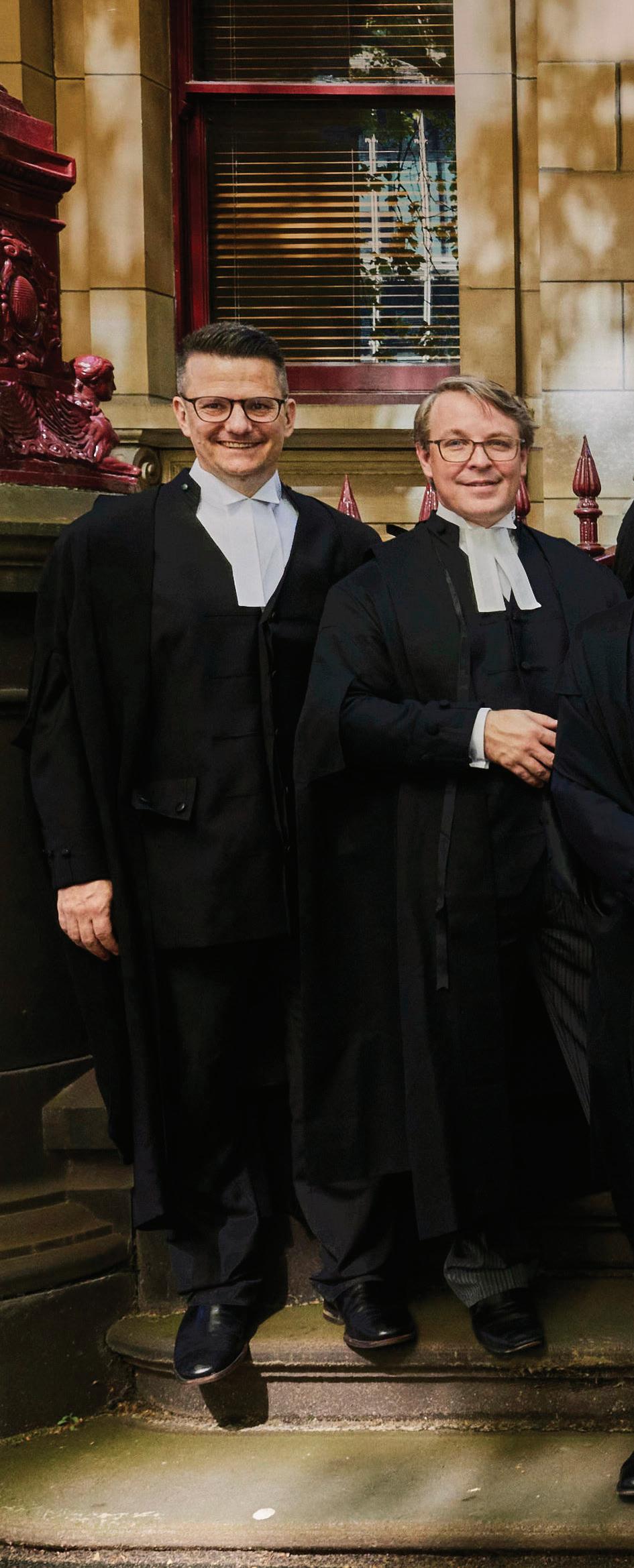
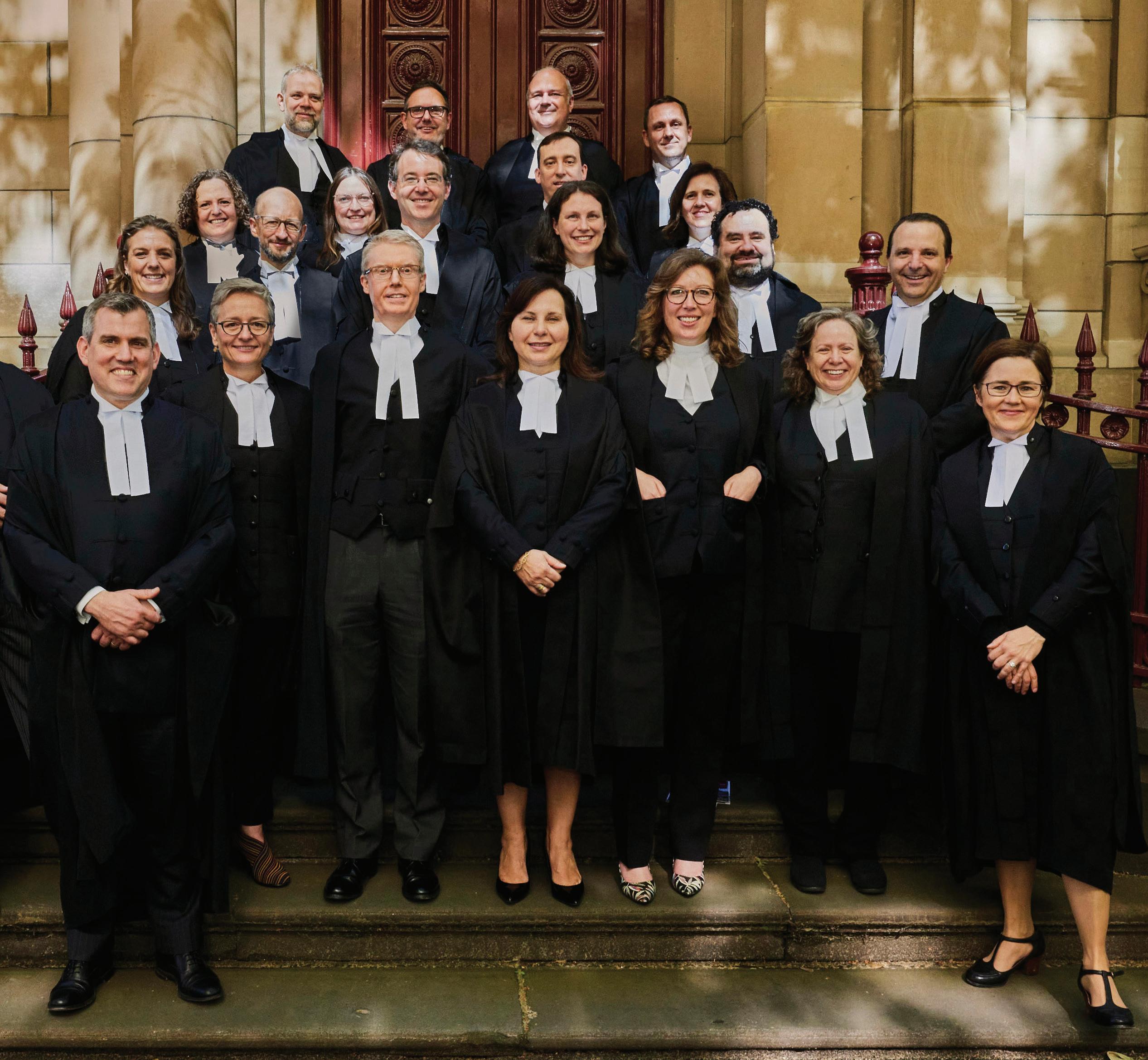
As is tradition, we asked the newest silks a few questions. Here is what they told us.

How did you celebrate the news of your appointment? At home, in COVID isolation.
Who has been a legal idol or mentor of influence to you? The Hon Dame Roma Mitchell QC was my legal idol as a law student in South Australia.
Who would play you in a movie, and why?
Nadine Garner, because I have admired her as an actor in Australian dramas for as long as I can remember.
What do you like most about the Bar?
The collegiality.
If you had to offer one tip to new barristers at the Bar, what would it be?
You can run your own race.
Read with Michael Gronow.

How did you celebrate the news of your appointment?
On a V-Line train to Geelong to get to court. Dinner with my family.
Who has been a legal idol or mentor of influence to you?
Very difficult to answer, too many to name. A few exceptional influences— Brendan Murphy KC, Con Heliotis KC, Daniel Gurvich KC, Ramon Lopez and Geoff Chettle.
Who would play you in a movie, and why?
Danny Devito—no explanation needed!
What do you like most about the Bar?
The friendships, the people and the work.

If you had to offer one tip to new barristers at the Bar, what would it be?
Don’t be in too much of a hurry, enjoy the ride and the days when you are not in court.
Read with Andrew McKenna.
Readers Morgan Brown, Simone Tatas, Anthony Pyne, Carlin Grant, Mihal Greener, Erin Rutherford, Nadia Deltondo, Jessica Mackay, Elle Addams.

How did you celebrate the news of your appointment?
With close friends and colleagues at the Foleys list dinner which was on the date of the announcement. There is, though, more to come.
Who has been a legal idol or mentor of influence to you?
Shirley Schmidt, Boston Legal. The perfect mix of all things a good lawyer should be.
Who would play you in a movie, and why?
Jamie Lee Curtis. The hair.
What do you like most about the Bar?
Slowly. And then I would say my Level 22 family.
If you had to offer one tip to new barristers at the Bar, what would it be?
Take a note of every brief you turn down which will help you realise that people do want to brief you, despite your belief that nobody will brief you (which still hasn’t gone away).
Read with Mark Rochford.
Readers Simon Thomas, Kylie McInnes, Michael Reardon.
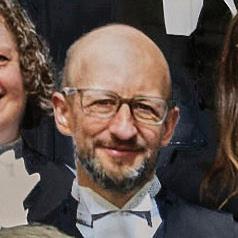
How did you celebrate the news of your appointment?
By pretending that a pre-arranged drinks evening on some colleagues’ floor had instead been thrown just for me. Followed by watching my three sons across a full weekend-long basketball tournament in Geelong.
Who has been a legal idol or mentor of Who would play you in a movie, and why?
I’m sure that any short, follically challenged actor could manage it, but yes, you’ve really put me on the spot with the “Why”. I hope it’s not because I’m murdered.
What do you like most about the Bar?
Support from colleagues, independence, and interesting work.
If you had to offer one tip to new barristers at the Bar, what would it be?
Stay in touch with your former solicitor colleagues and regularly ask how work has been treating them—it will likely reinforce for you the wisdom of your decision to join the Bar. Any briefs that come of it are a bonus.
Read with Tim Walker.

How did you celebrate the news of your appointment?
Over dinner and champagne with my wife and children—which descended into a lengthy Wordle-related argument about whether “y” can be a vowel.
Who has been a legal idol or mentor of influence to you?
All idols—Andrew Inglis Clark, Horace Rumple, Bram Fischer QC.
Who would play you in a movie, and why?
Mandy Patinkin (Inigo Montoya in The Princess Bride).“You keep using that word. I do not think it means what you think it means.”
What do you like most about the Bar?
The collegiality, the independence, the gossip. And that each day brings some interesting new catastrophe (one of the perils of practising insolvency).
If you had to offer one tip to new barrister at the Bar, what would it be?
“Back yourself. You’re better than you think you are.”
Read with Samuel Horgan.
Readers Adam Purton, Stephanie Hooper, Amanda Carruthers, David Foster, Nicole Tyson.

How did you celebrate the news of your appointment? I re-purposed (in part) my father’s birthday party. He didn’t seem to mind.
Who has been a legal idol or mentor of influence to you?
Gavin Forrest, formerly of Blake Dawson Waldron, to whom I had the privilege of being articled.
Who would play you in a movie, and why?
I was dreading this question. I expect Buster Keaton will have done something already that would be near enough. What do you like most about the Bar?
Collegiality.
If you had to offer one tip to new barristers at the Bar, what would it be?
Seize every opportunity to get before a Court or Tribunal.
Read with Jim Delany.
Readers Sergio Freire, Marcus Finlay.

How did you celebrate the news of your appointment?
With family, friends and LOTS of bubbles. The celebrations seem to be never ending, or at least until the end of 2022. Who has been a legal idol or mentor of influence to you?
Tony Kenyon, to whom I was articled to, and most of the common law silks I have worked with over the years.
Who would play you in a movie, and why?
I would be flattered whoever was picked. What do you like most about the Bar?
Being independent, and the flexibility to organise my next holiday when I like. It is the greatest job in the world (Shh!!! Don’t tell anyone).
If you had to offer one tip to new barristers at the Bar, what would it be?
Get on your feet at the first opportunity and do not concern yourself with who has the first brief out of your reader’s group or what others are doing. It is not an indication of your abilities.
Read with Robert W Dyer.
Readers YC Chen, Carina Moore, Tristsen Nathanielsz, Emily Anderson, Brendan Johnson, Christian Farinaccio, John Cooper.

How did you celebrate the news of your appointment? By treating myself to a quattro formaggio pizza.
Who has been a legal idol or mentor of influence to you? All those greats in IP who have led me over my time at the Bar (you know who you are).
Who would play you in a movie, and why?
A young Dustin Hoffman. You’ll see why when you google “young dustin hoffman”.
What do you like most about the Bar?
What I most like about the Bar is that I get to treat myself to quattro formaggio pizza when I am appointed silk. On a more serious note, I have immensely enjoyed the opportunity to work with a range of different instructors and colleagues in my practice area.
If you had to offer one tip to new barristers at the Bar, what would it be?
Find a good mentor to guide you through not only your reading period but beyond. Also, and perhaps most importantly, when you pass notes to your leader across the bar table make sure your handwriting is legible.
Read with Rodney McInnes.

How did you celebrate the news of your appointment?
Dinner with family.
Who has been a legal idol or mentor of influence to you? Peter Murdoch KC. Who would play you in a movie, and why?
Chris Hemsworth, to avoid a box office flop.
What do you like most about the Bar? Collegiality.
If you had to offer one tip to new barristers at the Bar, what would it be?
Keep trying.
Read with Richard Manly.
Readers Nicholas Phillpott.

How did you celebrate the news of your appointment?
With a mediation that finished at 9pm.
Who has been a legal idol or mentor of influence to you? My mentor on joining the Bar, now the Hon Justice Michael Osborne.
Who would play you in a movie, and why?
Val Kilmer, have you seen him lately?
What do you like most about the Bar?
The Bar is unique in that barristers run individual practices, yet support one another in ways very rarely seen in legal partnerships.
If you had to offer one tip to new barristers at the Bar, what would it be? Make sure that the work you do is your best work.
Read with Michael Osborne.
Readers Samauel Burt, Nick Modrzewski, Michelle Bennett, Haley Aprile.

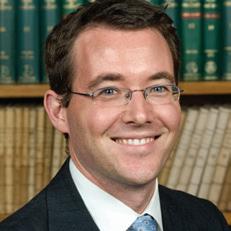
How did you celebrate the news of your appointment?
Explaining to my kids what I do for a living, followed by my favourite takeaway and a glass of red wine. Who has been a legal idol or mentor of influence to you?
David Shaw and Charles Power at Holding Redlich, who gave me my first job as a solicitor, and who were wonderful mentors in my formative years as a lawyer. Who would play you in a movie, and why?
Beaker from the Muppets. It is going to be a Muppet movie.
What do you like most about the Bar? The independence and the collegiality.
If you had to offer one tip to new barristers at the Bar, what would it be? Treat others as you would want them to treat you. (Not like Dr Bunsen Honeydew treats Beaker.)
Read with Bernard Quinn.
Readers Christopher Lum, Conrad Banasik, Ganesh Jegatheesan, Anna Batrouney, James Page, Michael Thomas, Catherine Pase, Owen Nanlohy.

How did you celebrate the news of your appointment?
I contacted family and friends to share the news.
Who has been a legal idol or mentor of influence to you?
Too many colleagues to name. What do you like most about the Bar? The collegiality of the Bar.
If you had to offer one tip to new barristers at the Bar, what would it be?
Not to ignore your instincts.
Read with The Hon Justice Stephen A O’Meara.
Readers Mr Antony L Berger, Ms Jeremy Kaitzis, Mr J Macaskill, Ms Jade K Ryan, Mr Tim D Staindl.
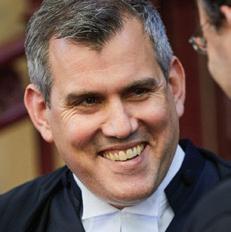
How did you celebrate the news of your appointment?
I phoned my wife, read some lovely messages for a few minutes, hugged some colleagues, then realised I still had to make sense in court at 10.30am, so returned to annotating Johns v Australian Securities Commission (1993) 178 CLR 408. Who has been a legal idol or mentor of influence to you?
Emilios Kyrou gave me a job as a first-year solicitor at Mallesons Stephen Jacques, on the basis of an interview, even though my CV did not tick the conventional boxes. Then he taught me how to be a lawyer. I will never forget the morning he spent a whole hour going through a four-page letter I had drafted and explaining why he had made each change. I would not be where I am if he had not taken a chance on employing and mentoring me. Who would play you in a movie, and why?
Eric Bana, because that is who I chose when, during a conference in the chambers of Peter Hanks KC at the height of the Lawyer X litigation, we somehow got onto who would play us in a mini-series.
What do you like most about the Bar?
The privilege of working with clients and solicitors who believe that human beings can do better.
If you had to offer one tip to new barristers at the Bar, what would it be?
Do as much pro bono work as you possibly can, within your own particular constraints. With privilege comes responsibility.
Read with Jason Pizer.
Readers Monika Pekevska, Rachel Amamoo, Rutendo Muchinguri, Maya Narayan, Tessa Meyrick, Nicholas Petrie, Katharine Brown, Laura Schuijers.
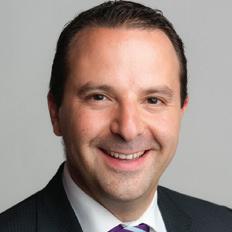
How did you celebrate the news of your appointment? Dinner with my wife, our three children and my parents. My youngest seemed happiest when informed that he would get a day off school for our bows.
Who has been a legal idol or mentor of influence to you? The Hon Murray Gleeson KC. He has never used one more word than necessary, judicially or extra-judicially.
Who would play you in a movie, and why?
I love Roberto Benigni in Life is Beautiful so here’s hoping that he would be available to take the role. If he can only perform in Italian, so be it.
What do you like most about the Bar?
I love being able to research the law to be able to find solutions to problems for people.
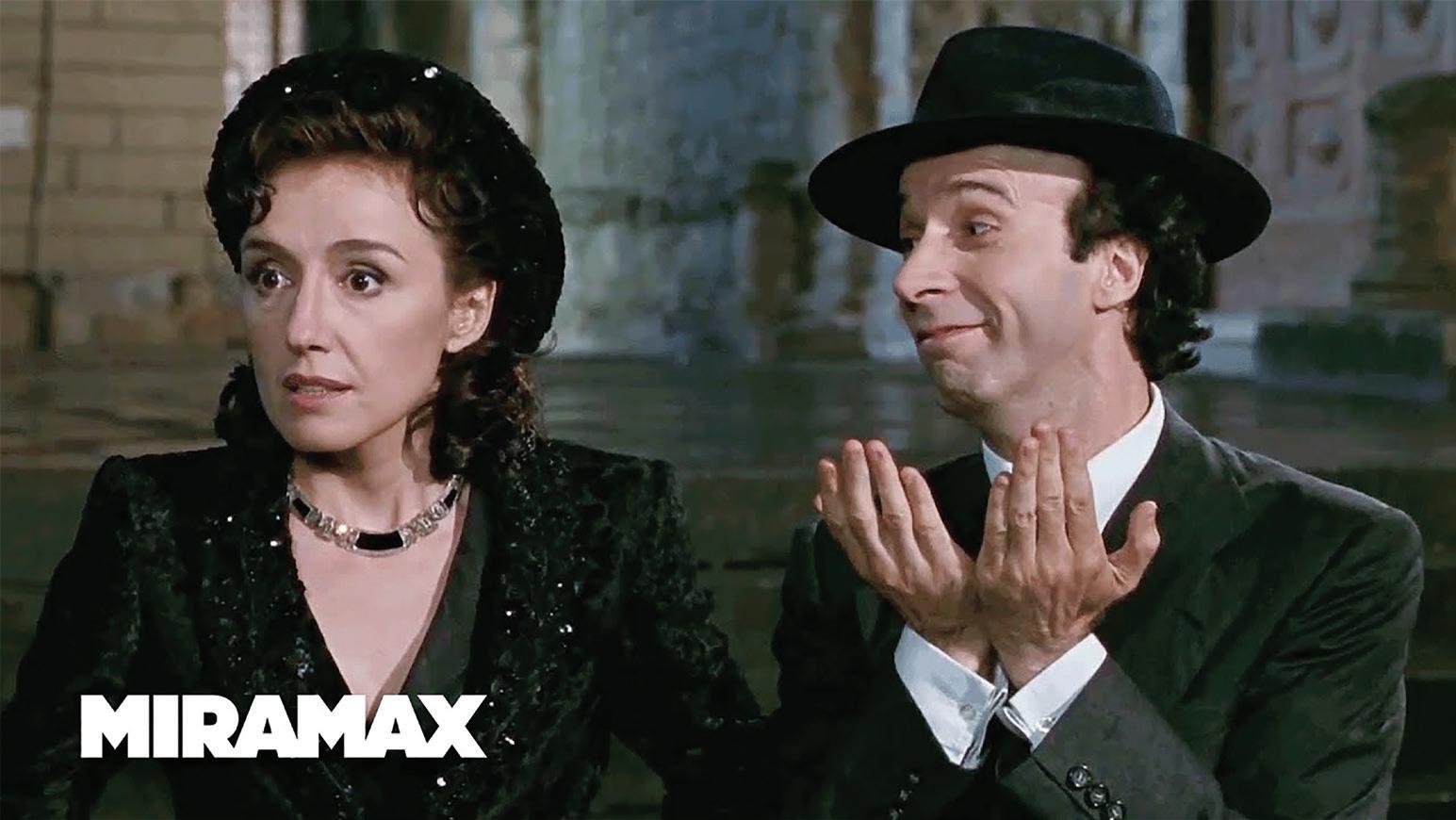

How did you celebrate the news of your appointment?
Champagne and pizza at home with my family, including my parents who jumped in the car and drove up from the country when they heard the news. Who has been a legal idol or mentor of influence to you?
Peter Gray KC and Philip Solomon KC.
Who would play you in a movie, and why?
I can hear my kids complaining “this moving is boring!”… But in my dreams it would be Olivia Munn, because I’m a nerd and Sloan Sabbith from The Newsroom is the coolest nerd ever.
What do you like most about the Bar?
The independence and collegiality.
If you had to offer one tip to new barristers at the Bar, what would it be?
Hang in there—making 485 decisions a day is stressful in the beginning, but eventually you learn to trust your instincts and it gets easier.
Read with Peter Gray.
Readers Anna O’Callaghan, Huw Whitwell, Sophie Molyneux, Tony Middleton.

How did you celebrate the news of your appointment?
After the initial shock wore off—with Champagne and cocktails! Who has been a legal idol or mentor of influence to you?
This is a difficult one because I’ve been fortunate to work with so many clever and talented people over the years, and I’ve learnt something from each and every person. If I’m forced to choose only one, then it would have to be Steward J, who was a junior tax silk when I first came to the bar and was always very generous with his time and his advice, as well as being brilliant.
Who would play you in a movie, and why?
Melissa McCarthy—because I suspect it would be a comedy.
What do you like most about the Bar?
I know that I should say the collegiality (which is, of course, excellent), but for me it’s really the independence, which includes freedom from bureaucracy. If you had to offer one tip to new barristers at the Bar, what would it be?
It can be hard to believe at the time, but everyone is right when they say it will be ok—so try to enjoy yourself.
Read with James Gorton.
Readers Joel Phillips, Nick Dodds.

How did you celebrate the news of your appointment?
Lunch with Dinelli SC and our readers, followed by floor drinks.
Who has been a legal idol or mentor of influence to you?
Just one? Denny Crane.
Who would play you in a movie, and why?
Tom Hiddleston—we’re about the same age, but he’s an improvement on me in every conceivable way.
What do you like most about the Bar? Its collegiality.
If you had to offer one tip to new barristers at the Bar, what would it be?
Stay well away from Twitter, LinkedIn etc.
Read with Debbie Mortimer.
Readers Min Guo, Matthew Keneally, Jacqui Katsivas, Suganya Pathan.

How did you celebrate the news of your appointment? With Champagne.
Who has been a legal idol or mentor of influence to you?
Can’t choose one—AC. Archibald KC, AJ Myers KC, the Hon Justice John Eric Middleton and PD Crutchfield KC (my mentor).
Who would play you in a movie, and why?
Apparently I bear a passing resemblance to the actor Mark Ruffalo, so him.
What do you like most about the Bar?
Truly interesting and challenging work and you are (most of the time, at least…) your own boss.
If you had to offer one tip to new barristers at the Bar, what would it be?
When the phone rings with a new brief or opportunity, think about it for five seconds and then say yes.
Read with Philip Crutchfield.
Readers Nicholas Guenther, Amel Masinovic, Annette Gaber, Mark James.

How did you celebrate the news of your appointment?
Bubbles at 9.44am.
Who has been a legal idol or mentor of influence to you?
I’m very grateful that there have been many in my time as a barrister.
Hopefully they know who they are.
Who would play you in a movie, and why?
Tina Fey. She’s driven, brave and knows how to have a laugh.
What do you like most about the Bar?
The challenge in the work, the collegiality of the Bar and the friendships I have formed over the years.
If you had to offer one tip to new barristers at the Bar, what would it be?
Form and nurture strong mentoring relationships.
Read with Lachlan Armstrong.

How did you celebrate the news of your appointment?
I called my wife and a few close friends … then continued to prepare for the day’s case in the SCV, before turning to prepare for the six-week trial starting the following Monday. Proper celebrations with family, friends and colleagues will follow! Who has been a legal idol or mentor of influence to you?
I am tempted to refuse to answer, on the ground that this is one of those lose-lose questions that might have been put to counsel by the Hon WMC Gummow KC, and deftly answered by Mr DF Jackson KC, or Mr MBJ Lee SC (as his Honour then was). Oh, wait, it seems I just (partly) answered it!
Who would play you in a movie, and why?
Some might say Gene Hackman has the requisite experience, given the film Class Action, though that might be regarded as taking too extremely my wish to look older than I do. (I wanted to suggest Pierce Brosnan, but my wife and kids thought that was far-fetched).
What do you like most about the Bar?
One of the mysteries of the Bar is that although we are sole practitioners, we are also part of a collective which brings many diverse perspectives, skills and experiences together to improve outcomes. The best litigation teams operate this way, and I enjoy being part of them. If you had to offer one tip to new barristers at the Bar, what would it be? Don’t have a preconceived idea as to what your practice will be, and do honour the cab-rank rule. Were it not for this, I would have never run a class action, never practised in Victoria, never had the wonderful professional relationships I now have with solicitors, colleagues at the Bar and the judiciary, and never become part of the Tiger Army!

How did you celebrate the news of your appointment?
After dropping my tooth brush in shock, I was straight into the commencement of a final hearing but later in the day I had visits from friends and family with wonderful flowers and some bubbles. Who has been a legal idol or mentor of influence to you?
I was inspired to a career at The Bar at just 15 by Anthony Clarke—who was then an admiralty silk and went on to the UK Court of Appeal, Master of the Rolls and finally to the UK Supreme Court. The way he asked questions and his infectious love of advocacy were formative but I think my passion for the particular type of work I do was formed even earlier, from my parents, whose example of being with people in times of crisis and distress was inspirational and who instilled in me the Martin Luther King (and others) concept of being a ‘voice for the voiceless’.
So many people in both my time at the UK Bar and since coming to the VicBar have been influential and generous with their experience, wisdom and encouragement and in the case of the latter, also most forbearing of my peculiarities!
Who would play you in a movie, and why?
This question definitely caused me the most difficulty—I have settled on Kate Winslett because she could get the voice right. What do you like most about the Bar?
I love that each day and each case is different and that you get the independence to choose your own path in your practice but are not alone because of the friendship and camaraderie of The Bar.
If you had to offer one tip to new barristers at the Bar, what would it be?
Ensure that this is something that you really enjoy—life as a barrister can be all consuming for me the English phrase “called to The Bar” has a truth behind it. If this is not a role that you genuinely enjoy, then don’t do it—it will make you very unhappy and it will show in how you perform. That said, however much you enjoy and are passionate about it, don’t lose sight of the need to have balance and invest in other parts of your life. Conscious of the fact that I’m bordering on three tips, it is also vital that you develop and follow an instinct for what is right. No case, solicitor or point is ever worth compromising your ethical standards.

How did you celebrate the news of your appointment?
In various ways: I went to court and announced my change in appearance; I had a couple of drinks with my colleagues in chambers after court; I went home and celebrated with my daughter; and my various mentors took me to lunch or dinner. And, of course, we had the silks’ bows, which was a wonderful day. Who has been a legal idol or mentor of influence to you?
Justin Bourke KC; Stuart Wood AM KC; and Róisín Annesley KC. I am incredibly lucky—I hit the mentor jackpot. What do you like most about the Bar?
The spirit of collegiality that runs through the veins of almost all members of the Bar. This is particularly worthy of note given that we are essentially all direct competitors of one another.
If you had to offer one tip to new barristers at the Bar, what would it be?
As counsel, it is absolutely critical to display good judgement. If you develop a reputation for lacking judgement, it will be very hard to shake. Judges have long memories!
Read with Justin Bourke.

My last column, which was called “Coronavirus,” ended with these words:
So, we are told that the COVID-19 pandemic is over. Time will tell. Is it possible that Fate has more surprises in store for us? Which brings me back to Janine Gleeson’s email.

She says that the next edition of VBN is to be themed “Welcome back from COVID.” That theme assumes that we have defeated the pandemic. Is it too pessimistic to say that the theme might be more accurate if we delete the word “from”? So: Welcome back COVID.
The last edition of Bar News (Issue 171, Winter 2022) was titled “The Great Return”. The sub-title was ”Celebrating working life out of lockdown.”
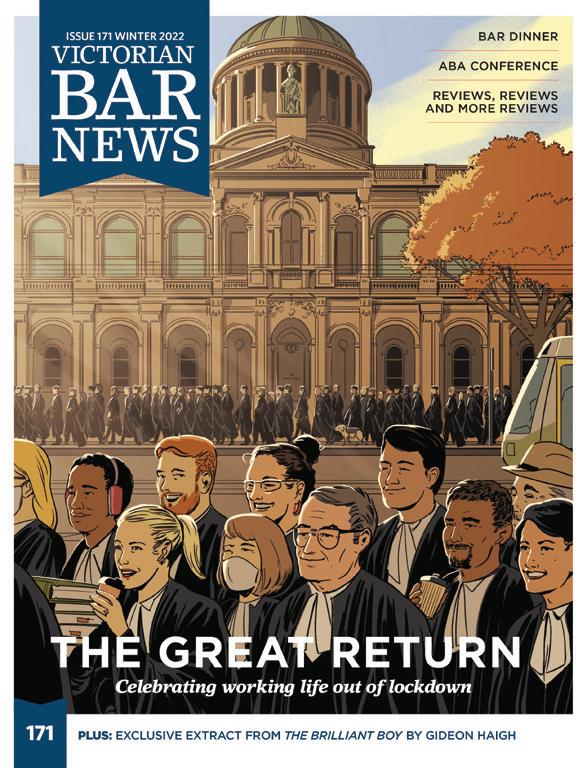
I don’t know whether my prediction was more or less right, but to think that we are free of Coronavirus right now seems a bit optimistic. 3 November 2022 saw 1683 new cases, mostly in Victoria, suggesting that another Covid wave has started. It may be that my cynical observations last time were accurate.
“The Great Return” offers only limited possibilities for language discussion. Return offers few surprises: it is a very old word, from the Anglo-French retorne. Quotations in OED4 go back to 1390. Johnson (1709-1794) in his 1785 edition defines “return” (the verb) as “To come again to the same place”, and gives the noun a very similar meaning. OED4 defines “return: as “The act of coming back to or from a place, person, or condition”. By contrast, “great” is full of surprises. OED4 says of it:
On the assumption that the primary sense is ‘coarse’ (sense 1 below), some scholars regard the word as cognate with Old Norse graut-r porridge, Old English grút fine meal, grot particle, grytta coarse meal, gréot sand, gravel, Old Norse griót stones. But the connexion is not free from difficulty, as the cognates of these words outside Teutonic point to a root meaning ‘to pound,’ a sense from which that of the adjective is not easily derived. It has been suggested that a cognate of the Teutonic adjective may exist in the Old Irish gruad cheek (? literally ‘thick or fleshy part’ of the face; cf. sense 2 below, and the contrasted notion in Old English þunwang, literally ‘thin cheek’, the temples). The prevailing senses in Old English are ‘coarse, thick, stout, big;’ but the word also appears as an intensive synonym of micel mickle, which in the later language it superseded.
It is a relatively rare instance of OED4 offering an essay about a word before embarking on definitions and quotations. The first definition is:
A adj I Thick, coarse, massive, big.
1a Composed of large particles; coarse of grain or texture. Of diet: Coarse, not delicate. In Old Cookery, applied sometimes to boiled meat in contradistinction to roast.
I don’t think that is what the last issue of Bar News meant, unless “big” was the intended meaning, ignoring the explanation in 1a. That said, none of the definitions in OED4 come even close to what the last issue meant (and we all, especially BCL, understood). Arguably the closest definition is the fourth:
4 Full or ‘big’ with courage, emotion, anger, sorrow, or pride; angry, grieved; proud, arrogant. Often qualifying heart
Interestingly, this definition comes immediately after this:
3 Pregnant; far advanced in pregnancy which Bar News certainly did not mean. This makes more sense when you consider definition 2:
2a Thick; stout, massive, bulky, big. (Opposed to small in its original sense of ‘slender.’) Obsolete. except Scottish (in form grit or gryte). a Of things.
2b Of persons and animals: Stout, corpulent.
OED4 does not refer to, or quote from, Arthur Machen’s book. It refers to him just once, in the definition of roman:
“…1913 G. Turquet-Milnes Influence of Baudelaire v. v. 250 In his [sc. Arthur Machen’s] works we again meet the distrust of nature from the documentary point of view—the distrust of ‘Romans à Clef’.”
Machen’s book The Great Return was published on 1 January 1915 Johnson’s 1875 edition has 20 definitions of “great” as follows:
1. Large in bulk or number
2. Having any quality in a high degree
3. Having number or bulk; relative or comparative
4. Considerable in extent or duration
5. Important; weighty
6. Chief; principal
7. Venerable; adorable; awful
8. Wonderful; marvellous
9. Of high rank; of large power
10. General; extensive in consequence or influence
11. Illustrious; eminent; noble; excellent
12. Grand of aspect; of elevated mien
13. Magnanimous; generous; high minded
14. Opulent; sumptuous; magnificent
15. Intellectually great; sublime
16. Swelling; proud
17. Familiar; much acquainted. A low word
18. Pregnant; teeming
19. It is added in every step of ascending or descending consanguinity
20. Hard; difficult; grievous. A proverbial expression
It is worth noting that, in the 1818 edition (the first posthumous edition of Johnson) Dr Todd corrected the numbering. Unsurprisingly (given its date) Machen’s book is not mentioned in the original Johnson or in Todd’s edition.
All these meanings are supported by definitions. It is difficult to see which of these meanings the Bar News meant.
The most notable thing about the sub-title is that “lockdown” does not appear anywhere in Johnson or OED4. Perhaps all of this tells us something about language, or perhaps just about dictionaries, and yet we all understood the title and the sub-title. Even the 3rd edition of the Macquarie Dictionary doesn’t have an entry for “lockdown”, although it has an entry for lockup. The OED4 doesn’t include an entry for lockup although it appears as lock-up.

“I agree”
PETER GRAY
In the dominant communication culture in Australia, we take yes to signify agreement. When we ask a question, or assert something,
and our interlocutor says yes, we understand that they agree with what we have asked or asserted.
Of course, there are exceptions to this. Sometimes, we say yes or okay, or give an affirmative m-hm,
just to show that we are listening, we respect our interlocutor, and we want to keep the conversation going. People who are linguistically, socially or culturally vulnerable will often seem very agreeable. Someone whose first language is not English might not really be following what is being said, but not want to admit that they do not understand. They express apparent agreement because it is the safest thing to do.
Power imbalances can produce apparent, but not real, agreement. We know that young children are suggestible or prone to giving the answer that they think is expected. Sometimes they will agree with an adult, even if they know that what the adult has said is not true. We know that teenagers under arrest sometimes agree with anything the police say. They just want to bring the stressful situation to an end, not to exacerbate it.
For decades, the law has recognised that Aboriginal people are prone to expressing apparent agreement with police. A linguist gave this tendency the name gratuitous concurrence in the early 1980s1. Again, the power imbalance behind it is obvious. As long ago as 1976, the Supreme Court of the Northern Territory gave the police guidelines for interrogating suspects2. In part, these guidelines were designed to mitigate the power imbalance and to avoid the possibility of gratuitous concurrence:
(4) Great care should be taken in formulating questions so that so far as possible the answer which is wanted or expected is not suggested in any way. Anything in the nature of cross-examination s hould be scrupulously avoided as answers to it have no probative value. It should be borne in mind that it is not only the wording of the question, which may suggest the answer, but also the manner and tone of voice which are used.
1 K Liberman, Ambiguity and Gratuitous Concurrence in Intercultural Communication (1980) 3 Human Studies, 65-85.
2 R v Anunga [1976] 11 ALR 412.
(5) Even when an apparently frank and free confession has been obtained relating to the commission of an offence, police should continue to investigate the matter in an endeavour to obtain proof of the commission or the offence from other sources.
Failure to do this, among other things, led to the rejection of confessional records of interview in the cases of Nari Wheeler and Frank Jagamala.
Dr Diana Eades is Australia’s leading expert on communication with First Nations peoples. She defines gratuitous concurrence as:
The conversational feature of saying yes in answer to a question (or no to a negative question), regardless of whether you agree with the proposition being questioned, and sometimes without even understanding the question3
As well as producing false “confessions” from suspects, gratuitous concurrence can lead to falsity in witness statements taken by police. In the review of the conviction of Gene Gibson in Western Australia, the Crown conceded that two Aboriginal witnesses it had proposed to call at the trial were unreliable4. Their statements were more the result of the police putting words into the mouths of the witnesses than they were about the witnesses’ observations.
A recent judgment of the Federal Court of Australia5 has shown gratuitous concurrence in a new light. Justice Abraham found that the respondent had contravened several statutory provisions concerning the sale of financial products, mainly life insurance and funeral insurance. Among those who had apparently agreed to buy the products were Aboriginal people living in remote
3 D Eades, Aboriginal Ways of Using English, (2013), Aboriginal Studies Press, at p 221.
4 Gibson v The State of Western Australia [2017] WASCA 141 at [143] and [210].
5 Australian Securities and Investments Commission v Select AFSL Pty Ltd (No 2) [2022] FCA 786.
Power imbalances can produce apparent, but not real, agreement.
communities. Her Honour found that some of these people had a socio-cultural tendency towards gratuitous concurrence6. In making those findings, her Honour accepted the expert evidence of Dr Eades about gratuitous concurrence among Aboriginal people7
The findings in Select AFSL show that gratuitous concurrence is not only an issue in the criminal justice system. The Aboriginal victims of the hard sell were not being interviewed by police. They received telephone calls from pushy salespeople. There was much less power imbalance than there is between an Aboriginal suspect or potential witness and police officers in a police station. Indeed, each salesperson knew that their potential customer could end the call at any time by hanging up the phone. The sales techniques they used were calculated to prevent this happening. Where possible, they used the names of people from the potential customer’s community, suggesting that those people had recommended that they call the potential customer. They spoke quickly. They did not pause to allow the potential customer to disagree or object. If the potential customer tried to object, the salesperson spoke over them and continued to speak.
The language of the spiel involved big words and insurance industry jargon. The requisite product disclosure statement was delivered by a voice recording, which the salesperson played during the call, without seeking or obtaining the consent of the potential customer to receive the statement in that
6 Select AFSL at [499]-[500] and [558]; [568]-[569]; [918]-[919] and [937]; [957][958] and [976]; [986]-[987]; [1158][1160] and [1203].
7 Select AFSL at [110]-[120] and [316][318]. In preparing her expert report, Dr Eades was helped by Alex Bowen, a lawyer who is pursuing a PhD in linguistics at the University of Melbourne.
form. Throughout each call, the salesperson assumed that the result of the call would be a sale, that the potential customer would become an actual customer and would supply their bank account details, so that the company could begin helping itself to premiums. Sadly, in several instances, this assumption proved to be correct.
The victims of this sales campaign were vulnerable people. Many of them, including some of the Aboriginal victims, were vulnerable for a combination of linguistic, social and cultural reasons. Some spoke Australian Aboriginal English, a dialect of English that differs from Standard Australian English lexically and syntactically. In some cases, that dialect was not a first language. Many gave evidence that they did not understand the transactions the salespeople were trying to negotiate with them. Socially, some were conditioned by their life experiences to understand that appearing to cooperate with demands made on them by non-Aboriginal people is easier than opposition. Culturally, some recognised close ties of kinship with people in their own remote communities, whose names the salespeople used to ingratiate themselves. In many instances, the responses of these potential customers contained clear indications that they were vulnerable. The salespeople ignored those indications and did nothing to investigate possible vulnerability.
The lesson from this case is obvious. In any sort of dealing, commercial or otherwise, we should not assume that apparent agreement is really agreement with what is proposed. This is particularly so if the person who appears to be agreeing is vulnerable, for linguistic, social or cultural reasons.

Dear Red Bag,
I have a rather tasty (hard cash money in my Clerk’s trust account!) injunction brief pending. My brilliant strategy turns on me bringing the matter ex parte so that I can, in my own poorly crafted emulation of your eloquence, poison the judicial well in the absence of any inconvenient contrary argument and, with luck, get away with no undertaking as to damages. A truly masterful plan, is it not?
Yours truly,
Blue Bag.
My dear Blue Bag,
In my long experience, well one considerably longer than yours, I have always found it expedient, that whenever I can, to try to avoid booking a forward-section berth (or in my case First Class suite) on the SMS Titanic whilst planning something akin to a late winter voyage across the North Atlantic. The perils of
advising a client, who is otherwise keen to crucify their protagonist at any cost, to proceed with an injunction in haste in the absence of an opponent, are quite often later enjoyed over an ensuing and lengthy period of bitter and unsavoury repentance!
Indeed, clients who earnestly desire that the court channel Judge Jeffreys and impose draconian outcomes and condign consequences on others, without a semblance of just representation, would be well to be reminded to beware of what they wish for, as they may very well get it themselves!1
First and foremost, you must ask yourself the question, what is the dire necessity or risk that warrants not giving prior notice to the other side? What is the very worst thing that is likely to happen if you give prior notice to the would-be defendant? Even if only the night before? Can it be sensibly ameliorated in any way? And then, inevitably, how will you answer the judge’s first question to that very same effect? If a ready string of irresistibly clear and correct monosyllabic responses does not immediately spring to your lips, then, perhaps, ‘to ask the question is but to answer it’!
Secondly, in a hard or complex urgent case, where you are already developing your legal arguments on the run,
you have inconvenienced a judge who has listed an urgent ex parte hearing at your behest, rather than being left at leisure to scoff down a huge postmeridian repast, where the underlying facts are barely emerging in hastily prepared affidavits (and I trust that you will not forget to charge separately for settling them though!) and where, like a one-armed fair-ground jongleur you already have as many balls in the air as you are ever likely to need (or can barely manage), why would you ever wish to add yet another ball, being that of the duty of full and fair disclosure in the other party’s absence,2 to the cyclone of spherical objects otherwise spinning merrily, if precariously, before your very eyes?
Thirdly, and just to make matters worse, it is also accepted that a barrister appearing ex parte also has a duty to draw the court’s attention to relevant authorities of which they are reasonably aware that would support an argument against their client’s case.3 And it is not much of an excuse to have to later confess to an irascibly inquisitive judge that one missed hearing of a key case on a topic (which just so happened to conclusively govern the matter at hand) whilst absent from the university lecture which covered it due to an unavoidable commitment at the Clyde Hotel. Nor does it do one’s professional reputation very much good to have one’s shameful ignorance of a basic legal principle paraded before all the world, much like Cersei Lannister’s march of “Shame” in Game of Thrones or, worse, Sir Joh Bjelke-Peterson’s famous exposition on the “Separation of Powers”.
Fourthly, and perhaps most tellingly of all, in the absence of an advocate for the other side, you are likely to find the resultant vacuum in representation filled by the most dangerous combatant of all, the judge themself stepping boldly into the breach! The judicial temptation of helpfully playing ‘devil’s advocate’ in such a scenario, with all the
Just as you must make full and fair disclosure to the Court when applying for an ex parte order, you are obliged to make full and fair disclosure when the proceeding returns to the Court on the hearing of the application on notice.
inventive Satanic power of Hell itself on an inclemently hot day, is often so overwhelming that one does not lightly proffer such a juicy and delicious apple to their Honours. It may only take one bite by the Bench and you and your client may well find yourselves rudely ejected out of Eden into a far, far less nice place! Indeed, just as you must make full and fair disclosure to the court when applying for an ex parte order, you are obliged to make full and fair disclosure when the proceeding returns to the court on the hearing of the application on notice. This may be necessary to correct any errors in the material put before the court on the first occasion. You will still bear that obligation regardless of whether or not the defendant appears at the second hearing?4 So you had best as well get it right the first time! Ultimately it may prove to be a rather frigid comfort to you as counsel, who allegedly failed to make the required “full and fair disclosure”, to learn, after your conduct has been duly scrutinised in open court through the scarlet-hued prism of an outraged opponent’s perspective, that not every omission in such disclosure requires that:
“…the injunction will be automatically discharged. A locus poenitentiae may sometimes be afforded ... the court has a discretion notwithstanding proof of material non-disclosure which justifies or requires the immediate discharge of the ex parte order, nevertheless to continue the order or to make a new order on terms.”5
As for trying to fly beneath the radar of the requirement to give an undertaking as to damages, and though the temptation be sweet, eschew it, eschew it at any cost, as greater barristers than you
have crashed in fiery inferno after proceeding in its absence!6 Indeed, it has been said that counsel have a positive duty to raise the undertaking and if they are so brave, then to make good an argument as to why exceptional circumstances may warrant its absence in the case at hand.7
Frankly, it all sounds to me very much like you rather need a leader in this plainly very important “hard cash money in the Clerk’s trust account” brief. And so, my dear Blue Bag, much like Hamlet’s Father, I close by saying, “Good bye, good bye, good bye. Remember me!”
1 As the Full Court famously quoted in National Australia Bank Ltd v Bond Brewing Ltd [1991] 1 VR 386 at 553: “The plaintiff, like the witch in Hansel and Gretel, may want a receiver to cage the defendant and fatten him up so he will make better eating, or at least to prevent him from wasting away…” Their Honours then explaining in letters writ large just why in that case, such a desire was not to be satisfied. And there, just like the witch in the fairy tale, the ex parte application for a receiver met a very grisly end!
2 Thomas A Edison Ltd v Bullock (1912) 15 CLR 679 at 681-2, see also Redwin Industries Pty Ltd v Fleetsafe Pty Ltd [2002] VSC 427 and the authorities referred to by Habersberger J at [8]. This is sometimes characterised as that most dreadfully heavy of burdens, i.e. as a duty of utmost good faith to disclose fully all of the material facts: Savcor Pty Ltd v Cathodic Protection International (2005) 12 VR 639 at [24]
3 Rule 27, Legal Profession Uniform Conduct (Barristers) Rules 2015 but see too Commissioner of Taxation v Zeitouni (2013) 306 ALR 603 at [88] per Katzmann J.
4 Redwin Industries Pty Ltd v Fleetsafe (supra) at [12].
5 Brink’s Mat Ltd v Elcombe [1988] 1 WLR 1350 per Ralph Gibson LJ at pp 13561357.
6 Op. cit. nr 1, at 574-6.
7 Papas v Grave [2013] NSWCA 308 at [79]-[81].
ED HEEREY
One of the great advantages of being a member of the NSW Bar Association is free delivery of the NSW Bar News, which I keep by my bedside for those times when Temazepam just won’t kick in. Only the most extreme insomnia could withstand a perusal of articles such as “The characterisation of risk in ss 5B and 5L of the Civil Liability Act 2002 (NSW)”
As far as I can tell, the NSW Bar News has never featured a music column, and certainly not one as self-indulgent as the one you are reading now. Anyhoo, after some polite but persistent badgering by your diligent editors for another column, I decided to test the limits of said self-indulgence with an examination of the five greatest bass players you have probably never heard of, 1 but definitely have heard
James Jamerson played bass on 23 US number one hit songs. The only bass player to surpass that record is Paul McCartney, with 24. Jamerson racked up most of those hits as a member of the legendary “Funk Brothers” backing band employed by Motown Studios in Detroit from 1959 to 1973.
He played on some of the greatest soul and RnB hits of the 1960s, including “My Girl” with The Temptations (1964), “Dancing in the Street” with Martha and Vandellas (1964), “Going to a Go-Go” with Smokey Robinson and The Miracles (1965), “You Can’t Hurry Love” with Diana Ross and The Supremes (1966), “For Once in My Life” with Stevie Wonder (1968) and “I Heard it Through the Grapevine” which he recorded twice, first with Gladys Knight and the Pips (1967) and later with Marvin Gaye (1968).
Jamerson’s background was playing upright acoustic bass in jazz bands, but at Motown he pioneered a new style of playing electric bass. Rather than simply playing root notes, and simple repetitive patterns, he relied heavily on chromatic runs, syncopation, ghost notes and inversions, with frequent use of open strings. His style was an integral part of the “Motown Sound”, and he created melodic lines that were nonetheless locked to the drum groove. He described his creative process like this:

They would give me the chord sheet, but they couldn’t write for me. When they did, it didn’t sound right. ... When they gave me that chord sheet, I’d look at it, but then start doing what I felt and what I thought would fit. ... I’d hear the melody line from the lyrics and I’d build the bass line around that. 2
Perhaps his finest work was on Marvin Gaye’s masterpiece album “What’s Going On” (1971), but it almost did not happen at all. According to fellow Funk Brothers in the 2002 documentary Standing in the Shadows of Motown, Gaye was desperate to have Jamerson play on “What’s Going On”, and went to several bars to find the bassist. When he did, he brought
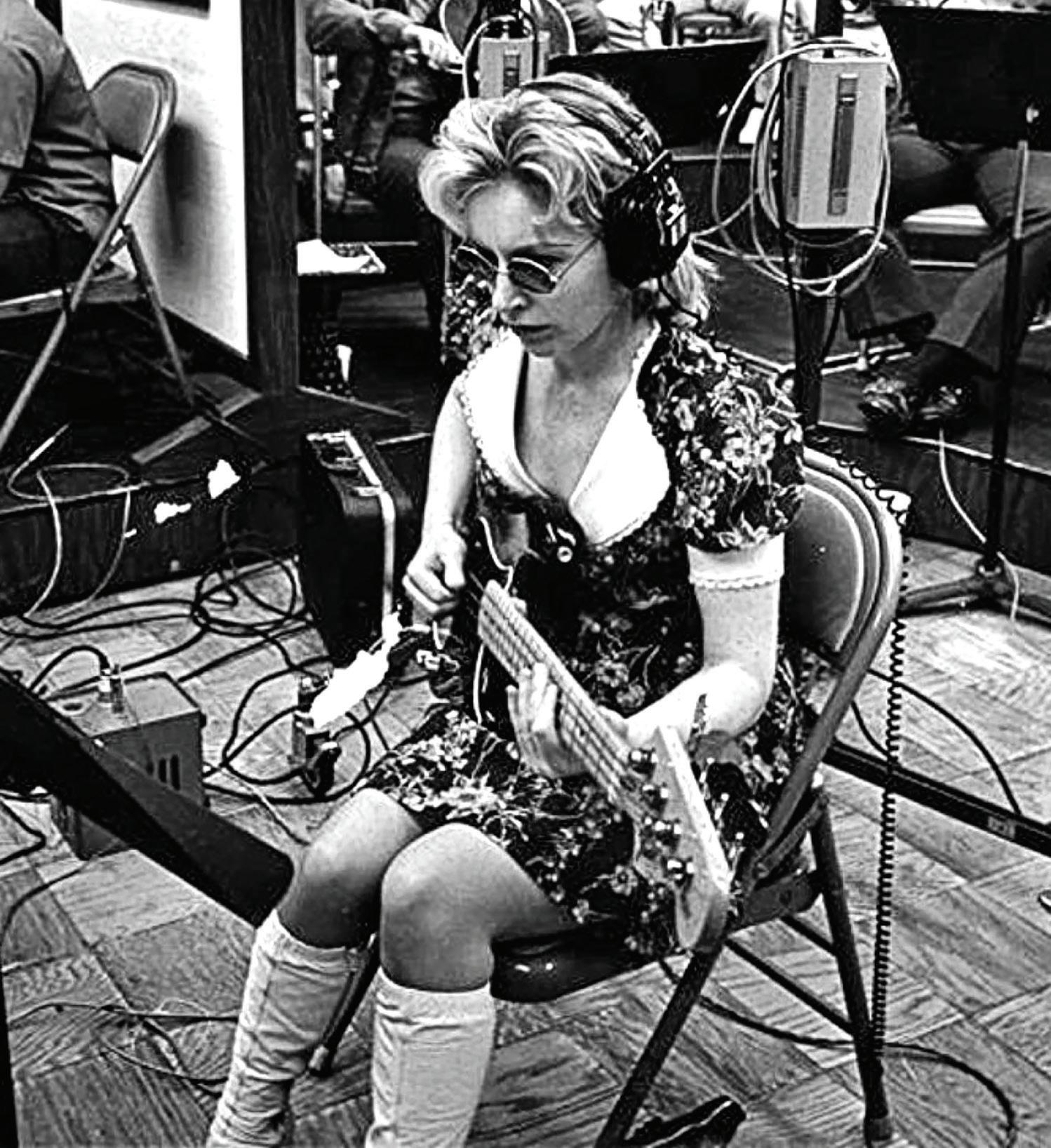
Jamerson to the studio, but Jamerson was too intoxicated to stay upright, so he played the classic line while lying flat on his back.
A fascinating, indeed haunting, version of that title track is available online, stripped down to only Gaye’s vocals and Jamerson’s bass. Search “no treble what’s going on isolated vocals and bass”. Check it out.
“What’s Going On” was the first time Jamerson was credited on any recording; the record’s sleeve noted him as “the incomparable James Jamerson”.
Motown moved its headquarters from Detroit to Los Angeles in 1973, and Jamerson moved with it. Sadly, his career seemed to go downhill from that point. He was uninterested in the newly fashionable funk slap bass playing techniques, and by the 1980s he was unable to get any serious gigs as a session musician. Jamerson
died of alcohol related illness in 1983, aged 47.
Carol Kaye (née Smith) was born in 1935 and grew up in a housing project near Seattle, the daughter of professional musicians. Her parents split and she started working and paying for her own guitar lessons, and was playing professional gigs as a jazz guitarist around Los Angeles by the age of 14, eventually finding her way into the recording studios as a session guitarist.
Before shifting permanently to bass, Kaye played rhythm guitar on major hits including “La Bomba” by Ritchie Valens (1958) and the Righteous Brothers’ “You’ve Lost That Lovin’ Feelin’” (1964) and “Unchained Melody” (1965).
Kaye did not start playing bass until 1963. She explained later:
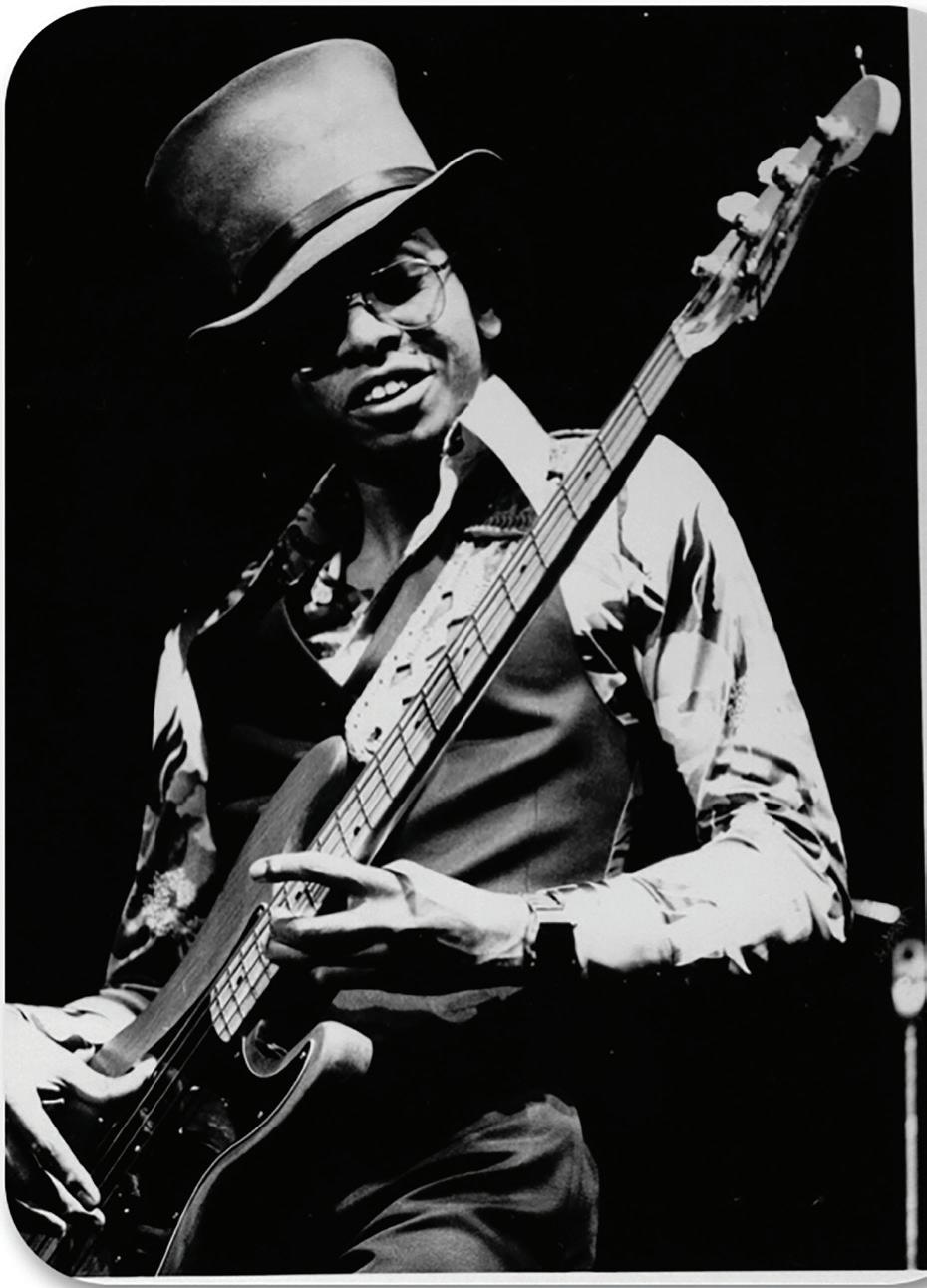
I loved the feel of the electric bass, and I loved to play what I always thought the bass player should have been playing back then—Latin-inspired riff lines, which is basically funky stuff, and I reasoned, …only four strings, and you only have to carry one instrument. 3
She quickly attracted a steady stream of recording gigs on bass, working with top level producers such as Phil Spector and Quincy Jones:
I didn’t mean to put some bassists out of work, but that’s what happened. I had three kids to take care of—alone —so I went for it. I saw the eventual popularity and role of the electric bass and had been hating myself for playing rock and roll on guitar, an instrument I loved to play. But I had to learn a great sense of timing a lot better—that’s the key to making a band groove, and it was more fun to record on electric bass than on guitar.4
Through her work with Spector, Kaye met the Beach Boys’ Brian Wilson. His compositions had become sufficiently complex that he was recruiting session musicians to record in place of his Beach Boys band members. And so it was that Carol Kaye played bass on the

seminal album Pet Sounds (1966) including the hits “Wouldn’t It Be Nice” and “God Only Knows”, as well as their biggest hit of all released later that year, “Good Vibrations”.
Other worldwide hits featuring Kaye on bass include “These Boots Are Made For Walking” by Nancy Sinatra (1966), “Homeward Bound” by Simon & Garfunkel (1966), “Wichita Lineman” by Glen Campbell (1968) and “The Way We Were” by Barbara Streisand (1973).
Kaye also recorded sound tracks for movies and television, including the theme songs for M.A.S.H., The Addams Family, Hawaii Five-O and The Brady Bunch.
There is a funny video where Kaye is interviewed by Kiss’s bass player Gene Simmons, and she tries to teach him a riff, which he struggles to get. Search YouTube for “Carol Kaye II Gene Simmons”.
I will freely admit I am a fully-fledged Bowie tragic. One thing that has always fascinated me about Bowie’s long career was his determination to
The NSW Bar News has never featured a music column, and certainly not one as self-indulgent as the one you are reading now.
keep changing direction, reinventing himself and exploring new genres. His insatiable quest for new sounds included a constant turnover of band-members. Like a ruthless footy coach, as soon as he conquered the world as Ziggy Stardust, he broke up the band and looked for fresh new players who would deliver his next victory. Even guitarist Mick Ronson, who provided the guts of countless classics spanning from “Space Oddity” (1969) to “Ziggy Stardust” (1972) and “The Jean Genie” (1973), was eventually discarded.
Looking back on it all, the band members that survived for more than one or two albums are rare anomalies, including Ronson himself. Another of those anomalies was George Murray who played bass with Bowie from 1976 to 1980.
Murray’s tenure with Bowie was truly a journey, both musically and geographically. Murray grew up in the Bronx, NYC. He played in Broadway musicals and found
himself in the midst of the early ‘70s disco explosion—one of the last tracks he recorded before joining Bowie was the number 1 US hit “Rock Your Baby” with George McCrae and members of KC and the Sunshine Band, with whom he toured Europe and South America.
Murray’s first album with Bowie was Station to Station, recorded in Los Angeles in 1975. Murray formed part of what became known as the “DAM Trio” rhythm section, joining Dennis Davis on drums and Carlos Alomar on guitar. By this time, Bowie had long ditched his British glam-rock sound and had been based in the US, immersing himself in American music. His new heavy-hitting rhythm section, steeped in American RnB, funk and soul, would provide the bedrock for exploring various new directions, starting with the soulful hit “Golden Years”. Alomar explained the way they worked:
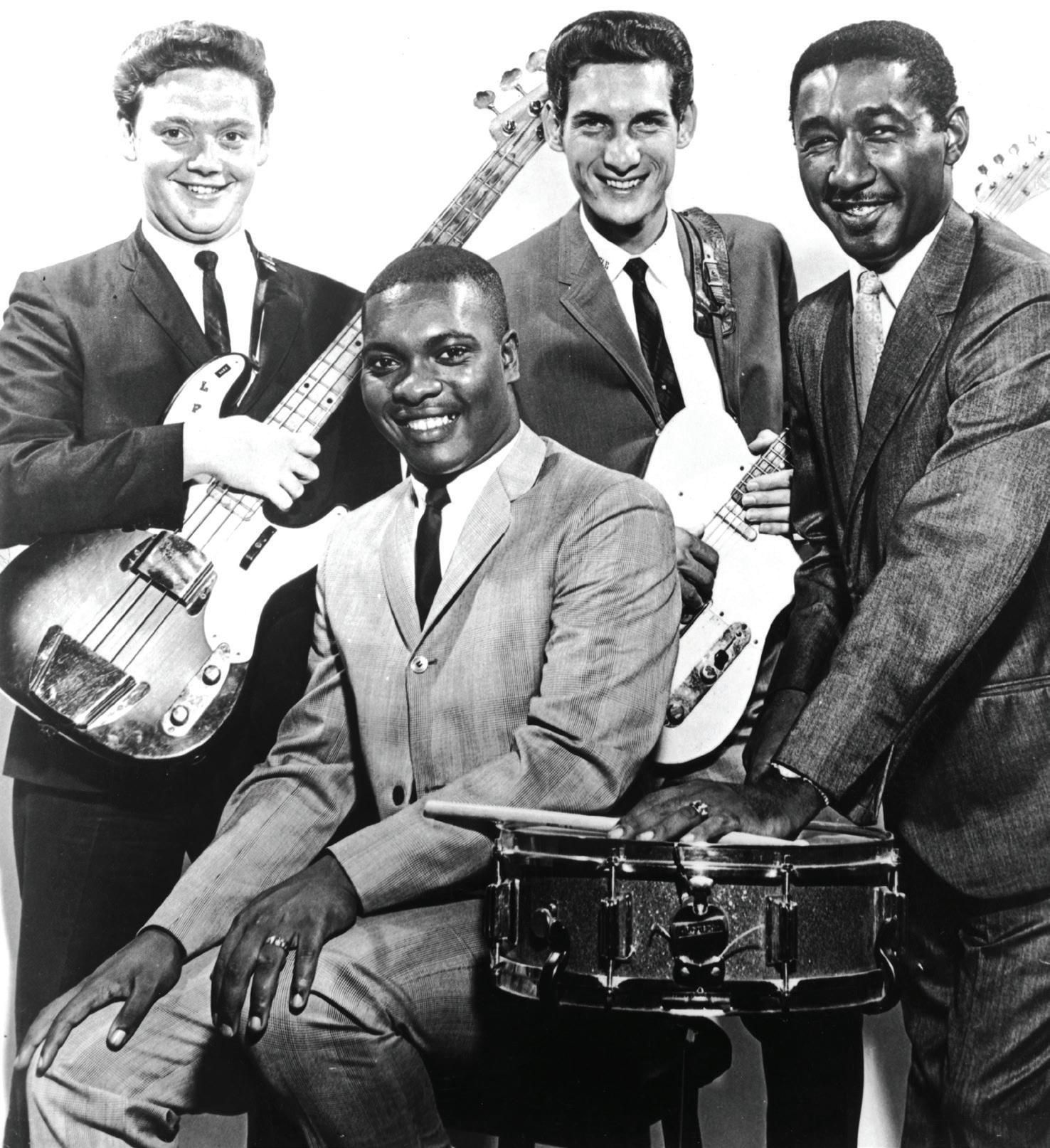
The uniqueness of the DAM Trio was that Bowie allowed us to work the arrangements with just the Trio. Everyone else would over-dub. To that end, the sky was the limit…no idea was out of bounds. We could do 4/4 beats and then insert a 3/4 beat (e.g. “Station to Station”). We could play a song in cut time and then double time the chorus (e.g. “Up the Hill Backwards”). Whatever arrangement was suggested The DAM Trio could execute in two minutes. Bowie was never happier. 5
Needing a fresh direction, Bowie uprooted his newly assembled American band and dropped them into an entirely new environment: West Berlin. Bowie was also escaping other demons in LA:
That was my first attempt to kick cocaine, so that was an awful lot of pain. And I moved to Berlin to do it. I moved out of the coke centre of the world into the smack centre of the
world. Thankfully, I didn’t have a feeling for smack, so it wasn’t a threat. 6
In Berlin, Bowie’s band embarked on a deeply experimental period. Working under the guidance of master producer Tony Visconti, Bowie brought in such diversely creative pioneers as Brian Eno and Iggy Pop, and exposed his American rhythm section to emerging giants of German electronica such as Kraftwerk, Neu! and Tangerine Dream. This resulted in Bowie’s “Berlin Trilogy”: three albums regarded by many (myself included) as his finest work: Low (1977), Heroes (1977) and Lodger (1979).
Everyone has heard the hit song “Heroes”, but it repays a careful relistening as there is so much going on. The BBC did a fabulous interview with producer Tony Visconti replaying the original recording tapes instrument by instrument—search on YouTube for: “Breaking down David Bowie’s ‘Heroes’”. Amongst other things buried in the mix is
Bowie smashing a beat with a stick on a random metal tape cannister, when they could not find a cowbell. And anchoring the whole show is Murray’s smooth but driving bass line.
Lodger features three of my personal favourite ever Bowie songs.
“Look Back in Anger” is entirely built on Murray’s fast and edgy bass riff, and he goes right off the rails injecting a generous dose of punk into parts of “Red Sails” and “Boys Keep Swinging”.
Murray’s last album with Bowie was “Scary Monsters” (1980). In hindsight, it seems that he was let off the leash for a last hurrah to throw down some proper funk slap basslines for the big hits “Fashion” and “Ashes to Ashes” (which reunited us with our long-lost friend Major Tom from “Space Oddity”).
And so the ride came to an end for Murray and the DAM Trio rhythm section as Bowie (true to form) sacked his entire band and embarked on his next unashamedly commercial chapter, chasing number one hits on Let’s Dance (1983) working with the likes of Nile Rodgers and Stevie Ray Vaughan.
As far as I can tell, Murray had little professional career of note thereafter. As of 2017 he was living in California with his wife and son and working at a school district. Perhaps he was ready for a quieter life.
If you have heard of Donald “Duck” Dunn, it is most likely for his role in The Blues Brothers movie. Some band members could act a bit and got a few lines, others could not and only got one. Dunn was in the latter category, and his single line, when asked what key the band should play “Rawhide” to placate a hostile crowd of bottle-throwing rednecks, was: “A; good country key.” Even if you’ve seen it before it’s worth another look: search YouTube
for “ The Blues Brothers (1980)— Rawhide Scene (5/9)”.
Encountering that movie as a teenager in the 1980s, I did not then appreciate the sheer historical magnitude of the numerous cameo appearances; a veritable pantheon of blues, soul and funk deities including Aretha Franklin, James Brown, Ray Charles, Cab Calloway, and John Lee Hooker. And I also worked out much later that the Blues Brothers backing band was similarly stacked with storied legends. The rhythm section was effectively lifted from the legendary Booker T and the MGs, which had a string of instrumental hits in the 1960s including “Green Onions” and “Time is Tight”.
Booker T and the MGs in turn formed the house band of Stax Records, the Memphis based studio which spearheaded the Southern Soul movement through the 1960s and early 1970s. In those years, Memphis, Tennessee, was still racially segregated, and was the scene of significant struggles in the civil rights movement, including the assassination of Martin Luther King Jr in 1968. In that environment, Stax Records and its interracial roster of musicians provided a beacon of hope for a desegregated future.
Through those years, Dunn and his bandmates provided backing for countless soul legends including Wilson Picket, Otis Redding, Sam and Dave, and a young Isaac Hayes, who began his career at Stax as a session keyboard player, before becoming a solo star in the early 1970s (and much later the voice of “Chef” in South Park).
In later years, Booker T & the MGs served as the backing band at various times for Bob Dylan, Stevie Wonder, Johnny Cash, Eric Clapton and Neil Young. Through the 1980s Dunn played for a wide range of artists, including Stevie Nicks and Tom Petty on their joint hit “Stop Dragging My Heart Around”.
Dunn died in 2012, while on tour in Tokyo with his old MGs bandmate Steve Cropper.
Western Australia’s greatest ever rockstar, Bon Scott,7 rests in peace at Fremantle Cemetery. Another lesser known but notable resident of Fremantle, still alive and well, is Martyn P Casey.
From 1982 to 1989 Casey played in the seminal Aussie indie band The Triffids. That’s him hitting the opening bassline on the classic track “Wide Open Road”—a quintessential Australian song if there ever was, if not the whole album Born Sandy Devotional (1985). Sadly, The Triffids’ star waned with the gradual decline in health of their lead singer and creative force David McComb, and they split in 1989. Then this happened in 1990:
I was back in Perth—and I’ve told this story a million times—I was working at a petrol station, pumping gas, checking the oil and tyres—like the Chuck Berry song “Too Much Monkey Business”—and I got a call from Mick Harvey, he was playing bass in the Bad Seeds but they’d just done The Good Son album, which required a lot of extra instruments that Mick wanted to do— xylophones and extra keyboards and what have you. So I ended up joining and next thing I knew I was in Berlin with The Bad Seeds.8
Casey remains a Bad Seed to this day. Indeed, there has been much turnover in personnel since the band was formed in 1984, and Casey’s 32-year tenure is exceeded only by Cave himself.
Over that time, for personal and creative reasons, Cave has been domiciled in Berlin, São Paulo, Brighton (UK) and most recently Los Angeles. Yet Casey has remained throughout a steadfast resident of Fremantle, jetting around the world when required for recording and tours.
Casey has played on 11 Bad Seeds albums, from Henry’s Dream (1992)
to Ghosteen (2019). His work includes the rollicking bassline underpinning “Red Right Hand” (1994) which is on high rotation these days as the opening theme song of the hit UK crime TV series Peaky Blinders 9 His rolling arpeggios also set the scene for the emotional “Into My Arms” (1997), which Cave performed that year at the funeral of his old friend Michael Hutchence.
Cave described Casey’s contribution to the Bad Seeds as follows:
There is an alchemical combination of tone and touch and heart that is unique to Marty—a sound that goes way-down deep, soul-deep— that collects all the crazy shit that happens around him in its effortless, unadorned power and turns it into gold. Marty is the master!10
And it should not go unnoticed that Casey has complied at all times with the Bad Seeds’ strict dress code. The unspoken rule requires all band members to dress like an 1880s Wild West funeral director, or vaudevillian magician, or both. I suspect he is somewhat relieved to slip on some comfy shorts and thongs when relaxing off duty in Freo.
Did we expect to see Fremantle equated with Detroit, Memphis, LA and the Bronx? A suburb that has produced not only Bon Scott but also Tame Impala and the Hoodoo Gurus certainly punches above its weight. And who is the GOAT? Obviously I have a soft spot for George Murray for his work with Bowie, and the story of James Jamerson has a tragic touch of van Gogh, his enormous body of brilliant work going largely unappreciated until after his death. But for sheer longevity and diversity of classic hits, it is hard to go past Carol Kaye. In her own words:11
I was raised by musician-parents and just sort of grew up around music, we were poor, but when music was played,

you had a sparkle in your life. And the sparkle is still there years later after all the recording we did, for when you turn on the radio, there are all my fellow musicians. I grew fond of so many, we were all in it together, pulling together for a hit, and loved to groove together. The looks, the feel of the music, the inside quick joke, it was a warm feeling.
1 Full disclosure: the author is also a bass player you have probably never heard of.
2 Musician magazine, 1983.
3 Vintage Guitar magazine.
4 Ibid.
5 The Official Carlos Alomar Blog, 25 April 2016.
6 David Bowie, Details magazine September 1991.
7 Surely I do not need to explain Bon Scott was the original lead singer of AC/DC.
8 Xpressmag.com.au
9 I was briefly intrigued to learn that Snoop Dogg had recorded a version of Red Right Hand. It’s shite, don’t bother.
10 Xpressmag.com.au
11 Carolkaye.com
CHARLES SHAW
This elemental book, by a prominent lawyer and an eminent Australian poet, is essential reading for all lawyers. It is described as a response to a decline in thinking and language around the world. In the preface, the authors say that they have written the book for anyone who wants to be able to think clearly and to speak and write well.
Lawyers, and particularly barristers, would naturally benefit from such a book. This book is readable and entertaining and contains advice about the need for rigid logic in their writing and clarity of expression. The first half of the book is entitled “How to Think”. It sets out basic rules of logic as well as common failures of logic that are observed in modern times. No formal learning in logic or philosophy is needed to understand this part of the book, which draws on such brilliant minds as Charles Dickens, Charles Darwin, Russell Drysdale, Bertrand Russell, Oliver Wendell Holmes and John Stuart Mill.
It explains the importance of clarity, the distinction between fact and opinion, the difference between inductive and deductive reasoning, the notion of the syllogism and the reductio ad absurdum (which, in the modern way, eschews the use of the Latin).
This part of the book also sets out common modern errors of logic, such as the effect of
prejudice, the use of wishful thinking and slogans and jargon and the problems of dogma and labelling.
Understanding of these notions is essential for a good lawyer in providing advice and making written and oral submissions. It is presented here in a highly entertaining and readable way with homely and familiar examples to illustrate the issues. It is an extremely accessible way of learning or reminding one of these important principles and potential pitfalls.
The second half of the book is entitled “How to Write and Speak.” It is an elegantly written section that explains the history of the English language and then tells us how to best use the language. The book argues for simple and transparent prose and explains the importance of punctuation to clarity of language.
Rules of grammar are explained simply and clearly and guidance in the use of language is set out from several pre-eminent sources such as
The author is a silk practising at the NSW Bar, who somehow finds the time to pen novels. The Cutting is his second published novel.
The Cutting revolves around three main characters: Lance Alcock, bachelor and heir to a mining and farming fortune; Will Fullbright, an engineer employed at one of Alcock’s mine sites, who has addiction issues; and Justine Jamison, Will’s girlfriend and director of a refugee advocacy group.
Other minor characters, including Will’s mother, play important roles in the ultimate denouement to the book (no spoilers!).
This is a book that should be read by all practising lawyers and should then sit on their shelves with the Oxford English Dictionary.
Fowler’s Modern English Usage, The Economist Style Guide, The New York Times Guide for Letters to the Editor and Sir Ernest Gowers’ Complete Plain Words. The book contains a useful and entertaining watchlist of doubtful terms and ends with problems in writing and speaking which typically affect professional people.
This is a book that should be read by all practising lawyers and should then sit on their shelves with the Oxford English Dictionary, Fowler’s and Brewer’s. It is a timely reminder of how we should prepare our advice and submissions, both as a matter
of logic and expression. How we, as lawyers, express ourselves, both as a matter of logical reasoning and style, is of critical importance. We will all benefit from the guidance provided by a very experienced lawyer and a poet contained in this book.
What’s Wrong? Making Sense of Nonsense by Geoffrey Gibson and Chris Wallace-Crabbe 184pp
Hardie Grant Books 2022
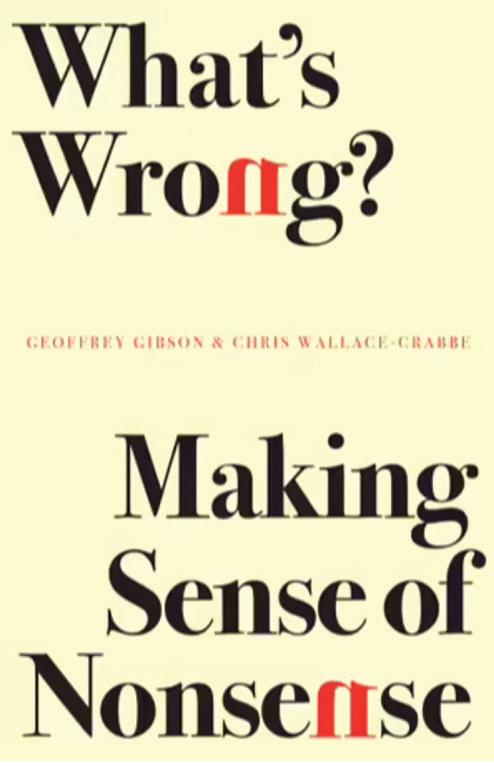
Will works at the mine on a fly infly out basis. Will then loses his job fairly early on in the book as the mine is placed into administration when overseas investors withdraw finance.
He is forced to return to Sydney to live.
Will’s return to Sydney is predictably rocky.
Meanwhile Justine must wrestle with her own conscience as to her professional and personal relationship with Lance.
The book touches on several topical issues in Australian life: the stress of fly in-fly out work on relationships, the plight of refugees, particularly those on Nauru, underpayment of franchise employees on working visas and ice addiction.
I will not reveal the ending, other than to say I was more shocked at the characters’ response to it than the actual incident itself.
I found I did not warm to any of the characters and in fact found them to be fairly one dimensional. Upon reflection, I wondered whether this was a deliberate ploy of the author to demonstrate the state of the modern Australian psyche, or maybe I am just reading too much into it.
The Cutting by Richard McHugh 320pp
Viking/Penguin Random House 2022
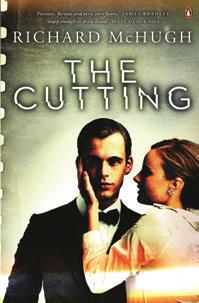

Once you retire, you walk more slowly
There’s no rush no one to compete with no deadline save for closing time at the local like rain on the footpath after the summer sun comes out, stress evaporates
Admit it
You once despised retirees (now, you are one)
You once despised those who went on cruises (now, you are cruising)
Aboard the Coral Princess you skirt the east coast
The pencil-sketch mountain range to the west merges with grey-purple cloud cover
The swell replicates miniature mountains without number The ship splits the sea, generating a succession of lateral waves, starboard and port
The Tasman: a bottomless ink-well
Fifteen hundred passengers
Fifteen hundred lives
Fifteen hundred stories all just trying to find their sea legs.
COVID-19: the unnamed stowaway.

The pilot shaves the starboard side of the Coral Princess, shins up a ladder, shepherds her bigger sister towards the pier a man from a six-column platform throws a looped rope around a big brass knuckle the ship docks more ropes tether the ship passengers await the announcement to disembark
In port the ship dominates the fishing fleet
Disembarked, passengers wend their way up the hill they hug Imlay Street where they pause for an espresso or a piccolo
At the top of the hill the beach track drops to Aslings Beach insinuates its way around the ancient geology under a stratified now white, now pink rock whale-hump formation there is a man-made rock pool into which, through horizontal slits in the concrete walls, the tidal waters enter at the approach of the interloper a crab the size of a coffee-cup saucer slips inside a crack
Swimmers enter the winter water, letting the vital element claim them, body and soul the rock pool floor is shot through with crab mounds above which the swimmers’ feet kick through goggles you can see the composition of the water, the ocean floor, the world upside down, down, down once the swimmers leave, the crab comes out to play
Olde Eden (free lemons in a bucket) new Eden (sold to the highest bidder) new Eden trying to be olde Eden (sold to the super rich)
Eden’s weatherboard court house resembles a navy captain’s quarters raising a doubt within is a fragile barque passers-by interrogate themselves: has a silk ever crossed the threshold of the court room?
Charcoal clouds rain on fifteen hundred passengers cutting short their Sunday outing they return to the floating womb in time for tea.
COVID-19 constrains fifteen hundred passengers to don a mask.
Bagpipes play on Imlay Street
not so much a sound as the memory of one no siren song is audible midship
By-pass the Blue Jade Quartet
By-pass Scratch Card special By-pass GoSmile Teeth Whitening Consultation
By-pass Guess the Weight and Win By-pass Bible Study
By-pass Let’s Get Quizzical
By-pass Cruise Control
Outside the Wheelhouse bar, the overweight, the over fed, the superannuated, the pensioned-off navy of ex-workers shuffle, waddle or inch their way along the corridor in a promenade that never ends
Deck quoits, table tennis, beginners’ Japanese and falling asleep in the Churchill room are the order of the day.
Under the stairs on deck 5, a hundred folded wheelchairs await their turn to carry the mobility-impaired.
In the Bordeaux room, the women come and go, speaking of COVID-19, down below.
Come through the heads a while
Watch the surf smash the base of the cliff face
Dark as the obfuscation of an octopus, the harbour receives your vessel
Not yet six in the morning, the bridge’s brooding symmetry stops you in your tracks
The Opera house recalls a collection of outstretched geisha fans
Between breakfasts you head to the Botanic Garden, welcomed by hairy Casuarinas
A Bermuda cedar bares its cross-sectioned soul
In Foveaux Street, a mural of Adam Goodes reminds you who was here first
The Rabbitohs carry out training drills at Redfern oval before a man in distress
Will it take a lifetime of high tides to bind you to one stolen memory of the Winga?
There is more art in a six year old’s watercolour pencil and paint on paper than in the entire Louvre
The harbour has seen it all before, knows those who skim its surface, swallows those weighed down by venial sins
The Rocks’ exposed sandstone cuttings which bleed water, the harbour, the bridge and the Opera house solicit your eternal return
Unless, that is, you were thinking of emigrating to Venice.
Novocastrians photograph passengers on a cruise ship who photograph Novocastrians
Photograph first. Feel later. Via your photographs. So too when a meal is served. Feed Instagram or Facebook before you feed yourself.
A pelican floats on the macchiato-coloured water of the port.
Blue-collar Newcastle gives way to blue-chip investors, restorers, who park V-10 Audi sports cars in their driveway
Tradespeople have the last laugh
The Pacific has a brown bilge tinge in the curl of its waves which pound the tables of sandstone rock on the shore
An inert Blue-tongue lizard, eyes closed, its scales a sun magnet, lies on the side of the beach track
The Newcastle beach streetscape, with its rolled-up volleyball nets, looks like a bastard child of Marseille’s corniche and Bondi Beach
A three-year-old boy on a wooden bike with no pedals overtakes his mother who walks a pram
The post office is under restoration, the sea baths are being restored, the university ranks in the top two hundred, the Hunter Street ghost mall is depleted by a COVID-19-led assault, the old-timers talk the town up, governments cut cheques courtesy of regional politics, welcome back dear cruise ships, welcome back fifteen hundred tourists but just before you leave terra firma do you really think you have a clue about how we live because you caught a bus into town, spent a few bob and caught a bus back to re-embark?
Sure, we’ll get the police to relocate the homeless for the duration of your visit, play the bagpipes to give you a bonny send-off and fire three blank cannon balls from the fort to make you feel good as the love boat leaves our port.
But do you really have any idea of who we are, how we live or what we really think of the Indigenous peoples whom we displaced from the top of Cooks Hill?
I, age 35, have been on thirty-five cruises. I love it. I, age 75, have been on seventy-five cruises. I still love it. I, age 95, have been on ninety-five cruises. I will always love it.
To the east, the incipient pink horizon is streaked with spaghetti-stick rain.
The clouds’ folds conceal a phantom ship, scheduled to cruise for all time.
Alone, my lungs filled with salt air, my sea legs but a memory, I walk, sand between my toes, in the flat-battery sun of an August sunset. After months of stagnation, the lagoon is becoming tidal again. A pelican, having flown from Newcastle, drifts along its surface. The ducks of Ayr Creek form a V-line as they part the still water whose stench sits above the stale expanse. At the edge of the lagoon, a grey crane stands on a rock. As a ripple appears, its beak spikes the water. Hooded plovers dart across the sand. The pine trees along the shore now in silhouette, I cross the creek bridge.
The coast veers left. I veer right. One swing of a squeaky gate: I’m home.









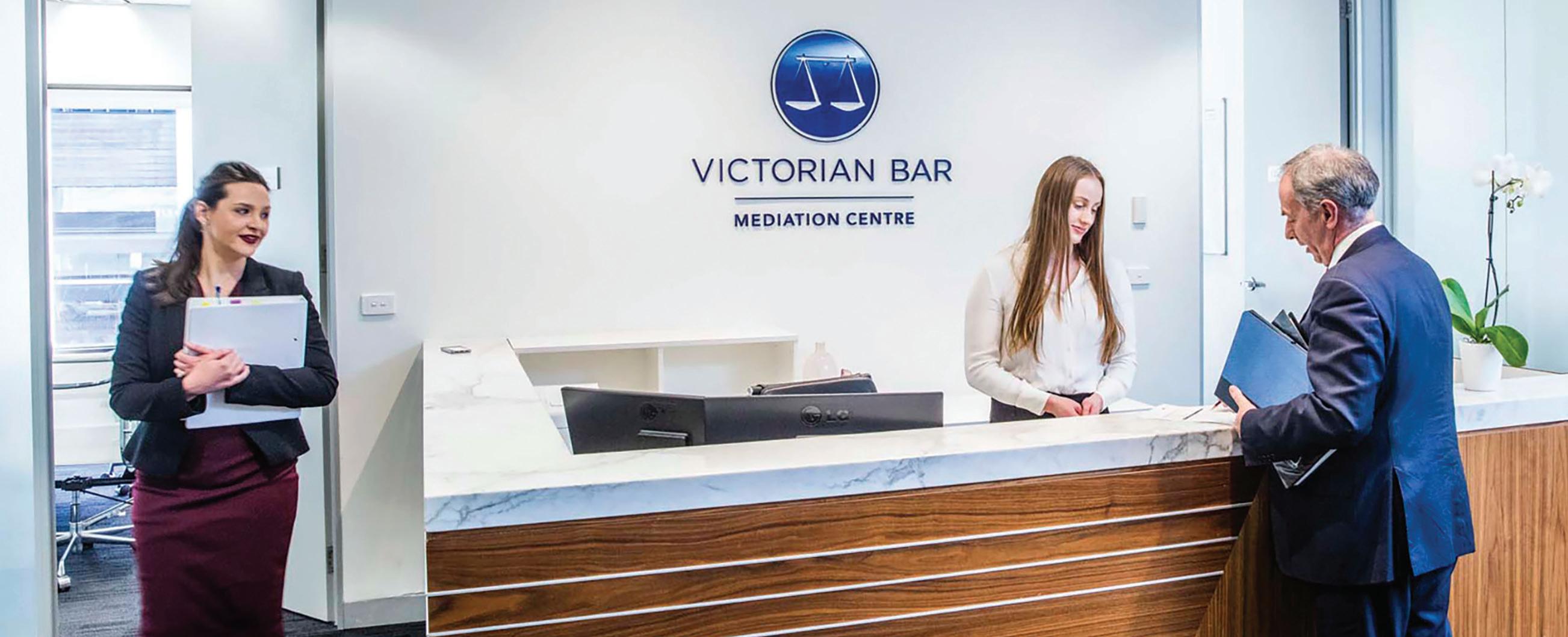

Purpose-built mediation and conference rooms in the heart of Melbourne’s legal precinct.
The Victorian Bar knows how important the mediation process is. We’ve put our experience and knowledge into creating the right space to support parties through mediation.


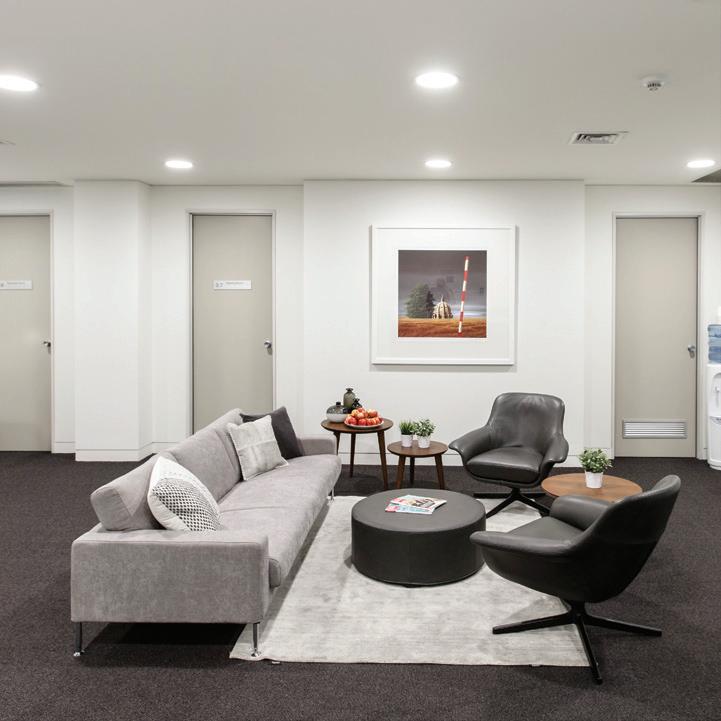
• Modern neutral decor with abundant natural light
• Business room and printing facilities
• Reception and administration services
• Fully equipped kitchen with tea & coffee making facilities
• After hours operation available
• Video and teleconferencing facilities
• Central location within Melbourne’s legal and business precinct
• Secure free Wi-Fi